assortative mating
description: the tendency of individuals to mate with those who have similar traits
70 results
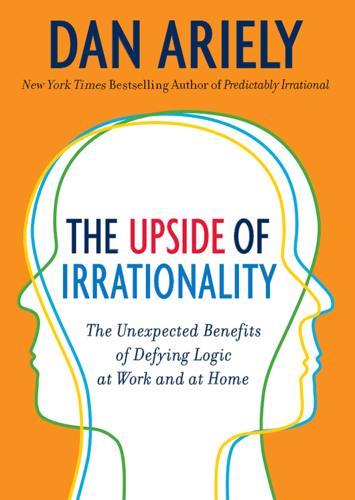
The Upside of Irrationality: The Unexpected Benefits of Defying Logic at Work and at Home
by
Dan Ariely
Published 31 May 2010
While we can all think of examples of bold, talented, rich, or powerful yet aesthetically challenged men coupled with beautiful women (think of Woody Allen and Mia Farrow, Lyle Lovett and Julia Roberts, or almost any British rock star and his model/actress wife), assortative mating is generally a good description of the way people tend to find their romantic partners. Of course, assortative mating is not just about beauty; money, power, and even attributes such as a sense of humor can make a person more or less desirable. Still, in our society, beauty, more than any other attribute, tends to define our place in the social hierarchy and our assortative mating potential. Assortative mating is good news for the men and women sitting on the top rung of the attractiveness ladder, but what does it mean for the majority of us on the middle or lower rungs?
…
A Accessory Transit Company, 154 acknowledging workers, 74–76, 80 acronyms, 120 adaptation, 157–90 assortative mating and, 191–212; see also assortative mating focusing attention on changes and, 159–60 hedonic, 160–84; see also hedonic adaptation nineteenth-century experiments on, 157–58 to pain, 160–67 physical, 157–60, 161n sensory perception and, 158–60 Aesop, 198–99 agriculture, obesity and technological developments in, 8 AIDS, 250, 251 airlines, customer service problems of, 142–43 alienation of labor, 79–80 American Cancer Society (ACS), 241–42, 249–50, 254 Andrade, Eduardo, 262, 265, 267–68, 299 anger, acting on, 257 author��s anecdote of, 258–61 driving and, 261 ultimatum game and, 268, 269–70, 273, 274, 276 animals: empathy for suffering of, 249 generalizing about human behavior from studies on, 63 working for food preferred by, 59–63 annoying experiences: breaking up, 177–79, 180 decisions far into future affected by, 262–64 annuities, 234 anterior insula, 266–67 anticipatory anxiety, 45 Anzio, Italy, battle of (1944), 167 apathy toward large tragedies, 238–39 drop-in-the-bucket effect and, 244–45, 252, 254–55 statistical condition and, 238–41, 242, 246, 247–49, 252–53 apologies, 149–51 for medical errors, 152 Apple, 120n battery replacement issue and, 141–42 art, homemade, 89–90 Asian tsunami, 250, 251 assembly line, 78–79 assortative mating, 191–212 altering aesthetic perception and (sour grapes theory), 198–99, 200, 201, 203 author’s injuries and, 191–96, 210–11 dinner party game and, 198 failure to adapt and, 200–201, 203–5 gender differences and, 209, 211 HOT or NOT study and, 201–5, 208, 211 reconsidering rank of attributes and, 199–200, 201, 205–10 speed-dating experiment and, 205–10 Atchison, Shane, 140–41, 146 attachment: to one’s own ideas, see Not-Invented-Here (NIH) bias to self-made goods, see IKEA effect attractiveness, assortative mating and, 191–212 see also assortative mating auctions, first-price vs. second-price, 98–99 Audi customer service, author’s experience with, 131–36, 137, 149, 153–54 experimental situation analogous to, 135–39 fictional case study for Harvard Business Review based on, 147–49 B bailout, public outrage felt in response to, 128–31 baking mixes, instant, 85–87 bankers: author’s presentation of research findings to, 107–9, 121 bonus experiments and, 38–41, 51 Frank’s address to, 41 public outrage in response to bailout and, 128–31 bankruptcy, 129, 130 Barkan, Racheli, 39, 109–10, 299 basketball, clutch players in, 39–41 beauty: assortative mating and, 196–212; see also assortative mating general agreement on standard of, 203 Becker-DeGroot-Marschak procedure, 91 Beecher, Henry, 167 behavioral economics: goal of, 9–10 human rationality not assumed in, 6–7 revenge as metaphor for, 124n Betty Crocker, 87 Bible, Gideon’s conversation with God in, 288–89 blindness, adaptation to, 172–74 blogging, 65 Blunder (Shore), 117 boiling-frog experiment, 157–58 bonuses, 17–52 bank executives’ responses to research on, 37–39 clutch abilities and, 39–41 for cognitive vs. mechanical tasks, 33–36, 40–41 creativity improvements and, 47–48 experiments testing effectiveness of, 21–36, 44–46 Frank’s remarks on, 41 intuitions about, 36–37 inverse-U relationship between performance and, 20–21, 47 loss aversion and, 32–33 optimizing efficacy of, 51–52 public rage over, 21 rational economists’ view of, 36–37 social pressure and, 44–46 surgery situation and, 48–49 viewed as standard part of compensation, 33 in wake of financial meltdown of 2008, 131 brain: judgments about experiences and, 228–29 punishment and, 126 breaks, in pleasant vs. painful experiences, 177–81 Brickman, Philip, 170 business, experimental approach to, 292–93 C cake mixes, instant, 85–87 California, moving to, 176 Call, Josep, 127 cancer, American Cancer Society fundraising and, 241–42, 249–50, 254 canoeing, romantic relationships and, 278–79 cars, 215–16 designing one’s own, 88, 89 division of labor in manufacture of, 78–79 in early days of automotive industry, 94 hedonic treadmill and, 175 see also driving cell phones, 7 in experiments on customer revenge, 135–39, 145–46, 150–51 see also texting CEOs, very high salaries and bonuses paid to, 21 Chance, Zoë, 220, 300 changes: ability to focus attention on, 159–60 decisions about life’s path and, 287 in future, foreseeing adaptation to, 160, 171–74 status quo bias and, 285, 286 in workers’ pay, job satisfaction and, 169–70 charities: American Cancer Society (ACS), 241–42, 249–50, 254 calculating vs. emotional priming and, 246–48 emotional appeals and, 240–42, 248–50, 253–54, 256 identifiable victim effect and, 239–42, 248, 256 charities (cont.)
…
As I analyzed the situation over and over, my personal concerns soon developed into a more generalized interest in the romantic dance. Assortative Mating and Adaptation You don’t need to be an astute observer of human nature to realize that, in the world of birds, bees, and humans, like attracts like. To a large degree, beautiful people date other beautiful people, and “aesthetically challenged”* individuals date others like them. Social scientists have studied this birds-of-a-feather phenomenon for a long time and given it the name “assortative mating.” While we can all think of examples of bold, talented, rich, or powerful yet aesthetically challenged men coupled with beautiful women (think of Woody Allen and Mia Farrow, Lyle Lovett and Julia Roberts, or almost any British rock star and his model/actress wife), assortative mating is generally a good description of the way people tend to find their romantic partners.
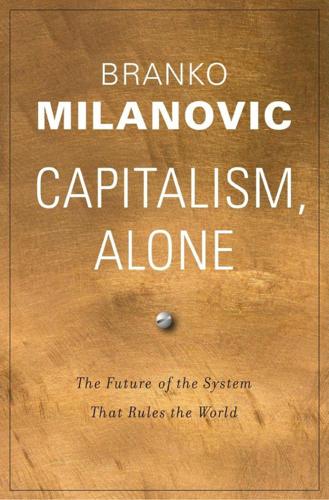
Capitalism, Alone: The Future of the System That Rules the World
by
Branko Milanovic
Published 23 Sep 2019
It is also possible (although it is entirely speculative) that people’s preferences have changed, and that both men and women now prefer to be in a union with someone who is similar to them. Whatever the reasons for it, increasing homogamy is yet another factor that will push income inequality up. However, it will only push inequality up during the period of transition from nonassortative mating (or assortative mating with nonparticipation of wives in the labor force) to assortative mating. Once assortative mating and labor force participation rates have reached their limits, the inequality-enhancing effect disappears. Inequality stabilizes, albeit at a high level. Intergenerational transmission of inequality The final characteristic of capitalism that we will examine is the transmission of acquired advantages, notably wealth and “human capital,” across generations, often measured by the correlation between parents’ and children’s incomes (Table 2.1, row 6).
…
Consider two men, one who earns 50 units and another 100, and two women, one earning 10 units and the other 20. Now, suppose that there is some assortative mating (also called homogamy), that is, a positive correlation between husbands’ and wives’ earnings: thus the man with earnings of 100 marries the woman with earnings of 20, and the poorer man marries the poorer woman. But then assume that the rich wife drops out of the labor force (as in the 1950s), while in the other couple both continue to work. The ratio of the two family incomes will be 100 to 60. Now let the assortative mating remain the same, but both women (as today) stay in the labor force: the ratio of the two family incomes becomes 120 to 60, that is, inequality increases.
…
Now let the assortative mating remain the same, but both women (as today) stay in the labor force: the ratio of the two family incomes becomes 120 to 60, that is, inequality increases. The example shows that under conditions of assortative mating, inequality will go up if women’s participation in the workforce increases. It will go up even more if mating was previously random or disassortative (with richer men marrying poorer women). Some have argued that assortative mating has become much more common in liberal meritocratic capitalism because social norms have changed such that more women are highly educated (in fact, their graduation rates now exceed those of men), and many more work. It is also possible (although it is entirely speculative) that people’s preferences have changed, and that both men and women now prefer to be in a union with someone who is similar to them.
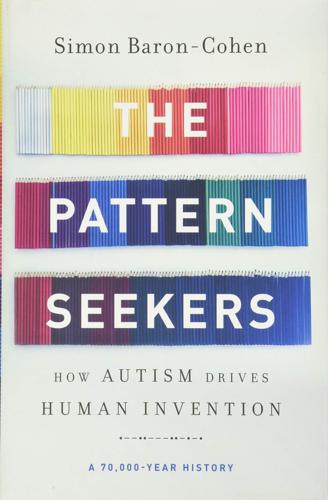
The Pattern Seekers: How Autism Drives Human Invention
by
Simon Baron-Cohen
Published 14 Aug 2020
Baron-Cohen (2006), “Two new theories of autism: Hyper-systemizing and assortative mating,” Archives of Diseases in Childhood 91, 2–5; S. Connolly et al. (2019), “Evidence of assortative mating in autism spectrum disorder,” Biological Psychiatry 86(4), 286–293; A. E. Nordsletten et al. (2016), “Patterns of nonrandom mating within and across 11 major psychiatric disorders,” JAMA Psychiatry 73(4), 354–361; J. Wouter et al. (2016), “Exploring boundaries for the genetic consequences of assortative mating for psychiatric traits,” JAMA Psychiatry 73(11), 1189–1195. 15. Assortative mating could also explain why parents of autistic children tend to be older than average—it has just taken them longer to find someone who will marry them.
…
I was intrigued by what makes two hyper-systemizers more likely to end up as a couple. “Like marrying like” is what biologists call “assortative mating.”13 Assortative mating is widespread in nature. For example, in humans, tall people are more likely to marry tall people, extraverts are more likely to marry extraverts, and alcoholics are more likely to marry alcoholics. Based on our Parents’ Occupations Study, it seemed that hyper-systemizers were more likely to marry hyper-systemizers. This fits the “assortative mating” theory of autism, which predicts that autism rates will be higher among hyper-systemizing couples’ children or grandchildren.
…
Johannesson (1994), “Sexual selection on female size in a marine snail, Littorina littorea (L.),” Journal of Experimental Marine Biology and Ecology 181, 145–157; A. Fargevieille et al. (2017), “Assortative mating by colored ornaments in blue tits: Space and time matter,” Ecology and Evolution 7(7), 2069–2078; G. Stulp et al. (2017), “Assortative mating for human height: A meta-analysis,” American Journal of Human Biology 29(1, January–February), e22917; K. Han, N. C. Weed, and J. N. Butcher (2003), “Butcher dyadic agreement on the MMPI-2,” Personality and Individual Differences 35, 603–615; and J. Glickson and H. Golan (2001), “Personality, cognitive style, and assortative mating,” Personality and Individual Differences 30, 1109–1209. 14.
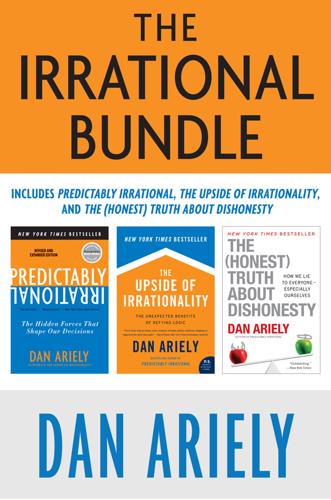
The Irrational Bundle
by
Dan Ariely
Published 3 Apr 2013
While we can all think of examples of bold, talented, rich, or powerful yet aesthetically challenged men coupled with beautiful women (think of Woody Allen and Mia Farrow, Lyle Lovett and Julia Roberts, or almost any British rock star and his model/actress wife), assortative mating is generally a good description of the way people tend to find their romantic partners. Of course, assortative mating is not just about beauty; money, power, and even attributes such as a sense of humor can make a person more or less desirable. Still, in our society, beauty, more than any other attribute, tends to define our place in the social hierarchy and our assortative mating potential. Assortative mating is good news for the men and women sitting on the top rung of the attractiveness ladder, but what does it mean for the majority of us on the middle or lower rungs?
…
A Accessory Transit Company, 154 acknowledging workers, 74–76, 80 acronyms, 120 adaptation, 157–90 assortative mating and, 191–212; see also assortative mating focusing attention on changes and, 159–60 hedonic, 160–84; see also hedonic adaptation nineteenth-century experiments on, 157–58 to pain, 160–67 physical, 157–60, 161n sensory perception and, 158–60 Aesop, 198–99 agriculture, obesity and technological developments in, 8 AIDS, 250, 251 airlines, customer service problems of, 142–43 alienation of labor, 79–80 American Cancer Society (ACS), 241–42, 249–50, 254 Andrade, Eduardo, 262, 265, 267–68, 299 anger, acting on, 257 author’s anecdote of, 258–61 driving and, 261 ultimatum game and, 268, 269–70, 273, 274, 276 animals: empathy for suffering of, 249 generalizing about human behavior from studies on, 63 working for food preferred by, 59–63 annoying experiences: breaking up, 177–79, 180 decisions far into future affected by, 262–64 annuities, 234 anterior insula, 266–67 anticipatory anxiety, 45 Anzio, Italy, battle of (1944), 167 apathy toward large tragedies, 238–39 drop-in-the-bucket effect and, 244–45, 252, 254–55 statistical condition and, 238–41, 242, 246, 247–49, 252–53 apologies, 149–51 for medical errors, 152 Apple, 120n battery replacement issue and, 141–42 art, homemade, 89–90 Asian tsunami, 250, 251 assembly line, 78–79 assortative mating, 191–212 altering aesthetic perception and (sour grapes theory), 198–99, 200, 201, 203 author’s injuries and, 191–96, 210–11 dinner party game and, 198 failure to adapt and, 200–201, 203–5 gender differences and, 209, 211 HOT or NOT study and, 201–5, 208, 211 reconsidering rank of attributes and, 199–200, 201, 205–10 speed-dating experiment and, 205–10 Atchison, Shane, 140–41, 146 attachment: to one’s own ideas, see Not-Invented-Here (NIH) bias to self-made goods, see IKEA effect attractiveness, assortative mating and, 191–212 see also assortative mating auctions, first-price vs. second-price, 98–99 Audi customer service, author’s experience with, 131–36, 137, 149, 153–54 experimental situation analogous to, 135–39 fictional case study for Harvard Business Review based on, 147–49 B bailout, public outrage felt in response to, 128–31 baking mixes, instant, 85–87 bankers: author’s presentation of research findings to, 107–9, 121 bonus experiments and, 38–41, 51 Frank’s address to, 41 public outrage in response to bailout and, 128–31 bankruptcy, 129, 130 Barkan, Racheli, 39, 109–10, 299 basketball, clutch players in, 39–41 beauty: assortative mating and, 196–212; see also assortative mating general agreement on standard of, 203 Becker-DeGroot-Marschak procedure, 91 Beecher, Henry, 167 behavioral economics: goal of, 9–10 human rationality not assumed in, 6–7 revenge as metaphor for, 124n Betty Crocker, 87 Bible, Gideon’s conversation with God in, 288–89 blindness, adaptation to, 172–74 blogging, 65 Blunder (Shore), 117 boiling-frog experiment, 157–58 bonuses, 17–52 bank executives’ responses to research on, 37–39 clutch abilities and, 39–41 for cognitive vs. mechanical tasks, 33–36, 40–41 creativity improvements and, 47–48 experiments testing effectiveness of, 21–36, 44–46 Frank’s remarks on, 41 intuitions about, 36–37 inverse-U relationship between performance and, 20–21, 47 loss aversion and, 32–33 optimizing efficacy of, 51–52 public rage over, 21 rational economists’ view of, 36–37 social pressure and, 44–46 surgery situation and, 48–49 viewed as standard part of compensation, 33 in wake of financial meltdown of 2008, 131 brain: judgments about experiences and, 228–29 punishment and, 126 breaks, in pleasant vs. painful experiences, 177–81 Brickman, Philip, 170 business, experimental approach to, 292–93 C cake mixes, instant, 85–87 California, moving to, 176 Call, Josep, 127 cancer, American Cancer Society fundraising and, 241–42, 249–50, 254 canoeing, romantic relationships and, 278–79 cars, 215–16 designing one’s own, 88, 89 division of labor in manufacture of, 78–79 in early days of automotive industry, 94 hedonic treadmill and, 175 see also driving cell phones, 7 in experiments on customer revenge, 135–39, 145–46, 150–51 see also texting CEOs, very high salaries and bonuses paid to, 21 Chance, Zoë, 220, 300 changes: ability to focus attention on, 159–60 decisions about life’s path and, 287 in future, foreseeing adaptation to, 160, 171–74 status quo bias and, 285, 286 in workers’ pay, job satisfaction and, 169–70 charities: American Cancer Society (ACS), 241–42, 249–50, 254 calculating vs. emotional priming and, 246–48 emotional appeals and, 240–42, 248–50, 253–54, 256 identifiable victim effect and, 239–42, 248, 256 charities (cont.)
…
As I analyzed the situation over and over, my personal concerns soon developed into a more generalized interest in the romantic dance. Assortative Mating and Adaptation You don’t need to be an astute observer of human nature to realize that, in the world of birds, bees, and humans, like attracts like. To a large degree, beautiful people date other beautiful people, and “aesthetically challenged”* individuals date others like them. Social scientists have studied this birds-of-a-feather phenomenon for a long time and given it the name “assortative mating.” While we can all think of examples of bold, talented, rich, or powerful yet aesthetically challenged men coupled with beautiful women (think of Woody Allen and Mia Farrow, Lyle Lovett and Julia Roberts, or almost any British rock star and his model/actress wife), assortative mating is generally a good description of the way people tend to find their romantic partners.
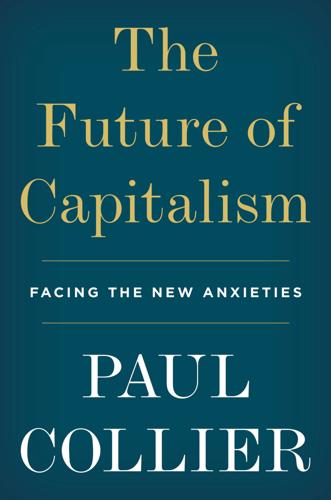
The Future of Capitalism: Facing the New Anxieties
by
Paul Collier
Published 4 Dec 2018
The greater porousness of the old upper class is symbolized by the marriage of Prince William to Kate Middleton, whose mother had been an airline stewardess: Kate would not have been invited to a debutante ball. But ‘assortative mating’ among the old upper class has been replaced by even more effective assortative mating among the new elite.21 Prince William and Kate met while studying at St Andrews, an elite university. Like-marrying-like is a powerful force for social inequality. Such assortative mating, a force that helps stabilize marriages, inadvertently widens class divisions, but there is little that can be done about it. But some behaviour is exploitative, and could potentially be curbed.
…
This was soon supplemented by the legalization of abortion, a second line of defence behind contraception. The previous norms of the middle-generation couple, of gender hierarchy and mutual obligations to the other generations, were replaced in most educated households by mutual encouragement to self-fulfilment through personal achievement.1 Cohabitation and assortative mating turned the educated into well-matched couples, and so divorce rates declined. High-achieving parents aspired to pass their success on to their offspring, and so the gender hierarchy that had reflected the gender imbalance in education gave way to mutual parental hothousing. When I was a child I got no help with homework: no parental coaching or monitoring; no private tutors.
…
Success stabilizes such families; their children inherit the success of the parents. These families are having it all: they are becoming dynasties. In many other families, the adults have little education, and the skills they laboriously acquired have lost their value. They too are more likely to marry people like themselves, but this is due to shrinking opportunities: assortative mating among the educated has left women with fewer chances of marrying upwards; men have retained the traditional norm of breadwinner but are no longer able to live up to it; and parents have retained the traditional norm of leaving education to the school. The mounting tensions of failure destabilize the family; children inherit the instabilities of their parents.
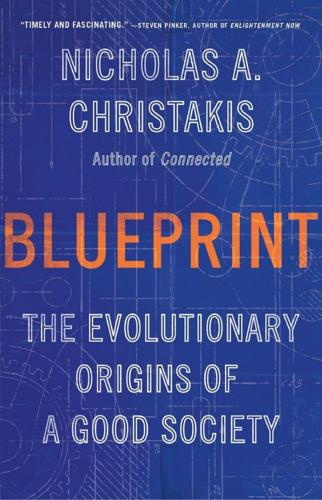
Blueprint: The Evolutionary Origins of a Good Society
by
Nicholas A. Christakis
Published 26 Mar 2019
We measured whether regions of the human genome that show a tendency to be similar across spouses have been evolving faster over the past thirty thousand years, as we would expect if assortative mating conferred fitness advantages. And we found that loci exhibiting even moderate assortativity among spousal pairs were evolving faster than loci exhibiting no assortative mating or those exhibiting disassortative mating. In other words, something about assortative mating may enhance the fitness of humans and thus increase the prevalence of the relevant gene variants. Our analysis showed that, overall, people in our sample chose partners from the population at large who were genetically equivalent to fourth cousins (even though their partners were not actually related to them).
…
Human spouses generally resemble each other in many respects, including attractiveness, health, religion, politics, and so on. Some of this similarity comes from the widely observed tendency of spouses to convert to each other’s religions or adopt their food tastes. But most of this similarity comes about due to homogamy, or the tendency of like to marry like in the first place, which is known as assortative mating. Assortative mating can occur for traits that are mutable (such as religion) or immutable (such as a person’s height or ethnicity).46 Confusingly, humans sometimes manifest a tendency toward the practice of “opposites attract” with respect to certain traits as well. A century ago, evolutionary biologists and statisticians Ronald A.
…
A. Christakis, and J. H. Fowler, “The Evolution of Homophily,” Scientific Reports 2 (2012): 845. 52. In this case, genotypic assortative mating might turn an otherwise neutral mutant genotype into a kind of “good gene.” However, finding a mate with a minor allele might be costly when the mutant allele is not common and especially when it is not initially advantageous. 53. Jones and Ratterman, “Mate Choice”; Y. Jiang, D. I. Bolnick, and M. Kirkpatrick, “Assortative Mating in Animals,” American Naturalist 181 (2013): E125–E138; Russell, Wells, and Rushton, “Evidence for Genetic Similarity.” 54. R.
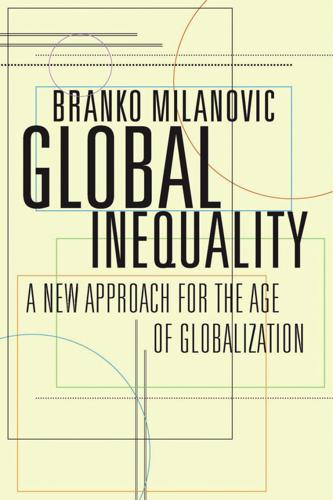
Global Inequality: A New Approach for the Age of Globalization
by
Branko Milanovic
Published 10 Apr 2016
But we cannot tell whether this wage-stretching was a result of skill-biased technological change or globalization (in the form of displacement of domestic labor by cheaper imports and outsourcing). Assortative mating and change in family structure (e.g., more young people deciding to live alone) explained another 22 percent of the change. Women’s increased participation in the labor force, however, reduced inequality by some 19 percent. In the end, about 40 percent of the increase in income inequality remained as a residual. (It is interesting to speculate whether the increased participation of women in the labor force is related to the rising importance of assortative mating, and whether the net effect of these two phenomena on income inequality may be close to zero [22 minus 19, in this case].)
…
These policies failed, however, to fully offset the increase in German market income inequality: disposable income inequality still went up, even if by only 1 to 2 Gini points. Some other factors have also been adduced as “culprits” for increased inequality. One of these concerns behavioral changes, such as the greater prevalence of assortative mating, or homogamy; marriages between partners who both have high skills and high incomes have become more common than they were in the 1950s and 1960s (Greenwood et al. 2014). Another suggested cause involves vaguely defined changes in ethical or pay norms, which allow for much wider gaps between the pay of top managers and average workers (Levy and Temin 2007; Piketty 2014, chap. 9).
…
In the 1960s, when relatively few women worked (the participation rate in the labor force for women in the United States was 40 percent, vs. more than 90 percent for men),25 it was common for well-off men to marry women who did not work outside the household and thus did not contribute a monetized income. This practice tends to diminish inequality, in comparison with a situation where highly paid men marry highly paid women. The latter has indeed been happening more often in the past quarter century. Greenwood et al. (2014) document the increasing trend of homogamy (assortative mating) among American couples and consider it one of the contributing factors to rising income inequality. It is paradoxical that increasing inequality has resulted from a change in social norms that has seen the labor participation rate of women almost catch up with that of men (73 percent for women, 84 percent for men in 2010) and has encouraged marriages that are based on a model of equal partnership between people with similarities of interests and backgrounds rather than a hierarchical model where the husband is the breadwinner and the wife a homemaker.
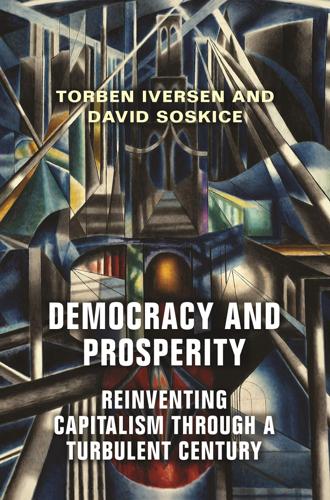
Democracy and Prosperity: Reinventing Capitalism Through a Turbulent Century
by
Torben Iversen
and
David Soskice
Published 5 Feb 2019
Thus, not only are companies and individuals embedded in skill clusters, but the embedding is reinforced by the cost to a relevantly skilled individual of leaving a cluster which “carries” his or her reputation. The same is true of companies. 5. Social networks: assortative mating and clusters of skill clusters. Skill clusters are themselves embedded within and across broader social networks of the highly educated; these seem of critical importance for our understanding of the knowledge economy, and big-city agglomeration. Meeting partners occurs often at university. Given the high lifetime income of graduates, assortative mating (being more likely to choose partners of the same educational background the higher the level of your education) has become a phenomenon of central importance as participation in higher education has risen.
…
Thus, partners, if they are following or likely to follow different careers, will want to settle in urban areas with wide enough skill clusters to accommodate both partners. The direct effect of assortative mating is thus that couples are likely to favor settling in cities with more skill clusters. This favors the growth of big cities. This dynamic is reinforced in two ways: first, going to university in a big city means less concern in choosing partners in any particular profession (or potential skill cluster). Second, equally important, and complementary to assortative mating, students tend to join together with friends and their partners in social networks; there seems good reason to believe that this constitutes a highly valuable resource subsequently in people’s careers in terms of contacts, new jobs, and perhaps career opportunities (as well as being central to satisfying human needs for friendship).
…
Second, equally important, and complementary to assortative mating, students tend to join together with friends and their partners in social networks; there seems good reason to believe that this constitutes a highly valuable resource subsequently in people’s careers in terms of contacts, new jobs, and perhaps career opportunities (as well as being central to satisfying human needs for friendship). Social networks, of any size and diversity, need large cities to provide the wide enough range of skill clusters. We can see how assortative mating and social network formation magnifies the inegalitarian effects of skill-biased technological change that economists have identified. By pairing people at similar skill levels and embedding them in complementary social groups, household income by education is becoming increasingly stratified. Assortative mating in the Fordist economy was less prevalent because careers tended to be highly gender segregated and stratified, and social networks were far less important for careers or as a source of insurance. 6.
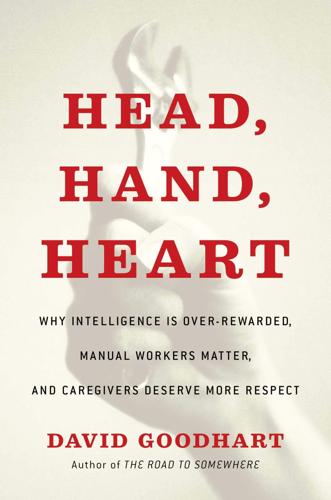
Head, Hand, Heart: Why Intelligence Is Over-Rewarded, Manual Workers Matter, and Caregivers Deserve More Respect
by
David Goodhart
Published 7 Sep 2020
Christopher Chabris, professor of psychology at Union College in New York State, estimates that a random person with above-average intelligence has a two-thirds chance of earning an above-average income, while a random person of below-average intelligence has only a one-third chance. So it seems that there is strong evidence that increased levels of cognitive selection into higher education and the higher professions has helped to shape a cognitive class over the past seventy years, reinforced by “assortative mating,” in which like increasingly attracts like in marriage and partnering. Bright men and women were attracted to each in the past, too, but fifty years ago there were far fewer women at elite universities or in higher professional jobs, so the very brightest were less likely to meet up. Male doctors often married female nurses and male businessmen often married female secretaries.
…
According to research by the think tank Institute for Public Policy Research, 39 percent of women born in 1958 married a partner in the same social class, rising to 56 percent for those born twenty years later.27 David Willetts, the former Conservative minister, argued in his book The Pinch: How the Baby Boomers Took Their Children’s Future—and Why They Should Give It Back that such assortative mating has contributed to a slowing of social mobility. “If advantage marries advantage then we must not be surprised if social mobility suffers… [I]ncreasing equality between the sexes has meant increasing inequality between social classes. Feminism has trumped egalitarianism.”28 Charles Murray returns to this theme in his more recent book Coming Apart: The State of White America, 1960–2010 (2012).
…
In Coming Apart, Murray estimates that there will always be 14 percent of children in the top 5 percent of the IQ distribution curve who are the offspring of parents with below-average IQs. Others argue for much higher levels of genetic shuffling. Regression to the mean—meaning clever parents will sometimes have average children—still operates even if it has been slowed somewhat by assortative mating and educational investment. Overall, the evidence for the emergence of a hereditary cognitive meritocracy remains tentative and is contested. For example, Andrew Hacker, a teacher of political science and math at Queens College in New York, writes: “We know that well-off and otherwise accomplished parents can give their children a good start, or at least try.
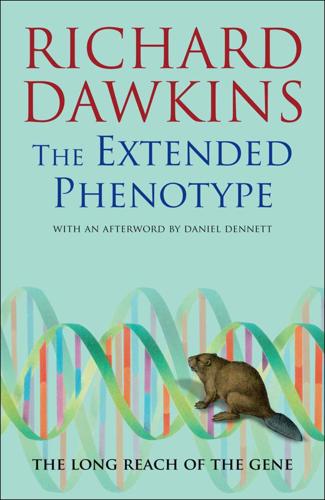
The Extended Phenotype: The Long Reach of the Gene
by
Richard Dawkins
Published 1 Jan 1982
Hamilton also noted the idea’s inherent implausibility, but he went on ‘… exactly the same a priori objections might be made to the evolution of assortative mating which manifestly has evolved, probably many times independently and despite its obscure advantages’ (Hamilton 1964b, p. 25). It is worth briefly examining this comparison with assortative mating, which for present purposes I shall take to mean the tendency of individuals to prefer to mate with individuals that genetically resemble them. Why is it that the green-beard effect seems so much more far-fetched than assortative mating? It is not just that assortative mating is positively known to occur. I suggest another reason.
…
aposematism The phenomenon whereby distasteful or dangerous organisms like wasps ‘warn’ enemies by bright colours or equivalent strong stimuli. These are presumed to work by making it easy for the enemies to learn to avoid them, but there are (not insuperable) theoretical difficulties over how the phenomenon might evolve in the first place. assortative mating The tendency of individuals to choose mates that resemble (positive assortative mating or homogamy) or specifically do not resemble (negative assortative mating) themselves. Some people use the word only in the positive sense. autosome A chromosome that is not one of the sex chromosomes. Baldwin/Waddington Effect First proposed by Spalding in 1873. A largely hypothetical evolutionary process (also called genetic assimilation) whereby natural selection can create an illusion of the inheritance of acquired characteristics.
…
The green-beard effect is not a mechanism for the recognition of kin. Rather, kin recognition and ‘green-beard’ recognition are alternative ways in which genes could behave as if discriminating in favour of copies of themselves. To return to Hamilton’s comparison with assortative mating, we can see that it does not really provide good grounds for optimism over the plausibility of the green-beard effect. Assortative mating is much more likely to involve self-inspection. If, for whatever reason, it is an advantage in general for like to mate with like, selection would favour an armpit type of behavioural rule: Inspect yourself, and choose a mate that resembles you.
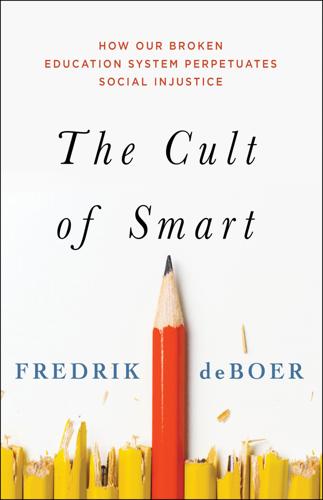
The Cult of Smart: How Our Broken Education System Perpetuates Social Injustice
by
Fredrik Deboer
Published 3 Aug 2020
But his book shows that “the real class divide … is between the upper-middle class and everyone else.”7 This tendency of the upper middle class to replicate itself has likely been accelerating because of the depressing phenomenon of assortative mating. Assortative mating refers to the increasing tendency for people to marry and have children with partners who share the same educational and economic strata. The recent trends are clear: assortative mating by education level is growing, and this phenomenon is significantly increasing income inequality.8 (Worth mentioning in the context of this book is that there is some evidence of increasing genetic assortative mating—that is, people of similar genotypes do tend to partner together—but the effect is modest.)9 Given that the college educated are more likely to be progressive than the population writ large, this is another example of people with liberal beliefs contributing to an unequal society through their behavior.
…
Reeves, Dream Hoarders: How the American Upper Middle Class Is Leaving Everyone Else in the Dust, Why That Is a Problem, and What to Do About It (Washington, DC: Brookings Institution Press, 2017), 7. 8. Jeremy Greenwood, Nezih Guner, Georgi Kocharkov, and Cezar Santos, “Marry Your Like: Assortative Mating and Income Inequality,” American Economic Review 104, no. 5 (2014): 348–353. 9. Benjamin W. Domingue, Jason Fletcher, Dalton Conley, and Jason D. Boardman, “Genetic and Educational Assortative Mating Among US Adults,” Proceedings of the National Academy of Sciences 111, no. 22 (2014): 7996–8000. 10. Ross Douthat, “The Secrets of Princeton,” New York Times, April 6, 2013. 11. “Elementary School Teacher Salary,” US News and World Report, no date, https://money.usnews.com/careers/best-jobs/elementary-school-teacher/salary. 12.
…
See also equality of opportunity Founding Fathers France, Anatole free college free market economics free trade Freud, Sigmund Friedman, Milton Friedman, Rose game theory. See zero-sum game gaps achievement and performance gaps gender gaps Obama on education gaps racial achievement gaps wage gaps Gates, Bill Gattaca (film) gender achievement gap gender essentialism gender wage gap genetic assortative mating genetics and achievement gaps and Flynn effect Genome-Wide Association Study and parenting and pseudoscientific racism Three Laws of Behavioral Genetics twin and adoption studies and Wilson effect See also behavioral genetics Genome-Wide Association Study (GWAS) Gentleman’s C gentrification genuine socialism gifted student programs globalization and collegiate arms race and knowledge economy and neoliberalism Goldin, Claudia “good life,” the Gottfredson, Linda GPA, high school graduation rates college high school and loosening of standards and moral choice and selection bias and special-needs students of women Great Recession Great Society liberals Green, Thomas Hill Greene, Jay P.
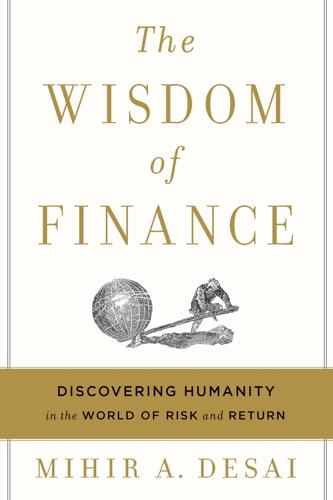
The Wisdom of Finance: Discovering Humanity in the World of Risk and Return
by
Mihir Desai
Published 22 May 2017
“The Value of Marriage to Family Firms.” Journal of Financial and Quantitative Analysis 48, no. 2 (2013): 611–36. There is now a rich literature on recent trends in assortative mating: Greenwood, Jeremy, Nezih Guner, Georgi Kocharkov, and Cezar Santos. Marry Your Like: Assortative Mating and Income Inequality. Working paper no. 19829. National Bureau of Economic Research, January 2014; and Eika, Lasse, Magne Mogstad, and Basit Zafar. Educational Assortative Mating and Household Income Inequality. Working paper no. 20271. National Bureau of Economic Research, July 2014. Journalistic summaries are provided in Bennhold, Katrin.
…
Translation from academese: the Monte allowed elites to keep inmarrying (endogamy), rather than marrying up-and-comers with large cash dowries, and thereby perpetuated the economic strength of the elites rather than diluting that power. Indeed, these scholars point to the Monte as the reason for the durability of the elites of Florence relative to other elites in other city-states. The dowry fund encouraged what is known as “assortative mating,” where individuals mate with people like themselves rather than at random. As a result, elites could stay in power by creating strategic alliances between elite families. Marriages were, in effect, mergers between powerful families, and the Monte was the financing mechanism that allowed them to keep pursuing those mergers.
…
No such stock price appreciation happens when these children marry “commoners.” It’s not just in the cultures of Asia. Modern America is increasingly characterized by marriages of individuals with similar financial power. In fact, one of the major drivers of increasing income inequality recently has been the revival of assortative mating. With more marriages happening between individuals of similar earning power and educational pedigree, economic power has become more concentrated. Some estimates suggest that if mating were to happen as randomly as it did in 1960, household income inequality would have changed little over the last fifty years.
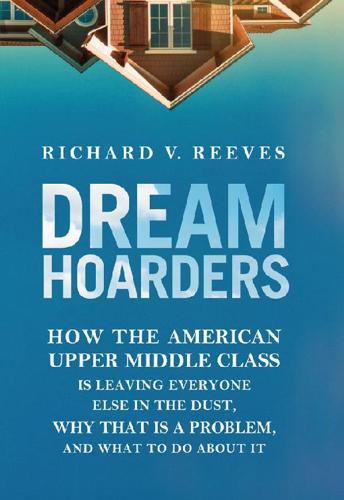
Dream Hoarders: How the American Upper Middle Class Is Leaving Everyone Else in the Dust, Why That Is a Problem, and What to Do About It
by
Richard V. Reeves
Published 22 May 2017
As Isabel Sawhill puts it in her book Generation Unbound: Drifting into Sex and Parenthood without Marriage, “family formation is a new fault line in the American class structure.”25 The rising disparity in earnings for both men and women is therefore amplified by class gaps in the chances of being in a relationship where resources and risks can be shared. Highly educated Americans are not just more likely to be married: they are more likely to be married to each other. This process, with the stunningly unromantic label of “assortative mating,” means that college grads marry college grads. To the extent that cognitive ability is reflected in educational attainment and passed on genetically, assortative mating is likely to further concentrate advantage. As Michael Young put it, “Love is biochemistry’s chief assistant.”26 Online dating has simply added some helpful algorithms. If you don’t want to look online, you could look around the lecture hall.
…
The share of marriages with two college graduates has grown from 3 percent in 1960 to 22 percent in 2012 (in large part, of course, because there are so many more female grads around).28 Households with two college graduates multiply that high earnings power by two, which widens the income gap. The combined effects of more women at work, changes in family structure, and increased assortative mating have widened income gaps. Gary Burtless estimates that between 10 percent and 16 percent of the rise in income inequality in the United States between 1979 and 2004 was caused by the “growing correlation of earned incomes received by husbands and wives.”29 Families with two college graduates will have more money to invest in their children.
…
The elite is on the way to becoming hereditary: the principles of hereditary and merit are coming together.5 High-IQ men and women seek each other out and have high-IQ children, who they then educate and train intensively. And so status becomes inherited again, just in a different and more apparently morally palatable way: “The top of today breeds the top of tomorrow.” It is hard not to read Young’s words and think of the growing evidence for “assortative mating” discussed in chapter 2. If smarts are what count, we are likely to seek intelligence in our mate, not just beauty or brawn. Unlike in Young’s dystopia, there is no government body in the contemporary United States measuring IQ on a regular basis. But educational achievements, highly valued in the market, get quite close.
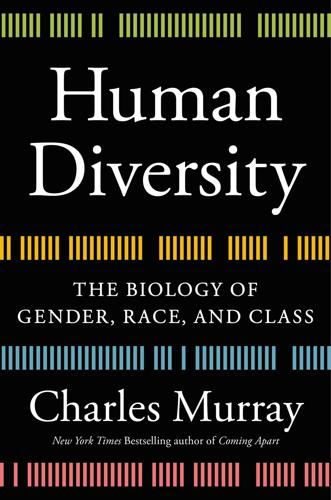
Human Diversity: The Biology of Gender, Race, and Class
by
Charles Murray
Published 28 Jan 2020
For general discussion of these assumptions with additional references, see Verweij, Mosing, Zietsch et al. (2012) and Appendix A of Barnes, Wright, Boutwell et al. (2014). 18. Genetic assortative mating needs to be discriminated from cultural transmission, which also tends to inflate the estimate of shared environmental effects. For a discussion of the assumptions of the classical twin model and an empirical assessment of assortative mating for intelligence, see Vinkhuyzen, van der Sluis, Maes et al. (2012). 19. A separate issue is the genome-wide genetic similarity of mates (e.g., see Domingue, Fletcher, Conley et al. (2014)). Here I am reporting evidence for phenotypic assortative mating on discrete traits that are known to be substantially heritable. 20.
…
The higher that correlation between the heights of the parents, the more that DZ twins resemble each other over and above the degree that would be predicted by their shared genes, but for a reason that has nothing to do with the environment. Suppose that the assortative mating increased the observed DZ correlation to +.6. In that case, the MZ twin correlation is unchanged at 1.0, but the Falconer formula would determine that the value of the shared environment, C, is 2 × .6 – .6 = .6, or 60 percent, which is inflated. In the real world, assortative mating is routine. At least when it comes to marriage, people tend to marry others who are similar on a wide variety of traits. The empirical reality of that statement has been established for a long time, beginning with Steven Vandenberg’s review of the early literature in 1972.19 Since then, extensive additional research has documented assortative mating for education, intelligence, political affiliation, mental illness, substance abuse, aggressive behavior, and criminal behavior.
…
The empirical reality of that statement has been established for a long time, beginning with Steven Vandenberg’s review of the early literature in 1972.19 Since then, extensive additional research has documented assortative mating for education, intelligence, political affiliation, mental illness, substance abuse, aggressive behavior, and criminal behavior. Often these correlations are substantial, in the region of +.4 to +.5.20 The expectation must be that assortative mating leads to consistent though modest underestimates of A in the ACE model. The Equal Environments Assumption On average, parents of MZ twins treat them more similarly than do parents of DZ twins.
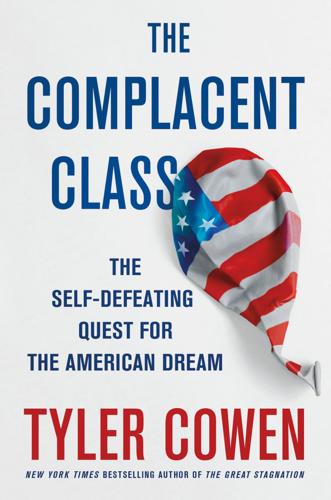
The Complacent Class: The Self-Defeating Quest for the American Dream
by
Tyler Cowen
Published 27 Feb 2017
America’s prowess at matching means more segregation by income and educational status and indirectly more segregation by race in many parts of the country, even as racial tolerance has never been higher. It is price and rental rates that are driving different groups apart, not outright prejudice, so that good matching technologies can separate us more rapidly and more effectively than ever before. There is also more assortative mating of high earners and high achievers—the investment banker will marry another investment banker rather than a next-door neighbor or high school sweetheart or secretary. That’s great for wealthy and accomplished couples, but it is harder for many others to break into these very exclusive pairings.
…
Farmers, by the way, are especially likely to marry each other, in part because it’s a tough job with unusual hours and in part because both members of the potential couple tend to live in rural areas with a smaller number of other professions around. If you are getting up every morning at 4:30 a.m., there is something to be said for marrying another person who does the same.9 “Assortative mating”—that is, the marriage of people of similar educational and socioeconomic backgrounds—has become more widespread than in the past. That phrase refers to matching generally, but it also refers more specifically to men of high education and income marrying women of high education and income. More concretely, lawyers marry other law partners, or perhaps investment bankers, rather than their secretaries.
…
But that segregation also constitutes better matches—a positive word if you are either a successful company or someone with the skill set to be desirable to such a firm. Americans with potent talents are working together, and more effectively, than ever before, and that is a kind of successful matching, an assortative mating of IQ and talent at the corporate level. This new segregation has preserved the quality and cooperativeness of America’s very best clusters, such as tech businesses in Silicon Valley. A troublemaker can’t just show up at Google and set up a desk and start working and interacting with workers.
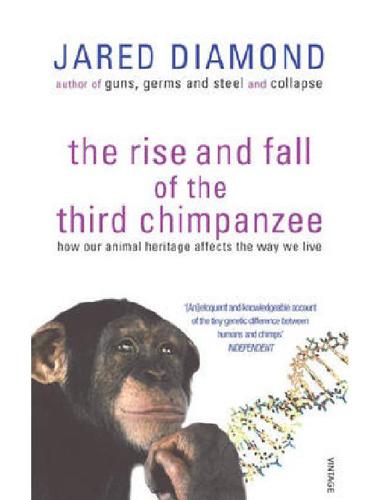
The Rise and Fall of the Third Chimpanzee
by
Jared Diamond
Published 2 Jan 1991
Walster et al, 'Importance of physical attractiveness in dating behavior', Journal of Personality and Social Psychology 4, pp. 508-16 (1966); J.N. Spuhler, 'Assortative mating with respect to physical characteristics', Eugenics Quarterly 15, pp. 128-40 (1968); E. Berscheid and K. Dion, 'Physical attractiveness and dating choice: a test of the matching hypothesis', Journal of Experimental Social Psychology 7, 173-89 (1971); S.G. Vandenberg, 'Assortative mating, or who marries whom? , Behavior Genetics 2, pp. 127-57 (1972); G.E. DeYoung and B. Fleischer, Motivational and personality trait relationships in mate selection', Behavior Genetics 6, pp. 1–6 (1976); E. Crognier, 'Assortative mating for physical features in an African population from Chad', Journal of Human Evolution 6, pp. 105–114 (1977); P.N.
…
Newcomb, Longitudinal study of marital success and failure', Journal of Consulting and Clinical Psychology 46, pp. 1053-70 (1978); R.C. Johnson etal, 'Secular change in degree of assortative mating for ability? , Behavior Genetics 10, PP- 1–8 (1980); W.E. Nance et al, 'A model for the analysis of mate selection in the marriages of twins', Acta Geneticae Medicae Gemellologiae 29, pp. 91-101 (1980); D. Thiessen and B. Gregg, 'Human assortative mating and genetic equilibrium: an evolutionary perspective', Ethology and Sociobiology 1, pp. 111—40 (1980); D.M. Buss, 'Human mate selection', American Scientist 73, pp. 47–51 (1985); A.C.
…
Make Andersson describes his experiments on how female widowbirds responded to males with artificially shortened or lengthened tails in an article 'Female choice selects for extreme tail length in a widowbird', Nature 299, pp. 818-20 (1982). Three papers describing mate choice by white, blue, or pink snow geese are by F. Cooke and C.M. McNally: 'Mate selection and colour preferences in Lesser Snow Geese', Behaviour 53, pp. 151-70 (1975); F. Cooke et al, 'Assortative mating in Lesser Snow Geese (Anser caerulescensY, Behavior Genetics 6, pp. 127-40 (1976); and F. Cooke andJ.C. Davies, 'Assortative mating, mate choice, and reproductive fitness in Snow Geese', pp. 279-95 in Mate Choice by Patrick Bateson, already cited. Chapter 7: Why Do We Grow Old and Die? The classic paper in which George Williams presented an evolutionary theory of aging is 'Pleiotropy, natural selection, and the evolution of senescence', Evolution 11, pp. 398–411 (1957).
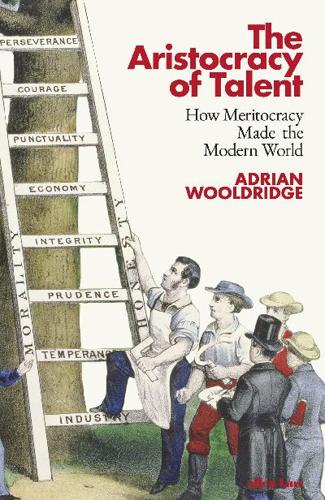
The Aristocracy of Talent: How Meritocracy Made the Modern World
by
Adrian Wooldridge
Published 2 Jun 2021
‘Tom Brown’s School-days’ have been replaced by ‘Tom Brown’s Porsche Days’, as John Rae, a former headmaster of Westminster once put it, with pupils bent on getting the right grades and forging the right contacts so that they can eventually buy that red Porsche and a house in the south of France.9 ASSORTATIVE MATING The marriage of money and merit is being driven by two of humanity’s most basic instincts: our tendency to marry people like ourselves (assortative mating) and our desire to do the best for our children. We may continue to read our children stories about Cinderella marrying a prince, but in the real world university graduates marry other university graduates and high-school dropouts marry other high-school dropouts.
…
Intellectual aristocrats weren’t bound by the same rules as landed aristocrats: intellectual patrimonies weren’t diluted in the same way as landed patrimonies if you didn’t entail them to your eldest sons; you didn’t cheat your sons if you invested in your daughters. Intellectual aristocrats also married other intellectual aristocrats in an early example of the assortative mating that has done so much to shape our own times. So they were surrounded by broods of clever children, girls as well as boys and, increasingly, the girls weren’t willing to play second fiddle to their brothers, or reconcile themselves to a life as baby-machines. Henry Sidgwick, a Cambridge philosopher, married Eleanor Balfour, niece of Lord Salisbury (prime minister 1885–6, 1886–92, 1895–1902) and elder sister of Arthur Balfour (prime minister 1902–5) and a formidable figure in her own right who eventually became principal of Newnham College, Cambridge (1892–1910).
…
A glance at the annual Record of Balliol College, Oxford, with its litany of ‘all Balliol’ marriages and ‘all Balliol’ babies, shows that the old adage that ‘at the top of the tree in every profession you will find an arboreal slum of Balliol men’ needs to be modified to include ‘Balliol women and babies’. Assortative mating acts as a mighty multiplier of inequality: two married lawyers are substantially richer than two married shelf-stackers. It also has a much bigger impact on the overall tenor of society than the existence of a handful of billionaires somewhere in the stratosphere. One academic study of the United States shows that in 1960 a couple of high-school graduates who married each other earned about 103 per cent of the average household income.
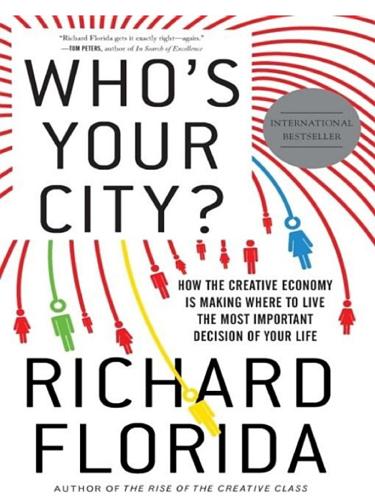
Who's Your City?: How the Creative Economy Is Making Where to Live the Most Important Decision of Your Life
by
Richard Florida
Published 28 Jun 2009
It’s hard to fault people for what Nobel Prize winner Gary Becker termed “assortative mating,” the tendency to pair off with someone like themselves.10 And in a world in which highly talented and highly paid people concentrate in the same handful of places, it should come as little surprise that they are marrying each other. Over time, this growing tendency of like marrying like will only reinforce clustering and geographic sorting along class lines, giving the emerging map of social, economic, and cultural segregation even greater permanence. It stands to reason that assortative mating reflects economic inequality, but recent research also offers evidence that the phenomenon is a driving force behind disparities in wealth as well.
…
A study by economists Raquel Fernández and Richard Rogerson, published in 2001 in the Quarterly Journal of Economics, concluded that increased marital sorting (whereby high earners marry high earners) “will significantly increase income inequality.” 11 Likewise, a 2003 analysis by Brookings economist Gary Burtless found that increased marital sorting between 1979 and 1996 was behind 13 percent of the growth in economic inequality during that period. Burtless cautions, however, that he does not believe assortative mating is necessarily more pronounced than it used to be: men have long married women of their own social class. “Now that women who are in a position to [work or pursue advanced degrees] are attending college and graduate school and joining the professions,” writes Annie Murphy Paul in the New York Times, “the economic consequences of Americans’ assortative mating habits are becoming clearer.” Also behind increasing socioeconomic inequality is a growing gap between married couples and single people.
…
Index Adelaide Aesthetic-amenity premium Aesthetics community happiness and importance of industrial place choice and Agglomeration Agriculture Allen, Woody Amabile, Teresa Amazon Am-Brus-Twerp region (fig.) American Community Survey Amman Amsterdam Anderson, Brad Anholt, Simon See also City Brands Index Antwerp Apor, Jane the Arcade Fire Armani Art scenes Assortive mating Atlanta Atlantic, The Auckland Austin Australia Austria Avent, Ryan Axtell, Robert Baby boomers Baltimore Bangalore Bangalore-Madras(fig.) Bangkok(fig.)(fig.) Barber, Benjamin Barcelona Barce-Lyon(fig.) Basic services importance of place choice and Batty, Michael Beatles, The Beautiful cities Beauty premium Becker, Gary Beijing(fig.)

The Meritocracy Trap: How America's Foundational Myth Feeds Inequality, Dismantles the Middle Class, and Devours the Elite
by
Daniel Markovits
Published 14 Sep 2019
But even if innocently brokered, these marriages, taken all together, enormously concentrate the elite, both within a generational cohort and especially down through the generations. Assortative mating increases economic inequality within the marrying cohort, operating literally as a multiplier for the already growing inequality produced by rising top labor incomes. If marriage pairings had been random by education in 1960, this would have had no observable effect on household income inequality. But when highly paid superordinate workers pair off, marriage ceases to be neutral. Replacing today’s actual pattern of assortative mating with random pairings, or indeed with the lower level of assortative mating from 1960, would reduce overall inequality by a fifth or more.
…
Moreover, the rich make these choices not severally but together, embedded in communities of other rich people making similar choices. Children of rich parents are conceived, borne, and born in markedly more auspicious circumstances than middle-class children enjoy. The elite increasingly marry each other—a practice that economists have given the ugly name assortative mating. Assortative mating had been common during the last decades of the nineteenth century, among the aristocracy in the Gilded Age, but then declined over the first half of the twentieth century. By 1960 only 3 percent of American marriages were between partners who both possessed college degrees. Meritocratic inequality renewed the elite’s preference for elite mates, so that by 2010, fully 25 percent of couples were composed of two college graduates.
…
Replacing today’s actual pattern of assortative mating with random pairings, or indeed with the lower level of assortative mating from 1960, would reduce overall inequality by a fifth or more. In addition, assortative mating increases educational inequality in the next generation down. Elites do not just increasingly marry each other but also increasingly stay married and raise children within mature, stable marriages. This difference increasingly distinguishes the elite from not just the poor but also the middle class. And the distinction confers a massive advantage on children born into rich families. To begin with, elite, educated women increasingly bear children only after marrying, as compared to their less elite, less educated counterparts. In 1970, out-of-marriage births accounted for only about 10 percent of births to women across all education levels.
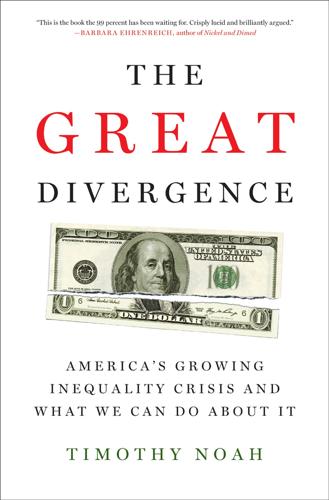
The Great Divergence: America's Growing Inequality Crisis and What We Can Do About It
by
Timothy Noah
Published 23 Apr 2012
Single mothers are now more likely to file for bankruptcy than the elderly, divorced men, members of ethnic minorities, and inhabitants of low-income neighborhoods.26 Do greater financial risk, increased assortative mating, and the rise of single-parent households—all by-products of women’s growing clout in the economy—contribute to the Great Divergence? In the case of economic risk, the answer is yes in the abstract—families at greater risk of going bankrupt are by definition at greater risk of lowering their income. But if the reason for their instability is that they rely on more income than they once did (from two sources rather than one), it would seem perverse to blame the Great Divergence on two-income families. Assortative mating clearly did contribute to the Great Divergence.
…
Assortative mating clearly did contribute to the Great Divergence. But since income-based assortative mating has also been on the rise abroad—one study has it rising within OECD countries from 33 percent to 40 percent during the past two decades—it seems doubtful that assortative mating did much to make the Great Divergence so much worse in the United States than income-inequality trends in other industrialized democracies.27 As for single parenthood, its contribution to the Great Divergence must be judged minimal because it increased mostly before 1980, when the Great Divergence was just getting under way. By the early 1990s, the growth in single-parent households halted altogether, and though it resumed in the aughts the rate of growth was significantly slower.28 Another consideration is that single parenthood is today less damaging economically than it was at the start of the Great Divergence.
…
Where taxicab drivers once were employed by cab companies, by 2006 most of them leased their cabs from cab companies, an arrangement that required them to acquire their own gasoline and their own auto insurance and to take the losses when business was slow.22 Shifts in Marriage Patterns People like to procreate with people like themselves. Biologists refer to this as “assortative mating.” One particularly strong affinity is economic. People tend to marry people whose incomes are at roughly the same level as their own. Back when women didn’t typically have professional careers, the opportunities for a male lawyer on his way to making partner to marry a female lawyer on her way to making partner were few and far between.
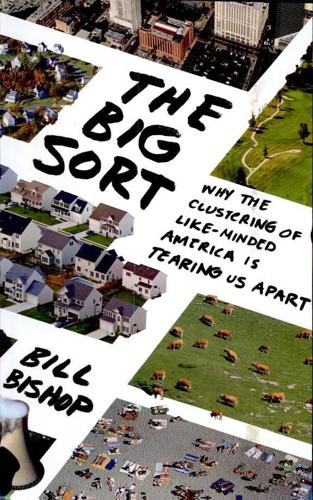
The Big Sort: Why the Clustering of Like-Minded America Is Tearing Us Apart
by
Bill Bishop
and
Robert G. Cushing
Published 6 May 2008
THE POLITICS OF MIGRATION OPPOSITES DON'T ATTRACT. Psychologists know that people seek out others like themselves for marriage and friendship. That the same phenomenon could be taking place between people and communities isn't all that surprising. "Mobility enables the sociological equivalent of assortative mating,'" explained social psychologist David Myers. Assortative mating—the tendency of similar types to pair up—has been studied as a cause of poverty and autism. But Myers was making a different point. Our wealth, education, and ability to move have allowed us to seek "those places and people that are comfortably akin to ourselves."1 The United States was shaped by migration.
…
Not Hearing the Other Side Even if Americans don't live among those from another party as much as they did a generation ago, they certainly have increasing access through the media and the Internet to all manner of opinions and points of view. The choice is there, but there is a media corollary to the phenomenon of assortative mating. Given unprecedented media choices, people self-segregate into their own gated media communities. In cities (most outside the United States) where a variety of newspapers reflect an array of political points of view, people don't buy several newspapers to learn what others are thinking. Instead, they buy the one that best fits their political proclivities.
…
INDEX Abortion in Colorado, [>], in Minnesota, [>], [>], [>]–[>], in Oregon, [>], and political parties, [>], [>], and post-matenalism, [>], [>] n; public opinion on, [>], and religion, [>], in South Dakota, [>], Supreme Court on, [>], in Texas, [>] Abramowitz, Alan, [>], [>], [>] n, [>], [>] Ackerman, Bruce, [>] ACLU, [>] ACT (America Coming Together), [>], [>], [>], [>] Action Fund Management, [>] Adams, Abigail, [>] Adams, Ben, [>]–[>] Adams, John Quincy, [>], [>] Advertising of air conditioners, [>]–[>], [>], Applebee's strategy of, [>], [>], and class, [>]–[>], and demographic groupings, [>]–[>]; fears about, [>], [>] n, and geography of influence, [>]–[>], and image tribes, [>]–[>], and influential people, [>]; intrusiveness of, [>], [>] n, and market segmentation, [>], [>]–[>], [>], [>]; for national brand names, [>]; one-to-one marketing methods, [>]–[>], political advertising, [>]–[>], [>]–[>], [>]–[>]; by Procter & Gamble, [>], traditional advertising research, [>]–[>], and word of mouth, [>]–[>], [>] Advocacy funding, [>]–[>], [>]–[>] Affleck, Ben, [>] Afghanistan war, [>]–[>] AFL-CIO, [>] Africa, [>]–[>] Age and migration, [>], [>] n; and political party membership, [>]–[>] Ailes, Roger, [>] Alabama, [>] Albuquerque, N.Mex., [>] n Alcohol use, [>] ALEC, [>]–[>] ALICE, [>] All the King's Men (Warren), [>] Allen, George, [>] Allport, Gordon, [>] Amazon.com, [>] America Coming Together (ACT), [>], [>], [>], [>] American Center for Law and Justice, [>] American Civil Liberties Union (ACLU), [>] American Constitution Society, [>] American Enterprise Institute, [>] American Evangelism (Hunter), [>]–[>] n American Legion, [>], [>] American Legislative Exchange Council (ALEC), [>]–[>] American Legislative Issue Campaign Exchange (ALICE), [>] American Political Science Association, [>] Americans for Democratic Action, [>] The Anatomy of Buzz (Rosen), [>] n Anderson, Chris, [>] n Anderson, Sherry Ruth, [>]–[>] Anomie, [>] Antiwar protests, [>]–[>], [>] Apathy, benefits of, [>]–[>] Appalachian Regional Commission, [>] Apple Corp, [>], [>] Applebee's, [>]–[>], [>], [>], [>]–[>] Ardery, Julia, [>] Arizona. See Phoenix, Ariz Armey, Dick, [>] Armstrong, Jerome, [>], [>] Armstrong, Lance, [>] Assortative mating, [>], [>] Atlanta, Ga.. blacks in, [>], [>], [>]; creative-class workers in, [>]; as high-tech city, [>] n, [>], [>], migration to, [>], [>], [>], [>] Atlantic magazine, [>] The Atlas of North American English (Labov), [>] n Austin, Tex.. Bishops'neighborhood in, [>]–[>], [>], [>], [>], boundaries of, [>] n; churches in, [>]–[>]; Clarksville neighborhood in, [>]–[>]; conservatives in Dallas versus, [>]; creative-class workers in, [>]; educational level of residents of, [>]; and environmentalism, [>], [>] n; government in, [>]; as high-tech city, [>], [>] n, [>]; interest groups in, [>]; and midterm elections (2006), [>]; migration to, [>], [>], [>], [>], [>], school in, [>], as superstar city, [>]; and transportation, [>]; wages in, [>] Austin American-Statesman, [>], [>] n, [>], [>] Automobiles, [>] n, [>], [>] Babington, Charles, [>] Bacon, Francis, [>] Bai, Matt, [>] Baltimore, Md., [>] Barnes, Fred, [>] Barnett, Guy, [>] Baron, Robert, [>], [>], [>] Bartels, Larry, [>], [>] Baton Rouge, La., [>]–[>] Baton Rouge Advocate, [>], [>] Battlo, Jean, [>] Bay Area Center for Voting Research, [>] n Bayh, Evan, [>] Baylor College of Medicine, [>] Baylor University Institute for Studies of Religion, [>] n Beasley, Jerry, [>] Belgium, [>], [>] Bell, Daniel, [>], [>] Bell, Terrel, [>] Bellamy, Bill, [>], [>], [>], [>] n Bennett, Anina, [>] Bennett, Joni, [>] Benson, Duane, [>]–[>] Berger, Peter, [>] Berkeley, Calif., [>] n Berry, Jon, [>] n Bethlehem, N.H., [>] n Bible-beliefs about, [>], [>], [>]; and emerging churches, [>], high school course on, [>], and social reform, [>].
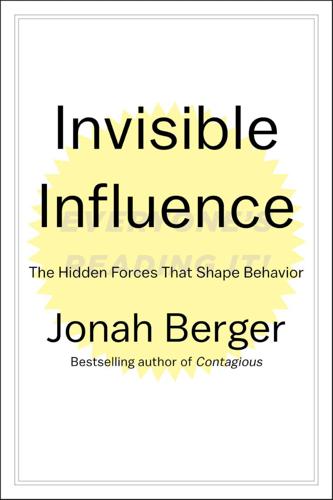
Invisible Influence: The Hidden Forces that Shape Behavior
by
Jonah Berger
Published 13 Jun 2016
See Pike, Thomas, and Kevin Laland (2010), “Conformist Learning in Nine-Spined Sticklebacks’ Foraging Decisions,” Biology Letters 6, 466–68. 4. Little, Anthony C., Michael Burt, and David Perrett (2006), “Assortative Mating for Perceived Facial Personality Traits,” Personality and Individual Differences 40, 973–84; Hinsz, Verlin (1989), “Facial Resemblance in Engaged and Married Couples,” Journal of Social and Personal Relationships 6, 223–29; Griffiths, Wayne, and Phillip Kunz (1973), “Assortative Mating: A Study of Physiognomic Homogamy,” Social Biology 20, 448–53; Zajonc, Robert, Pamela Adelmann, Sheila Murphy, and Paula Niedenthal (1987), “Convergence in the Physical Appearance of Spouses,” Motivation and Emotion 11, 335–46. 5.
…
Genetics aren’t the only reason siblings look similar, though, because married couples actually resemble one another as well. Even though spouses aren’t related, their faces look alike. Compare two married people with two people selected at random and the married people look more similar. Part of this similarity is driven by assortative mating. People tend to marry others of similar ages, nationalities, and racial backgrounds. Swedes tend to marry Swedes, twenty-year-olds tend to marry twenty-year olds, and South Africans tend to marry South Africans. Birds of a feather flock together, as they say. Further, people tend to like others that look like them.
…
Abacus watch, 124 Abercrombie & Fitch, 101, 107, 108, 110 Academic performance birth order and, 66 race and, 16, 117–20, 141–42 “Acting white,” 117–20, 121, 141–42 Adoption studies, 68 Advertising signaling used in, 140 social class and, 94–95 African Americans, 117–20, 121, 141–42 Afunctionality, 124–27 Aguilera, Christina, 44 Ahrendts, Angela, 143–44 AIDS/HIV transmission, signaling and, 121 Allen, Ray, 207 Ants, social facilitation and, 189 Apollo 11 space shuttle (watches made from fragments of), 123 Apple, 97, 103, 184n, 185 Arpa, Yvan, 128 Art preferences, 16, 70–71, 72, 73 Asch, Solomon, 20, 22–24, 29, 58 Assortive mating, 31 Athletics. See Sports/athletics Audience effects, 189n Autokinetic effect, 21 Automobiles, 2–4, 15, 16 differentiation of, 83 introduction of, 182–83 logos on, 133 optimal distinction in, 177–79 signals conveyed by, 107–8, 122, 123, 144 similarity of, 156–57 social class and preferences in, 86–87, 90–91 Avis, 220 Babies mimicry in, 33 naming (see Names) perceived differences in, 16, 85 Baby One More Time (album), 43 Babysitters, ice cream preferences in, 103–4 Baseball, 204 Baselworld, 123–24 Basketball, 17, 204, 207–8, 214 Beckham, David, 127 Beer preferences, 71–72, 73 Beetle (Volkswagen), 157 Berra, Yogi, 73 Bicycles, single-speed or fixed gear, 125 Binge drinking, discouraging, 140–41 Birth order, 16, 64–70 Blockbusters, 42–55 music website experiment, 46–49, 52–53 parking preference experiment, 49–52, 53 quality and, 53–54 BMWs, 2–4, 83, 180 Bon Appétit, 94 Boredom, 167–69 Bottega Veneta, 134, 135 Bradlow, Eric, 150 Branding.
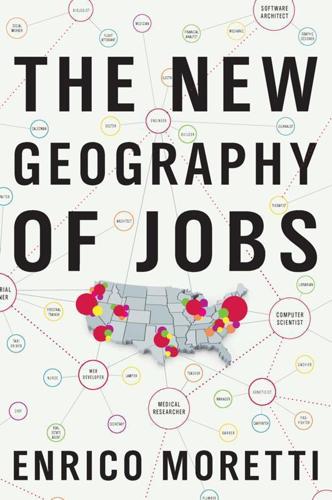
The New Geography of Jobs
by
Enrico Moretti
Published 21 May 2012
The marriage market in the United States has become increasingly segregated along educational lines, with well-educated professionals increasingly marrying other well-educated professionals. Economists have a decidedly unromantic term for this trend: assortative mating. It means that people tend to marry people with similar socioeconomic characteristics. Assortative mating is nothing new: even in the 1980s, well-educated women were more likely to marry well-educated men than less educated men. However, this tendency has strengthened over the past thirty years, with a significant increase in the probability that a man with a master’s degree will marry a woman with a master’s degree, a man with a college degree will marry a woman with a college degree, and so on.
…
However, this tendency has strengthened over the past thirty years, with a significant increase in the probability that a man with a master’s degree will marry a woman with a master’s degree, a man with a college degree will marry a woman with a college degree, and so on. This applies not just to educational levels but also to type of job, salary level, and many other factors. Like attracts like. As assortative mating increases, the need for a large marriage market also increases. If you are looking for a partner with very specific characteristics, a thick dating scene is better. Remarkably, even for married couples the need for thick cities is increasing, because large labor markets are particularly important for families in which both the husband and the wife have a professional career.
…
See Forces of agglomeration Agriculture-to-industrialization shift in U.S., [>], [>] Air Force Academy, fitness experiment at, [>] Akron, [>] Albany, [>], [>] Albuquerque, [>] and Microsoft, [>]–[>], [>]–[>] and Seattle, [>]–[>] Alexandria, Louisiana, and cost of living, [>] Alexopoulos, Michelle, [>] Allen, Paul, [>], [>], [>] Altoona, Pennsylvania, and cost of living, [>] Amazon, [>], [>] American Apparel, [>] American Community Survey, [>] “American dream,” [>], [>] death of, [>]–[>] American Pastoral (Roth), [>]–[>] Amgen, [>], [>] Amylin Pharmaceuticals, [>] Anchorage, Alaska, and cost of living, [>], [>] Aniston, Jennifer, [>] Anniston, Alabama, [>], [>] Ann Arbor, [>], [>], [>] A123 Systems, [>] Apple, [>]–[>], [>], [>], [>], [>], [>], [>], [>], [>]–[>] Applied Materials, [>] Argentina, [>], [>] Artisanal workshops, [>] Assortative mating, [>] Atlanta, [>] and biotech industry, [>], [>] Empowerment Zone Program in, [>] August Capital, [>] Austin, Texas, [>], [>], [>]–[>], [>], [>], [>] college graduates in, [>], [>] and cost of living, [>] exciting celebrities in, [>] Austral Capital, [>] Australia, [>], [>] Austria, PISA scores of, [>] Automation, in production of PCs and semiconductors, [>] Automobile industry, [>].

Model Thinker: What You Need to Know to Make Data Work for You
by
Scott E. Page
Published 27 Nov 2018
The only question concerns the size of the effect.11 Sociologists calibrate the model by categorizing people into five education levels: dropout, high school, some college, college degree, and postgraduate. They then calculate the average income for each education level and fit the data for the number of marriages between each pair of education levels, resulting in a crude approximation of the impact of assortative mating. Assortative Mating Sorting Model and Categories Each individual has an education level: {1, 2, 3, 4, 5} where 1 = dropout, 2 = high school diploma, 3 = some college, 4 = college degree, and 5 = postgraduate. Let P(m, j) and P(w, j) denote the probability that a man and woman have education level j.
…
As an alternative, we might wait for a war or revolution to redistribute wealth by force or for some technological breakthroughs that produces a new set of wealthy capitalists. Our next two models give priority to sociological forces. Both also have strong empirical support. The first explains rising inequality based on assortative mating. A family’s income depends on the incomes of both partners. If a low-income person marries a high-income person, then that marriage will contribute toward equalizing income distributions. If high-income people marry other high earners, then income disparities will increase. Most people marry at an age when a potential partner’s lifetime income cannot be known with certainty.
…
Household income for a couple consisting of a man with education level lM and a woman with education level lW earns the following estimated household income:12 Income(M, lM) + Income(W, lW) Cause of inequality: Increases in the number of educated women, increased pay for workers with higher levels of education, and assortative mating (the tendency for people to marry others of the same income level) result in an increase in household-level income inequality. Had marriages been random rather than assortative, income inequality would be much less. One study finds that inequality as measured by the Gini coefficient, a common measure of inequality, would have decreased by 25%.13 Our next model analyzes movements between income categories using a Markov model.
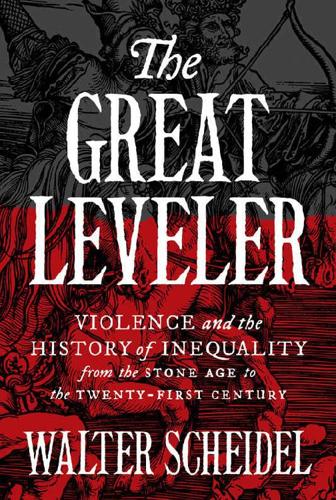
The Great Leveler: Violence and the History of Inequality From the Stone Age to the Twenty-First Century
by
Walter Scheidel
Published 17 Jan 2017
Even so, at least up to this point, international economic integration and competition is in theory expected to constrain only certain types of redistributive policies and in practice has not generally undermined welfare spending.12 In rich countries, demographic factors have impinged on the income distribution in different ways. Immigration has had only a small effect on inequality in the United States and has even generated equalizing consequences in some European countries. Conversely, assortative mating—more specifically, the growing economic similarity of marriage partners—has widened gaps between households and has been credited with causing some 25 percent to 30 percent of the overall increase in American earnings inequality between 1967 and 2005, even though this effect may have been largely concentrated in the 1980s.13 Institutional change is another prominent culprit.
…
Welfare: Bowles 2012a: 73–100 (theory); Hines 2006 (practice). 13 Immigration to the United States: Card 2009. Europe: Docquier, Ozden, and Peri 2014 (OECD); Edo and Toubal 2015 (France); and cf. also D’Amuri and Peri 2014 (Western Europe). For Latin America, see herein, chapter 13, p. 368 n. 1. Assortative mating: Schwartz 2010, with reference to earlier studies that attribute 17 percent to 51 percent of the overall increase to this factor. 1980s: Larrimore 2014. 14 Salverda and Checchi 2015 provide the most comprehensive survey of this topic. For the importance of unionization and minimum wages, see 1653, 1657, and also, e.g., Koeniger, Leonardi, and Nunziata 2007; and see Autor, Manning, and Smith 2010; Crivellaro 2013: 12 for the role of minimum wages.
…
Offshore wealth: Zucman 2013 and esp. 2015: 53 table 1. Cf. also Medeiros and Ferreira de Souza 2015: 885–886. 24 Förster and Tóth 2015: 1804 fig. 19.3 offer a succinct qualitative summary of the multiple causes of inequality and their contrasting effects. In addition to the ones mentioned in the text, they also note assortative mating, single-headed households, voter turnout, partisanship, and female employment. Levy and Temin 2007 offer a synthetic historical account of institutional change since World War II that first contained and later precipitated income inequality. Historically, the role of the stagflation of the 1970s, which provided a powerful impulse for disequalizing economic liberalization, also needs to be taken into account.

Ageless: The New Science of Getting Older Without Getting Old
by
Andrew Steele
Published 24 Dec 2020
However, more recent work has revised down even this low estimate. Unfortunately for statisticians, people don’t usually pick their partner entirely at random – they tend to pair up with people whose characteristics are more similar to themselves than would be expected by chance, a tendency known as ‘assortative mating’. A 2018 study, using thousands of birth and death records from a genealogy website, mathematically corrected for this effect – and found that the heritability of longevity dropped to under 10 per cent. The researchers actually found that married couples’ lifespans were more closely correlated than the lifespans of opposite-gendered children.
…
However, it’s disempowering news for any biologists hoping to comb through the population looking for the genetic underpinnings of longevity: genetic effects are subtle and we shouldn’t expect to uncover amazing longevity mutations if we go out naïvely looking in the general population without carefully correcting for issues like assortative mating. Fortunately, the task can be made a lot easier if we look in more unusual places. The first place to try is the exceptionally old. There’s something distinctly strange (in a good way) about people who make it to 100. Studies find that they weigh about the same and don’t smoke or drink much less, exercise much more or eat much better than the general population.
…
Herskind et al., ‘The heritability of human longevity: A population-based study of 2872 Danish twin pairs born 1870–1900’, Hum. Genet. 97, 319–23 (1996). DOI: 10.1007/BF02185763 ageless.link/ijjnnc A 2018 study, using … a genealogy website … J. Graham Ruby et al., ‘Estimates of the heritability of human longevity are substantially inflated due to assortative mating’, Genetics 210, 1109–24 (2018). DOI: 10.1534/genetics.118.301613 ageless.link/p6mjpn … [centenarians] weigh about the same … Swapnil N. Rajpathak et al., ‘Lifestyle factors of people with exceptional longevity’, J. Am. Geriatr. Soc. 59, 1509–12 (2011). DOI: 10.1111/j.1532-5415.2011.03498.x ageless.link/hw9are A brief overview of work on genetics and lifestyles of centenarians can be found in the first half of this talk: Nir Barzilai, ‘Can we grow older without growing sicker?’
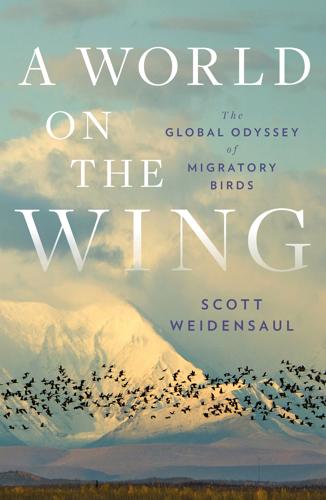
A World on the Wing: The Global Odyssey of Migratory Birds
by
Scott Weidensaul
Published 29 Mar 2021
What’s more, scientists used stable chemical isotopes in the feathers of blackcaps nesting in Germany and Austria to determine their wintering areas and found that, perhaps because they don’t have as far to migrate, the UK population arrives earlier than Iberian blackcaps each spring, and produces bigger broods when they nest. Arriving before the Iberian birds, the British blackcaps not surprisingly also pair up preferentially with each other, a behavior known as assortative mating—and that created a buzz in the ornithological world when the findings were published in 2005, because assortative mating can be the first tentative step toward speciation. Indeed, later research confirmed that after just a few decades, there are now weak but significant genetic differences between the UK and Iberian populations. Biologists once assumed that geographic isolation was the main driver of evolution, but temporal isolation can work, too, and in this case, climate change is nudging the two populations of blackcaps apart.
…
Andres, Brad A., Cheri Gratto-Trevor, Peter Hicklin, David Mizrahi, RI Guy Morrison, and Paul A. Smith. “Status of the Semipalmated Sandpiper.” Waterbirds 35, no. 1 (2012): 146–149. Bearhop, Stuart, Wolfgang Fiedler, Robert W. Furness, Stephen C. Votier, Susan Waldron, Jason Newton, Gabriel J. Bowen, Peter Berthold, and Keith Farnsworth. “Assortative Mating as a Mechanism for Rapid Evolution of a Migratory Divide.” Science 310, no. 5747 (2005): 502–504. Bilodeau, Frédéric, Gilles Gauthier, and Dominique Berteaux. “The Effect of Snow Cover on Lemming Population Cycles in the Canadian High Arctic.” Oecologia 172, no. 4 (2013): 1007–1016. Chambers, Lynda E., Res Altwegg, Christophe Barbraud, Phoebe Barnard, Linda J.
…
aerial insectivores, 89, 98–99 AFRAU (Amur Falcon Roost Area Union), 325, 331, 338 aguiluchos, 228, 246 Aigner, Karine, 165 air sacs, 74–75 Alambritis, Nicos, 301, 306 albatrosses, 255, 256–57 Antipodes, 275 Laysan, 257 sooty, 257 Tristan, 257, 273–74 Aleutian Islands, 271–73, 276–77 Alleger, Todd, 92–93, 96 ambelopoulia, 280, 292, 293, 300, 302, 308–9, 310 American Bird Conservancy, 225–26, 270 American Birding Association, 251 Amur falcons breeding areas, 320 conservation of, 316–17, 324–29, 337, 338–39 description, 319–20 diet, 322, 328 hunted in Pangti, 316–17, 327–28 migration, 312, 320, 321 roosting in Nagaland, 312, 316, 318–19, 322–23, 337–39 Anand, Ulhas, 329 Andreas, 278, 284–87, 288–91, 299, 301, 302–3, 304–5 Andres, Brad, 117 Antipodes Islands, 275 archival GPS tags, 120–21, 124. See also GPS tracking Argentina, Swainson’s hawks in, 223, 224–30, 245–46 assortative mating, 221 audio migration monitoring, 135–38 Audubon, John James, 15 Auer, Tom, 154 auklets Cassin’s, 171–72 whiskered, 271, 272–73 Australia, and seasonal mismatch, 201 avocets, pied, 46–47 Bahamas. See also Kirtland’s warblers black-throated blue warblers in, 171 map of, 162 bal-chatri traps, 226–27, 240, 241 banding.
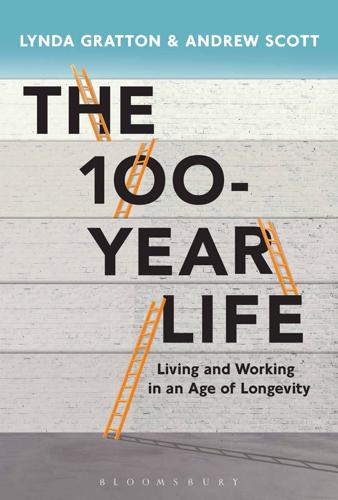
The 100-Year Life: Living and Working in an Age of Longevity
by
Lynda Gratton
and
Andrew Scott
Published 1 Jun 2016
Others are low-paid, such as gardeners, artisanal manufacturers, baristas or yoga teachers. At this rate, smart cities will become a better place to generate employment than the old manufacturing hubs. This growing importance of smart cities is also driven by social phenomena. The last few decades have seen a striking increase in what sociologists call assortative mating. In other words, marriage partners are more alike now in terms of education and income than they were in the past. This effect is also driving the growth of cities. For these highly skilled partnerships, finding interesting work for two is a great deal more difficult than finding it for one.6 In the past, small towns were more attractive for traditional families where the husband worked and the wife was a homemaker.
…
There is also the important advantage of risk pooling; this played an important role in the way Jane and Jorge navigated their life, and we expect that more couples will make the same commitments to each other to pool the risk. This may go some way to explaining the significant shift to what has been termed assortative mating,8 where both partners are of similar age, education and income. In Becker’s traditional view of marriage, the production complementarities gained most when there is a significant income differential between partners, giving greater scope to comparative advantage. However, when the potential income differential is less, then it makes more sense for partners to pool their risk and this is easiest where the earning capacity of both partners is similar.
…
Index The letter f following an entry indicates a figure 3.0 scenarios here–here, here, here, here 3.5 scenarios here–here, here, here 4.0 scenarios here–here, here–here, here, here 5.0 scenarios here–here, here, here, here, here, here–here Acorns here activities of daily living (ADL) here adolescence here–here, here adult equivalence scales here age cognition and here–here corporations and here explorers and here–here government policy and here independent producers and here life stages and here–here, here–here portfolios and here predictability of here segregation and here–here, here–here, here, here–here age process algorithms here, here ageing process here, here ageism here, here agency here, here, here finance and here–here agriculture here–here Amazon here anxiety here appearance here Apple iPhone here reputation here Archer, Margaret here Artificial Intelligence (AI) here, here, here, here education and here human skills and here medical diagnoses and here–here, here skills and knowledge and here–here Asia here assets here, here see also intangible assets; tangible assets; transformational assets assortative mating here–here, here Astor, Brooke here Autor, David here–here, here Baby Boomers here–here beauty here Becker, Gary: ‘Treatise on the Family’ here, here–here, here behavioural nudges here Benartzi, Shlomo here benefits here–here see also welfare Bennis, Warren here birth rates, decline in here–here, here brain, the here–here, here–here cognition here Braithwaite, Valerie here Brontë, Charlotte: Jane Eyre here Buffett, Warren here–here Calico (California Life Company) here Calment, Jeanne here careers breaks and here changes and here–here dual careers here, here, here cell aging here centenarians here, here–here change here–here catalysts for here–here corporations and here–here, here education and here–here government policy and here–here, here identity and here–here inequalities and here–here mastery and here–here planning and experimentation and here–here rate of here–here Cherlin, Andrew here chess here children here, here–here, here Christensen, Clayton here Cloud Robotics here cohort estimate of life expectancy here, here, here companies here, here–here, here–here Amazon here Apple here–here change and here–here, here creative clusters here–here economies of scale and here–here Facebook here flexibility here–here, here–here reputation and here–here research and here small business ecosystems here–here technology and here–here Twitter here value creation here–here WhatsApp here compression of morbidity here–here computing power here–here, here–here see also Moore’s Law connectivity here–here consumerism here, here consumption complementarities here–here consumption levels here, here continuums here corporations here–here, here–here see also companies creative clusters here–here independent producers and here–here creativity here cross-age friendships here crucible experiences here–here Deep Learning here dementia here depreciation here developing countries life expectancy and here–here, here state pensions and here Dickens, Charles: Old Curiosity Shop, The here diet here Dimson, Elroy here disabilities here discounting here discretionary time here diverse networks here, here–here Doctorow, Corey: Makers, The here Downton Abbey effect, the here–here Doyle, Arthur Conan here driverless cars here, here dual career households here, here, here Dweck, Carol here–here dynamic/diverse networks here, here–here Easterlin’s Paradox here economy, the here–here agriculture and here–here gig economy here job creation and here–here leisure industry and here service sector and here sharing economy here, here stability and here education here, here–here, here–here see also mastery experiential learning here–here, here, here human skills and judgement and here ideas and creativity and here institutions here–here learning methods here mental flexibility and agility and here–here multi-stage life and here specialization here–here, here, here technology and here, here, here training here efficacy here, here, here–here elasticity here–here emerging markets life expectancy and here state pensions and here emotional spillover here employers here–here, here employment see also companies; employment changes age and here, here–here, here–here changes and here, here, here–here, here–here city migration and here–here creation here–here demographics and here, here–here diverse networks and here–here elasticity and here–here environmental concerns and here–here, here family structures and here–here, here, here–here, here, here, here–here flexibility and here–here, here, here–here, here–here, here–here, here hollowing out of work here–here, here, here home and here job classification here–here knowledge and skills and here levels here, here matches here–here mobility here multi-stage life and here office-based here paid leave here participation rates here–here, here pay here–here, here psychological contract here satisfaction here–here self-employment here–here specialization and here–here statistics here status and here supply and here–here technology and here, here–here, here–here, here, here, here–here, here unique human skills here–here, here vacancies here–here women and here–here working hours here–here, here working week here–here employment changes here, here, here–here companies and here–here industry sectors and here–here, here entrepreneurship here–here see also independent producers equity release schemes here experiential learning here–here, here, here experimentation here, here–here, here–here explorers here–here, here–here adventurers here age and here–here assets and here crucible experiences and here–here options and here–here searchers here, here exponential discounting here exponential growth here–here Facebook here families here, here, here–here, here children here, here–here, here dual career households here, here, here marriage here–here work and here, here finance here, here–here see also pensions age process algorithms here, here agency and here–here automation and here–here costs here–here efficacy and here–here equity release schemes here flexibility here governments and here–here, here, here–here health and here housing and here–here hyperbolic discounting here–here inheritances here–here investment here, here–here, here–here, here, here old age and here–here pay here–here, here pension replacement rates here–here, here, here–here portfolios here–here psychology and here–here retirement and here–here fitness and health here–here see also health Fleming, Ian here flexibility here, here–here, here, here–here, here–here, here corporations and here–here government policy and here–here working patterns and here flexibility stigma here, here Ford, Henry here Foxconn here Frey, Carl here Friedman, Stewart here–here, here Fries, James here, here Future of Work Consortium here future selves here–here future selves case studies Jane here–here, here–here Jimmy here–here, here galumphing here–here gender here, here see also women inequality here–here, here–here, here, here, here specialization of labour here, here–here, here, here, here–here Generation Y here generational attitudes here gerontology here Giddens, Anthony here, here gig economy here–here globalization here Goldin, Claudia here, here Google here governments here, here–here, here inequalities and here–here pensions and here–here rate of change and here–here Gratton, Lynda here Shift, The here growth mindset here–here Groysberg, Boris here Haffenden, Margaret here Hagestad, Gunhild here–here, here Harvard Grant Study here health here, here–here brain, the here–here chronic diseases here–here, here compression of morbidity here–here dementia here diseases of old age here–here finance and here improvements in here–here inequality here, here–here infectious diseases here public health here stress here–here healthy life expectancy here heterogeneity here hollowing out of work here–here, here, here home, work and here household here–here see also home economies of scale and here–here relationships here, here–here, here, here housing here–here imputed rent here, here ownership here HR policies here–here human skills here–here, here, here, here hyperbolic discounting here–here Ibarra, Herminia here identity here–here, here, here–here, here–here see also self-control; self-knowledge improvisation here–here imputed rent here, here income see also welfare distribution here growth and here inequalities here–here, here–here skills and knowledge and here–here income effect here–here independent producers here–here, here–here assets and here case study here–here creative clusters and here–here learning and here–here prototyping here–here reputation and curating and here–here India here–here Individual, the here Industrial Revolution, the here–here, here, here, here inequalities here–here gender and here–here, here–here, here, here, here government policy and here–here health here, here–here income here–here, here–here life expectancy and here–here, here–here, here infant mortality here intangible assets here–here, here–here, here case studies here–here, here–here, here corporations and here–here endowed individual characteristics here, here independent producers and here marriage and here productive assets see productive assets time and here transformational assets see transformational assets transitions and here–here vitality assets see vitality assets International Labour Organization (ILO) here ‘Women and the Future of Work’ here investment here, here–here, here–here, here Japan centenarians here–here life expectancy here, here–here,here–here, here pensions and here population decline and here job classification here–here job creation here–here job satisfaction here–here juvenescence here, here–here, here Kahneman, Daniel here Kegan, Robert here Keynes, John Maynard: Economic Possibilities of Our Grandchildren here knowledge see skills and knowledge Kurzweil, Ray here labour market see employment Lampedusa, Giuseppe : Leopard, The here law (occupation) here–here leadership here learning methods here leisure class here leisure industry here, here, here–here leisure time here, here, here–here, here–here, here–here Keynes, John Maynard and here life expectancy here–here, here see also long life best practice here, here calculating here–here, here chronic diseases and here–here cohort estimate of here, here, here developing countries and here–here diseases of old age and here–here government plans and here healthy life expectancy here historical here, here, here increase in here–here, here India and here–here inequalities in here–here, here–here, here infant mortality and here Japan and here, here–here, here–here, here limit to here–here period life expectancy measure here, here–here public health innovations and here South Korea here US and here–here Western Europe here life stages here–here, here–here age and here–here experiential learning and here explorers and here–here, here–here independent producers and here–here, here–here juvenescence and here, here–here multi-stage model here, here–here, here, here, here–here, here–here, here new stages here, here see also life stages case studies portfolios and here–here, here–here three-stage model here, here–here, here–here, here–here, here–here, here–here, here–here transitions and here life stages case studies diversity and here Jane here–here Jimmy here–here, here lifetime allowances here–here, here, here liminality here Linde, Charlotte here lockstep of action here–here, here London here–here London Business School here long life see also life expectancy as a curse here, here as a gift here, here Luddites, the here machine learning here marriage here–here Marsh, Paul here Marshall, Anthony here mastery here–here matching here–here Millenials here Mirvas, Philip here Modigliani, Franco here MOOCs (Massive Open Online Courses) here, here Moore’s Law here–here, here Moravec’s Paradox here, here morbidity here–here compression of here–here Morrissey, Francis here mortality here mortality risk here multiple selves here–here National Commission on Technology, Automation, and Economic Progress here neighbourhoods here neoplasticity here neoteny here, here new experiences here occupations here–here old age dependency ration here–here, here Ondine, curse of here options here, here–here Osborne, Michael here paid leave here Parfit, Derek here participation rates here–here, here peers here–here pension case studies Jack here, here–here, here, here Jane here, here, here–here, here, here, here, here, here–here Jimmy here–here, here, here–here, here, here, here–here, here three-stage life model here–here, here–here, here–here pension replacement rate here–here, here, here–here pensions here, here–here, here see also pension case studies amount required here–here funded schemes here goals and here government policy and here–here investment and here, here occupational pensions here–here Pay As You Go schemes here–here, here, here pension replacement rate here–here, here, here–here reform and here state pensions here–here, here period life expectancy measure here, here–here personal brands here pharmacy (occupation) here planning here plasticity here–here play here–here politics, engagement with here Polyani’s Paradox here–here, here population here–here, here–here portfolios (financial) here–here portfolios (life stage) here–here, here–here switching costs here transitions and here–here posse here–here, here possible selves here, here–here possible selves case studies Jane here–here Jimmy here–here, here Preston, Samuel here production complementarities here, here–here, here productive assets here–here, here case studies here, here, here–here, here, here, here, here–here, here, here marriage and here transitions and here professional social capital here–here prototyping here–here psychology here, here–here see also self-control age process algorithms here, here automation and here–here behavioural nudges here saving and here–here pure relationships here, here pyramid schemes here re-creation and recreation here–here, here–here recruitment here reflexive project, the here regenerative community here, here, here Relation P here relationships here–here, here, here children and here–here divorce and here–here, here dual career households here families and here–here, here–here friendships here, here–here household here, here–here, here, here marriage and here–here, here–here matches and here–here multi-generational living here–here, here options and here–here pure relationship here switching roles here, here, here, here–here reputation here–here, here–here, here–here retirees here–here retirement see also pensions age of here, here, here, here, here–here, here consumption levels and here corporations and here, here government policy and here–here stimulation in here, here risk here risk pooling here robotics here, here, here, here see also Artificial Intelligence role models here routine here routine activities here routine-busting here routine tasks here–here Rule of here here Sabbath, the here sabbaticals here–here Save More Tomorrow (SMarT plan) here–here Scharmer, Otto here second half of the chessboard here–here segregation of the ages here–here, here–here, here, here–here self-control here–here, here–here age process algorithms here, here automation and here behavioural nudges here self-employment here–here self-knowledge here–here, here finance and here–here service sector here sexuality here–here Shakespeare, William King Lear here sharing economy here–here, here, here short-termism here–here skills and knowledge here, here–here, here see also human skills earning potential and here professional social capital and here–here technology and here–here valuable here–here Slim, Carlos here smart cities here–here independent producers and here–here social media here, here–here society here spare time here see also leisure time standardized practices here–here Staunton, Mike here strategic bequest motive, the here–here substitution effect here switching here, here, here, here–here tangible assets here–here, here, here, here, here see also housing; pensions case studies here, here, here, here, here, here transitions and here taxation here, here–here Teachers Insurance and Annuity Assurance scheme here technology here, here see also Artificial Intelligence computing power here–here, here–here see also Moore’s Law driverless cars here–here, here education and here, here, here employment and here, here–here, here–here, here, here, here–here, here human skills and here, here innovation and here matching and here relationships and here teenagers here–here, here–here, here, here Thaler, Richard here thick market effects here–here Thomas, R. here time here, here–here see also sabbaticals discretionary time here flexibility and here–here, here Industrial Revolution, the here–here, here–here, here intangible assets and here leisure and here, here, here–here, here–here, here–here restructuring here, here spare time here working hours here–here, here, here–here working hours paradox here–here, here working week, the here–here, here time poor here–here trade unions here transformational assets here, here–here, here–here, here, here, here case studies here–here, here–here, here–here, here–here, here, here, here, here crucible experiences and here corporations and here transitions here, here–here, here–here, here corporations and here financing here–here government policy and here, here nature of here–here portfolios and here–here re-creating here recharging here–here tribal rituals here Twitter here Uhlenberg, Peter here–here, here UK, occupational pension schemes and here–here Unilever here universities here US here–here compression of morbidity and here occupational pension schemes and here Valliant, George here value creation here vitality assets here, here–here, here case studies here, here–here, here, here, here–here, here, here, here, here transitions and here–here website here week, the here–here weekend, the here, here weight loss here welfare here–here see also benefits Wharton School of the University of Pennsylvania here–here, here WhatsApp here Wolfran, Hans-Joachim here women see also gender children and here–here relationships and here, here, here work and here–here Women and Love here work see employment working hours here–here, here, here–here working week, the here–here, here Yahoos here–here youthfulness here–here Bloomsbury Information An imprint of Bloomsbury Publishing Plc 50 Bedford Square 1385 Broadway London New York WC1B 3DP NY 10018 UK USA www.bloomsbury.com BLOOMSBURY and the Diana logo are trademarks of Bloomsbury Publishing Plc First published 2016 © Lynda Gratton and Andrew Scott, 2016 Lynda Gratton and Andrew Scott have asserted their right under the Copyright, Designs and Patents Act, 1988, to be identified as Author of this work.
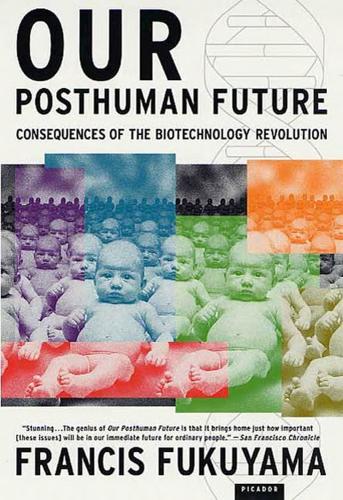
Our Posthuman Future: Consequences of the Biotechnology Revolution
by
Francis Fukuyama
Published 1 Jan 2002
Murray and Herrnstein maintained that in a world in which social barriers to mobility were falling and the rewards to intelligence rising, society would be increasingly stratified along cognitive lines. Genes and not social background would be the key to success. The most intelligent would walk away with most of the earnings; indeed, due to “assortative mating” (the tendency of people to marry like people) the cognitive elite would tend to increase its relative advantage over time. Those of lower intelligence faced severely limited life chances, and the ability of compensatory social programs to improve them was limited.16 These arguments echoed those made earlier by psychologist Arthur Jensen in an article in the Harvard Educational Review that appeared in 1969, in which he came to similar pessimistic conclusions. 17 It is no wonder that The Bell Curve produced such controversy.
…
The most clear and present danger is that the large genetic variations between individuals will narrow and become clustered within certain distinct social groups. Today, the “genetic lottery” guarantees that the son or daughter of a rich and successful parent will not necessarily inherit the talents and abilities that created conditions conducive to the parent’s success. Of course, there has always been a degree of genetic selection: assortative mating means that successful people will tend to marry each other and, to the extent that their success is genetically based, will pass on to their children better life opportunities. But in the future, the full weight of modern technology can be put in the service of optimizing the kinds of genes that are passed on to one’s offspring.
…
Affymetrix Africa, sub-Saharan African-Americans and crime age, and ability age cohorts age discrimination age distribution political implications of ageing problems with and sexuality theories of Agence Française du Médicament (France) aggression genes and sex differences in Agreement on Sanitary and Phytosanitary Measures (SPS) agricultural biotechnology regulation of agricultural biotechnology industry agriculture, history of alcohol Alexander, Richard alpha males “Alphas, Betas, Epsilons, and Gammas” altruism Alzheimer’s disease American diet American Medical Association (AMA) American Psychologist, special issue of American Revolution American South, slavery in amino acids amniocentesis androgynous median personality angry young men Animal and Plant Inspection Service animal ethology animal rights movement animals behavior of consciousness of cultural learning by pain and suffering felt by rights of social hierarchies among sympathy with traits shared with humans animal testing anthropology anti-immigrant backlash movements Antinori, Severino ape-human cross, proposed apes apperception, transcendental unity of Argentina aristocracy natural Aristotle political philosophy of Arkes, Hadley Arnhart, Larry artificial intelligence (AI) Ashkenazi Jews Asia sex-selection in Asilomar Conference assortative mating attention deficit disorder (ADD) attention deficit hyperactivity disorder (ADHD) medicalization of Austria authoritarian regimes Babylonia Bacon, Francis ballistic missiles, control of Becker, Gary behavior genetic basis of learned medicalization of self-control over behavioralism behavior genetics behavior modification Belgium bell curve debate Bentham, Jeremy benzodiazepines Berg, Paul Bernal, J.
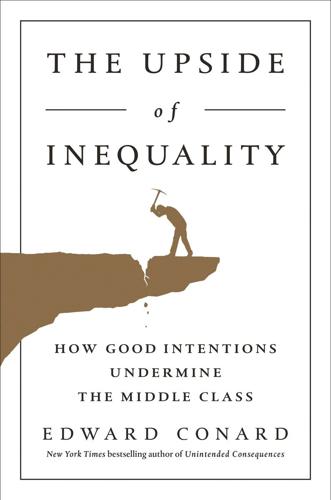
The Upside of Inequality
by
Edward Conard
Published 1 Sep 2016
For example, the greater uncertainty of employment allegedly makes working-class men less marriageable.7 Their lower workforce participation allegedly leads to a decline in marriage and a corresponding rise in out-of-wedlock births. The children of single parents are more prone to unruly behavior.8 Alternatively, an increase in assortative mating—people with similar levels of education, income, and capability marrying each other—heightens the difference between the children of the haves and the have-nots. The haves devote extra resources—whether money, time, or attention—which allows their children to compete more successfully for an alleged shortage of educational and employment opportunities.9 Some sociologists also allege that growing segregation between the haves and the have-nots prevents the have-nots from benefiting from the positive peer pressure of the haves.10 Ironically, while one school of thought blames the separation of the successful for failing to provide good examples to the middle and working classes, another camp claims that the success of the 1 percent drove an envious middle class to borrow against the rising value of their homes in order to consume too much.11 Yet despite these concerns, wages have risen with little change in the shape of their distribution.
…
More likely, rising middle- and working-class prosperity is giving people the opportunity to eschew supervision and leadership and to do as they please. Unfortunately, it’s easier to gain status destructively with a devil-may-care attitude rather than constructively with hard work and moral fortitude. While it is true that assortative mating has boosted the incomes of richer households, and that these households have invested more in their children relative to other families, it is doubtful that this trend diminishes anyone’s educational opportunities. If anything, the share of rich white children in prestigious colleges, where enrollment is limited, has declined.
…
See test scores accelerating growth, 243–66 balanced trade and strengthening bank guarantees for, 254–59 ferocity of competition and, 79–82 investors influencing economic policy for, 106–8 lowering marginal corporate tax rate for, 249–54 promising educational opportunities for, 234–40 ultra-high-skilled immigration for, 244–49 admission policy, of charter schools, 223, 224 Affordable Care Act, 24 African American children charter schools, 223–26 high school dropout rates and income mobility, 182, 182–83, 235 preschool education, 228–30 African Americans comparisons of causes of poverty, 183, 183–84 effect of race on income mobility, 180, 181–82 African American workers income distribution, full time, 159, 160 median income, 204 workforce participation rate, 204, 206 agriculture (agrarian economies), 42, 45, 128–29 “alchemist fallacy,” 77 all-equity banking, 138–39 Amazon, 23 Angrist, Joshua, 225, 227 “animal spirits,” 118, 120, 125 antitrust enforcement, 99–100 Apple, 11, 23, 29, 31, 46, 75, 98, 102, 129, 236 Asian-American students, 170, 219 assortative mating, 157, 175 asymmetric information, 87–88, 98–99, 108 automation, 11, 42, 156, 211, 250 Autor, David, 57–58 baby boomers, 15, 42, 44, 243, 244, 247 Bagchi, Sutirtha, 83 Baker, Dean, 77–78 balanced trade, 39–40, 44, 254–59 bank loans, 2, 138–39, 257–58 bank runs, 2, 135–36, 137, 255, 257–58 banks (banking) all-equity, 138–39 capital requirements, 258 guarantees, 138–39, 257–59 risks to economy of instability of, 135–39 Barro, Robert, 82, 236 Bernanke, Ben, 119–20, 126, 140, 150, 151 Bezos, Jeff, 66 birth rate, and labor supply, 41 births, out-of-wedlock, 156, 167, 210 Bordo, Michael, 168 Borjas, George, 56 brain plasticity, 228, 234 Brin, Sergey, 19, 66, 69 Broda, Christian, 46 Brooks, Arthur, 212 budget deficits, 14, 256, 261 Buffett, Warren, 141, 200, 255 Burkhauser, Richard, 162 business consolidation, 24, 102–3 business investment, 103–5, 104, 250 business majors, 245–46 business profits.
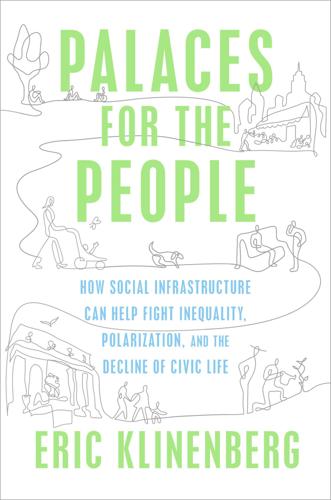
Palaces for the People: How Social Infrastructure Can Help Fight Inequality, Polarization, and the Decline of Civic Life
by
Eric Klinenberg
Published 10 Sep 2018
forms of group mixing that are uncommon today: The data on labor unions come from Gerald Mayer, Union Membership Trends in the United States (Washington, DC: Congressional Research Service, 2004). The quote is from Peter Bearman and Delia Baldassarri, “Dynamics of Political Polarization,” American Sociological Review 72 (October 2007): 787. On the rise of marriage within a social class (or “assortative mating”), see Robert Mare, “Educational Homogamy in Two Gilded Ages,” Annals of the American Academy of Political and Social Science 663 (2016): 117–39. “met with plausible counterarguments”: Cass Sunstein, #Republic: Divided Democracy in the Age of Social Media (Princeton, NJ: Princeton University Press, 2017), 91–92.
…
cannot be entirely to blame: Levi Boxell, Matthew Gentzkow, and Jesse Shapiro, “Is the Internet Causing Polarization? Evidence from Demographics,” Working Paper, 2014, http://web.stanford.edu/~gentzkow/research/age-polar.pdf. different education level, ethnic identity, or religious affiliation: Gina Potarca, “Does the Internet Affect Assortative Mating? Evidence from the U.S. and Germany,” Social Science Research 61 (2017): 278–97. to get news from home: Ivan Watson, Clayton Nagel, and Zeynep Bilginsoy, “ ‘Facebook Refugees’ Chart Escape from Syria on Cell Phones,” CNN, September 15, 2015, https://www.cnn.com/2015/09/10/europe/migrant-facebook-refugees/index.html.
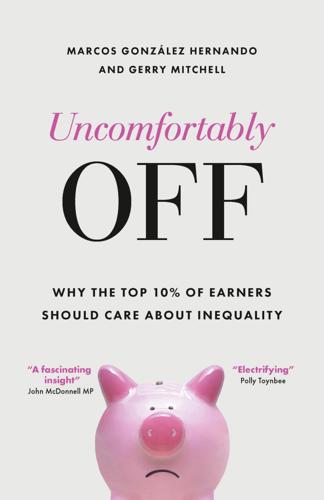
Uncomfortably Off: Why the Top 10% of Earners Should Care About Inequality
by
Marcos González Hernando
and
Gerry Mitchell
Published 23 May 2023
In unequal societies, how people treat each other is affected by income differences; there is less social mixing, less social mobility and less respect granted to those from different social strata. Research on the wealthy in Paris, 129 Uncomfortably Off São Paulo and Delhi has shown this.11 In addition, marriages between people from different socioeconomic backgrounds are less common, with an increase in what sociologists call ‘assortative mating’.12 There is also more residential segregation. We are more separated from each other – culturally, socially and physically. We become increasingly worried about how people judge us relative to others and social contact is more stressful. As a result, everyone keeps more to themselves. Unequal societies also have poorer mental health, with higher rates of psychotic conditions, narcissism, lack of confidence, low self-esteem, depression, and anxiety.13 People trust each other less, and less trust means more stress.
…
Washington, DC: Brookings Institution. Reeves, R. and Rothwell, J. (2020) Class and COVID: How the less affluent face double risks. Brookings Institution. 27 March. www.brookings.edu/blog/up-front/2020/03/27/class-andcovid-how-the-less-affluent-face-double-risks Reeves, R. and Venator, J. (2014) Opposites don’t attract: Assortative mating and social mobility. Brookings Institution. 10 February. www.brookings.edu/blog/social-mobilitymemos/2014/02/10/opposites-dont-attract-assortative-matingand-social-mobility Reich, R. (2020) Billionaires’ donations to fight Coronavirus are largely self-serving. NewsWeek. 13 April. www.newsweek. com/robert-reich-billionaires-donations-fight-coronavirus-arelargely-self-serving-opinion-1497617 Reis, E. and Moore, M.
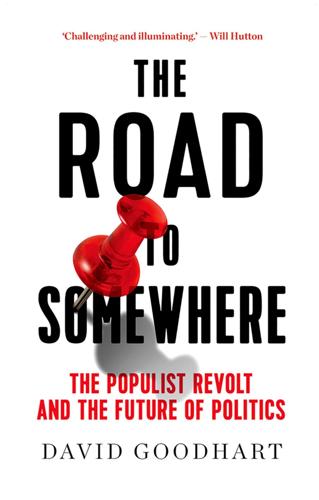
The Road to Somewhere: The Populist Revolt and the Future of Politics
by
David Goodhart
Published 7 Jan 2017
And there is today among middle-class and upper-middle class families an unprecedented focus of attention on improving or at least maintaining their own children’s position—a kind of ‘arms race’ in everything from places in top private or state schools to the use of tutors and job internships. And as the group of hard-to-move professional families slowly expands it is likely that there will be less overall movement, at least through relative mobility. This entrenchment of an elite upper professional class has been reinforced by another factor with the ugly name of ‘assortative mating’—meaning educated and successful people marrying each other. People have always tended to marry broadly within their own class but until a generation or two ago male doctors tended to marry female nurses not female doctors, because there were so few of the latter, and businessmen married their secretaries rather than businesswomen for the same reason.
…
INDEX 1960s liberalism: 6 Aaronovitch, David: 142 Achen, Christopher: Democracy for Realists, 61 Afghanistan: Civil War (1992–5), 82; Operation Enduring Freedom (2001–14), 225 Akesson, Jimmie: defection from Moderate Party, 70 AkzoNobel: 175 Algeria: 104 Alternative für Deutschland: 53, 70, 73 American Dream: 65 anti-Semitism: 57 Anywheres: 10, 12–13, 15, 17–18, 20–1, 41–3, 45, 51, 74, 114–15, 118, 149, 177, 197, 202, 205, 207, 210, 215, 228; characteristics of, 4–5, 17, 24–5, 34–5, 37, 46, 123; conflict with Somewheres, 23, 79, 81, 193, 215; education levels of, 156, 158, 198; employment of, 11; European, 103; family dynamics of, 211–14; liberals, 27–8; mobile, 203; political ideologies of, 63–4, 76, 81–2, 109–10, 112, 120, 213, 224, 232–3; political representation/voting patterns of, 13, 17, 26–7, 36, 62, 69, 75, 78, 91–2, 153, 167, 218–19, 221, 227; potential coalition with Somewheres, 220, 222, 225–6, 233; progressive individualism, 11, 60, 180, 219; view of migrant integration, 134 Apple, Inc.: product lines of, 86 Appiah, Kwame Anthony: 117 assortative mating: 188 Aston University: 164 austerity: 98, 200 Australia: 4, 160 Austria: 56, 69–70 authoritarianism: 8, 12, 30, 33, 44, 57; concept of, 57; hard, 45 Baggini, Julian: observations of British class system, 59 Bangladesh: 130 Bank of England: personnel of, 86 Bartels, Larry: Democracy for Realists, 61 Bartlett, Jamie: Radicals, 64 Basel Accords: 85 BASF: 176 Bayer: 176 Belgium: 73, 75, 101; Brussels, 53, 89, 93, 95, 98 Berlusconi, Silvio: 65 birther movement: 68 Bischof, Bob: head of German-British Forum, 174 Blair, Tony: 10, 76, 159, 189; administration of, 218; foreign policy of, 96; speeches of, 3, 7, 49; support for Bulgarian and Romanian EU accession, 26; unravelling of legacy, 221 Bloomsbury Group: 34 Bogdanor, Vernon: concept of ‘exam-passing classes’, 3 Boyle, Danny: Summer Olympics opening ceremony (2012), 111, 222 Branson, Richard: 11 Brexit (EU Referendum)(2016): 1–2, 19, 27, 81, 89, 93, 99–100, 125, 233; negotiations, 103; polling prior to voting, 30, 64; Remainers, 2, 19–20, 52–3, 132; sociological implications of, 4–7, 13, 53–4, 118, 126, 167–8, 225; Stronger In campaign, 61; Vote Leave campaign, 42, 53, 72, 91, 132; voting pattern in, 7–9, 19–20, 23, 26, 36, 52, 55–6, 60, 71, 74, 215, 218 British Broadcasting Corporation (BBC): 112, 145; Newsnight, 60; personnel of, 15; Radio 4, 31, 227; Today, 60 British Empire: 107 British National Party: European election performance of (2009), 119; supporters of, 38 British Future: 19 British Private Equity and Venture Capital Association: personnel of, 135 British Social Attitudes (BSA) surveys: 153; authoritarian-libertarian scale, 44–5; findings of, 38–9, 44, 106–7, 120, 202, 206–7, 218; immigration survey (2013), 44; personnel of, 218–19 British Values Survey: establishment of (1973), 43; groups in, 43 Brooks, Greg: Sheffield report, 155 Brown, Belinda: 205, 207–8 Brown, Gordon: 106; abolition of Married Couples Allowance, 204; budget of (2006), 147–8; political rhetoric of, 16–17 Brummer, Alex: Britain for Sale, 173 Bulgaria: 26; accession to EU, 225 (2007); migrants from, 126; population levels of, 102 Burgess, Simon: 131 Burggraf, Shirley: Feminine Economy and Economic Man, The, 194 Cahn, Andrew: 98 Callaghan, Jim: Ruskin College speech (1976), 154 Callan, Eamonn: 191 Callan, Samantha: 202, 212 Cambridge University: 35, 179, 186; faculty of, 37; students of, 158–9 Cameron, David: 71, 103, 179, 183, 189; administration of, 226; cabinet of, 187 Canada: 160; mass immigration in, 119 capital: 9, 100; cultural, 190; human, 34; liberalisation of controls, 97; social, 110 capitalism: 7, 11; organised, 159 Care (Christian Action Research & Education): 203 Carswell, Douglas: 13 Case, Anne: 67 Casey, Louise: review of opportunity and integration, 129 Catholicism: 15, 213; original sin, 57 Cautres, Bruno: 72 Center for Humans and Nature: 30 Centre for Social Justice: 206; personnel of, 202 chauvinism: 33; decline in prevalence of, 39; violent, 106 China, People’s Republic of: 10, 95, 104, 160; accession to WTO (2001), 88; manufacturing sector of, 86; steel industry of, 87 Chirac, Jacques: electoral victory of (2002), 49 Christianity: 33, 69, 83, 156 citizenship: 68, 121–2; democratic, 7; global, 114; legislation, 103; national, 5; relationship with migration, 126; shared, 113; temporary, 126 Clarke, Charles: British Home Secretary, 84 Clarke, Ken: education reforms of, 158–9 Clegg, Nick: 11, 13, 189 Cliffe, Jeremy: 10–11; ‘Britain’s Cosmopolitan Future’ 216; observations of social conservatism, 217 Clinton, Bill: 29, 76; administration of, 218 Clinton, Hillary: electoral defeat of (2016), 67–8 Coalition Government (UK) (2010–16): 13, 54, 226; cabinet members of, 16; immigration policies of, 124–5 Cold War: end of, 83, 92, 95, 98 Collier, Paul: 110; view of potential reform of UNHCR, 84 colonialism: 87; European, 105 communism: 58 Communist Party of France: 72 Confederation of British Industry (CBI): 164 confirmation bias: concept of, 30 Conservative Party (Tories)(UK): 19, 207; dismantling of apprenticeship system by, 157; ideology of, 76, 196; members of, 31, 164, 187; Party Conference (2016), 226; Red Toryism, 63; supporters of, 24, 35, 77, 143, 216–17 conservatism: 4, 9; cultural, 58; social, 217; Somewhere, 7–8; working-class, 8 Corbyn, Jeremy: elected as leader of Labour Party, 20, 53, 59, 75, 78 Cowley, Philip: 35 Crosland, Tony: Secretary of Education, 36; two-tier higher education system proposed by, 158 Crossrail 2: 228; spending on, 143 Czech Republic: 69, 73 D66: supporters of, 76 Dade, Pat: 43–4, 219; role in establishment of British Values Survey, 43, 218–19 Daily Mail: 227; reader base of, 4 Danish Peoples’ Party: 55, 69–70, 73; ideology of, 73 Darwin, Charles: 28 death penalty: 44; support for, 39, 216–17 Deaton, Angus: 67 deference, end of: 63 Delors, Jacques: 96, 103–4; President of European Commission, 94 Democratic Party: ideology of, 62, 65; shortcomings of engagement strategies of, 66–7 Demos: 137 Dench, Geoff: 207; concept of ‘quality with pluralism’, 214; Transforming Men, 209 Denmark: 69, 71, 99; education levels in, 156 Diana, Princess of Wales: death of (1997), 107 double liberalism: 1, 11, 63 Duffy, Gillian: 124 Dyson: 173; Dyson effect, 173 Economist: 10, 210, 216 Eden, Anthony: administration of, 187 Eichengreen, Barry: 91 Elias, Norbert: 119 Employer Skills Survey: 163 Engineering Employers Federation: 166 Englishness: 111 Erdogan, Recep Tayyip: 218 Essex Man/Woman: 186 Estonia: population levels of, 102 Eton College: 179, 187 Euro (currency): 100–1; accession of countries to, 98–9 European Commission: 26, 97 European Convention on Human Rights: 83–4 European Court of Justice (ECJ): 103 European Economic Community (EEC): 92; British accession to (1973), 93; Treaty of Rome (1957), 101 European Exchange Rate Mechanism (ERM): 97–8 European Parliament: elections (2009), 71–2; elections (2014), 72 European Union (EU): 10, 25, 53, 76, 89, 92–4, 99–100, 120, 124, 160, 215, 221–2, 229, 233; Amsterdam Treaty (1997), 94; Common Agricultural Policy, 92, 96; establishment of (1957), 91–2; freedom of movement principles, 100–1, 163–4; Humanitarian Protection Directive (2004), 83; integration, 50, 98–9, 173; Lisbon Treaty (2009), 94; Maastricht Treaty (1992), 94, 96, 103; members states of, 16, 31, 55, 71, 216; personnel of, 128; Schengen Agreement (1985), 94–5, 99, 117; Single European Act (1986), 94; Treaty of Nice (2000), 94 Euroscepticism: 69 Eurozone Crisis (2008–): 92, 99 Evening Standard: 143–5 Facebook: 86 family culture: 196–7; childcare, 202–3; cohabitation, 196, 211; divorce figures, 196–7; gender roles, 206–13; legislation impacting, 195–6; lone parents, 196; married couples tax allowance, 225; relationship with state intrusion, 200–2; tax burdens, 203–4; tax credit systems, 202, 204–5, 225 Farage, Nigel: 11; leader of UKIP, 72; political rhetoric of, 20 Fawcett Society: surveys conducted by, 195–6 federalism: 69 feminism: 185, 199, 205; gender pay gap, 198–9; orthodox, 194 Fidesz: 69, 71, 73 Fillon, François: 73 Financial Times: 91, 108, 115, 138, 145, 147 Finkelstein, Daniel: 34 Five Star Movement: 53, 55, 64, 70, 73 Florida, Richard: concept of ‘Creative Class’, 136 Foges, Clare: 183 food sector: 17, 102, 125, 126 Ford, Robert: 35, 150 foreign ownership: 172–74, 230 Fortuyn, Pim: assassination of (2002), 50, 69 France: 69, 75, 94–6, 101, 173; agricultural sector of, 96; compulsory insurance system of, 222; Paris, 104, 143; high-skill/low-skill job disappearance in, 151; Revolution (1789–99), 106 Frank, Thomas: concept of ‘liberalism of the rich’, 62 Franzen, Jonathan: 110 free trade agreements: opposition to, 62 Freedom Party: 69; electoral defeat of (2016), 70; ideology of, 73; supporters of, 70 French Colonial Empire (1534–1980): 107 Friedman, Sam: ‘Introducing the Class Ceiling: Social Mobility and Britain’s Elite Occupations’, 187 Friedman, Thomas: World is Flat, The, 85 Front National (FN): 53, 69, 72–3; European electoral performance of (2014), 72; founding of (1973), 72; supporters of, 72 Gallup: polls conducted by, 65 Ganesh, Janan: 115, 145 gay marriage: 5, 76; opposition to, 46–7; support for, 26, 220 General Electric Company (GEC) plc: 172, 175 German-British Forum: members of, 174 Germany: 70, 73, 86, 94, 96, 100–1, 173–4, 209; automobile industry of, 96; chemical industry of, 176; compulsory insurance system of, 222; education sector of, 166; high-skill/low-skill job disappearance in, 151; labour market of, 147; Leipzig, 58; Ludwigshafen, 176; Reunification (1990), 96, 147, 176; Ruhr, 176–7 Ghemawat, Prof Pankaj: 85–6 Gilens, Martin: study of American public policy and public preferences, 61–2 Glasman, Maurice: 227 Global Financial Crisis (2007–9): 56, 169–70, 177; Credit Crunch (2007–8), 98, 177 Global Villagers: 31–2, 44–5, 160, 226; characteristics of, 46; political representation of, 75; political views of, 109, 112 globalisation: 9–10, 50–2, 81–2, 85, 87–8, 90–1, 105–6, 148; economic, 9; global trade development, 86–7; growth of, 85–6; hyperglobalisation, 88–9; relationship with nation states, 85–6; sane, 90 Golden Dawn: 74; growth of, 105 Goldman Sachs: personnel of, 31 Goldthorpe, John: 184–5, 189–90 Goodhart, David: 12 Goodwin, Fred: 168 Goodwin, Matthew: 150 Gordon, Ian: 137–8, 140 Gould, Philip: 220 Gove, Michael: 64, 91 great liberalisation: 39–40, 47; effect of, 40 Greater London Authority (GLA): 143 Greece: 53, 56, 69, 74, 99, 105; Athens, 143; government of, 98 Green, Francis: 163 Green Party (UK): supporters of, 38 Group of Twenty (G20): 89 Guardian: 14, 210 Habsburg Empire (Austro-Hungarian Empire): collapse of (1918), 107 Haidt, Jonathan: 11, 30, 33, 133; Righteous Mind, The, 28–9 Hakim, Catharine: 205 Hall, Stuart: 14–15 Hames, Tim: 135–6 Hampstead/Hartlepool alliance: 75 Hanson Trust: subsidiaries of, 175 Hard Authoritarian: 43–7, 51, 119, 220; characteristics of, 24–5; political views of, 109 Harris, Gareth: 137; ‘Changing Places’, 137 Harvard University: faculty of, 57 Heath, Edward: foreign policy of, 96 Higgins, Les: role in establishment of British Values Survey, 43 High Speed 2 (HS2): 228 High Speed 3 (HS3): aims of, 151, 228 Hitler, Adolf: 94 Hoescht: 176 Hofstadter, Richard: ‘Everyone is Talking About Populism, But No One Can Define It’ (1967), 54 Holmes, Chris: 151 homophobia: observations in BSA surveys, 39; societal views of, 39–40, 216 Honig, Bonnie: concept of ‘objects of public love’, 111 Huguenots: 121 Huhne, Chris: 16, 32 human rights: 5, 10, 55, 113; courts, 113; legislation, 5, 83–4, 109, 112; rhetoric, 112–13 Hungary: 53, 64, 69, 71, 73–4, 99, 218; Budapest, 218 Ignatieff, Michael: leader of Liberal Party (Canada), 13 Imperial Chemical Industries (ICI): 172, 174–5; personnel of, 169; subsidiaries of, 175 Inbetweeners: 4, 25, 46, 109; political views of, 109 India: 104 Inglehart, Ronald: theories of value change, 27 Insider Nation: concept of, 61, 64; evidence of, 61–2 Institute for Fiscal Studies (IFS): 201; findings of, 211–12 International Monetary Fund (IMF): 86–7, 102 interracial marriage: societal views of, 40 India: 10, 160 Ipsos MORI: polls conducted by, 42, 122 Iraq: 84; Operation Iraqi Freedom (2003–11), 82 Islam: 50; Ahmadiyya, 84; conservative, 131; Halal, 68; hostility to, 73; Qur’an, 50 Islamism: 130 Islamophobia: 130 Italy: 55, 64, 69–70, 73, 96; migrants from, 125 Jamaica: 14 Japan: 86; request for League of Nations racial equality protocol (1919), 109 Jews/Judaism: 121, 259; orthodox, 131; persecution of, 17 jingoism: 8 Jobbik: 53, 64, 74 Johnson, Boris: 145 Jones, Sir John Harvey: death of (2008), 169 Jordan, Hashemite Kingdom of: government of, 84 Jospin, Lionel: defeat in final round of French presidential elections (2002), 49 Judah, Ben: This is London: Life and Death in the World City, 145 Kaufmann, Eric: 8–9, 131, 219, 227; ‘Changing Places’, 137 Kellner, Peter: 78 King, Mervyn: Governor of Bank of England, 86 Kinnock, Neil: 98 knowledge economy: 147, 149, 154, 166, 221 Kohl, Helmut: 94 Kotleba: 74 Krastev, Ivan: 55, 65, 82–3 labour: 9, 89–90, 149; eastern European, 125–6; gender division of, 197; hourglass labour market, 150, 191; living wage, 26, 152; market, 95, 101–2, 124, 140, 147–8, 150–2, 156–7, 181, 225 Labour Party (Denmark): 77 Labour Party (Netherlands): 50; supporters of, 76 Labour Party (UK): 2, 23, 53, 57, 72, 123, 157, 159, 207; Blue Labour, 63; electoral performance of (2015), 75; European election performance (2014), 72; expansion of welfare state under, 199–200; members of, 14, 20, 36, 59, 61, 77–8, 84; Momentum, 53; New Labour, 33, 75, 107, 123, 155, 159, 167, 196, 207, 220, 226, 232; Party Conference (2005), 7; social media presence of, 79; supporters of, 17, 35, 75, 77, 143, 221; voting patterns in Brexit vote, 19 Lakner, Christoph: concept of elephant curve, 87 Lamy, Pascal: 97 Latvia: adoption of Euro, 98–9; migrants from, 25–6 Laurison, Daniel: ‘Introducing the Class Ceiling: Social Mobility and Britain’s Elite Occupations’, 187 Law and Justice Party: 69, 71, 73 Lawson, Nigel: 205 Le Pen, Jean-Marie: victory in final round of French presidential elections (2002), 49, 69 Le Pen, Marine: 53; electoral strategies of, 73 Leadbeater, Charles: 53 League of Nations: protocols of, 109 left-behinders: 20 Lega Nord: 69 Levin, Yuval: Fractured Republic, The, 232 liberal democracy: 2, 31, 55 Liberal Democrats: 23, 53–4; members of, 16; supporters of, 38, 78 Liberal Party (Canada): members of, 13 liberalism: 4–5, 12–13, 29–31, 55, 76, 119, 127–8, 199, 233; Anywhere, 27–8; baby boomer, 6; double, 1, 63; economic, 11; graduate, 216–17; meritocratic, 34; metropolitan, 216; orthodox, 13–14; Pioneer, 44; social, 4, 11 libertarianism: 8, 11, 22, 39, 44 Libya: 84; Civil War (2011), 225 Lilla, Mark: 35 Lind, Michael: 105, 135 Livingstone, Ken: 136 Lloyd, John: 56 London School of Economics (LSE): 54, 137–8, 140, 183 Low Pay Commission: findings of, 170 Lucas Industries plc: 172 male breadwinner: 149, 194, 195, 198, 206, 207 Manchester University: faculty of, 131 Mandelson, Peter: British Home Secretary, 61; family of, 61 Mandler, Peter: 135 Marr, Andrew: 53, 181 Marshall Plan (1948): 92 mass immigration: 14, 55, 104–5, 118–19, 121–4, 126–7, 140, 228–9; accompanied infrastructure development, 137–9; brain-drain issue, 102; debate of issue, 81–2; freedom of movement debates, 100–3; housing levels issue, 138–9; impact on wages, 152; integration, 129–32, 140–2; non-EU, 124–5; opposition to, 16–17, 120, 220 May, Theresa: 63, 179, 183, 198–9; administration of, 173, 176, 187, 191, 230; British Home Secretary, 124–5; ‘Citizens of Nowhere’ speech (2016), 31; political rhetoric of, 15, 31, 226 McCain, John: electoral defeat of (2008), 68 meritocracy: 152, 179–80, 190; critiques of, 180–1; perceptions of, 182–3 Merkel, Angela: reaction to refugee crisis (2015), 71 Mexico: borders of, 21 migration flows: global rates, 82, 87; non-refugee, 82 Milanovic, Branko: 126; concept of elephant curve, 87 Miliband, Ed: 78, 189 Mill, John Stuart: ‘harm principle’ of, 11–12 Millennium Cohort Study: 159 Miller, David: concept of ‘weak cosmopolitanism’, 109 Mills, Colin: 185 Mitterand, François: 94, 97 mobility: 8, 11, 20, 23, 36, 37, 38, 153, 167, 219; capital: 86, 88; geographical, 4, 6; social, 6, 33, 58, 152, 168, 179, 180, 182, 183–191, 213, 215, 220, 226, 231 Moderate Party: members of, 70 Monnet, Jean: 94–5, 97, 103–4 Morgan Stanley: 171 Mudde, Cas: observations of populism, 57 multiculturalism: 14, 50, 141–2; conceptualisation of, 106; laissez-faire, 132 narodniki: 54 national identity: 14, 38, 41, 111–12; conceptualisations of, 45; indifference to, 41, 46, 106, 114; polling on, 41 nationalism: 38, 46–7, 105; chauvinistic, 107, 120; civic, 23, 53; extreme, 104; moderate, 228; modern, 112; post-, 8, 105–6, 112; Scottish, 221 nativism: 57 Neave, Guy: 36 net migration: 126; White British, 136 Netherlands: 13–14, 50, 69, 73, 75, 99–100; Amsterdam, 49, 51; immigrant/minority population of, 50–1; Moroccan population of, 50–1 Netmums: surveys conducted by, 205–6 New Culture Forum: members of, 144 New Jerusalem: 105 New Society/Opinion Research Centre: polling conducted by, 33 New Zealand: 160 Nextdoor: 114 non-governmental organizations (NGOs): 21; refugee, 82 Norris, Pippa: 57 North American Free Trade Agreement (NAFTA): 91; opposition to, 62 North Atlantic Treaty Organization (NATO): 85, 92; personnel of, 84 Norway: 69 Nuttall, Paul: leader of UKIP, 72; Obama, Barack: 67; approval ratings of, 60; electoral victory of (2012), 68; healthcare policies of, 22–3; target of birther movement, 68 O’Donnell, Gus: background of, 15–16; British Cabinet Secretary, 15 O’Leary, Duncan: 232 Open University: Centre for Research on Socio-Cultural Change (CRESC), 172–3 Operation Iraqi Freedom (2003–11): political impact of, 56 Orbán, Victor: 69, 218 Organisation for Economic Co-operation and Development (OECD): 201, 204; report on education levels (2016), 155–6; start-ups ranking, 173 Orwell, George: Nineteen Eighty-Four, 108–9 Osborne, George: 189; economic policies of, 4, 226 Oswald, Andrew: 171 Ottoman Empire: collapse of (1923), 107 outsider nation: concept of, 61, 64 Owen, David: 99 Oxford University: 15, 35, 179, 186; Centre on Skills, Knowledge and Organisational Performance, 151; faculty of, 31, 151; Nuffield College, 32 Pakistan: persecution of Ahmadiyya Muslims in, 84 Parris, Matthew: 115 Parsons, Talcott: concept of ‘achieved’ identities, 115 Party of Freedom (PVV): 69; ideology of, 73; supporters of, 50, 76 Paxman, Jeremy: 42 Pearson: ownership of Higher National Certificates (HNCs)/Higher National Diplomas (HNDs), 157 Pegida: ideology of, 73 Pessoa, Joao Paulo: 88 Phalange: 74 Phillips, Trevor: 133 Pioneers: characteristics of, 43–4 Plaid Cymru: supporters of, 38 Podemos: 53, 64 Poland: 56, 69, 73; migrants from, 25–6, 121 Policy Exchange: ‘Bittersweet Success’, 188 political elites: media representation of, 63–4 populism: 1, 5, 13–14, 49–52, 55–6, 60, 64, 67, 69–74, 81; American, 54, 65; British, 63; decent, 6, 55, 71, 73, 219–20, 222, 227, 233; definitions of, 54; European, 49, 53, 65, 68–9, 74; left-wing, 54, 56; opposition to, 74; right-wing, 33, 51, 54 Populists: 54 Portillo, Michael: 31 Portugal: migrants from, 121, 125 post-industrialism: 6 post-nationalism: 105 poverty: 83, 168; child, 183–4, 200, 204; extreme, 87; reduction of, 78, 200; wages, 231 Powell, Enoch: ‘Rivers of Blood’ speech (1968), 127 Professionalisation of politics: 59 Progress Party: 69 progressive individualism: 5 Progressive Party: founding of (1912), 54 proportional representation: support for, 228 Prospect: 14, 91, 136 Prospectors: characteristics of, 43 Protestantism: 8, 213 Putin, Vladimir: 218 Putnam, Robert: 22; theory of social capital, 110 racism: 32, 73–4, 134; observations in BSA surveys, 39; societal views of, 39; violent, 127 Rashid, Sammy: Sheffield report, 155 Reagan, Ronald: 58, 63; approval ratings of, 60 Recchi, Ettore: 104 Refugee Crisis (2015–): 83–4; charitable efforts targeting, 21–2; government funds provided to aid, 83; political reactions to, 71 Relationships Foundation: 202 Republic of Ireland: 99; high-skill/low-skill job disappearance in, 151; property bubble in, 98 Republican Party: ideology of, 62, 65; members of, 68 Resolution Foundation: 87–8; concept of ‘squeezed middle’, 168–9; reports of, 171 Ricardo, David: trade theory of, 101 Robinson, Eric: 36 Rodrik, Dani: 82, 89; concept of ‘hyperglobalisation’, 88; theory of ‘sane globalisation’, 90 Romania: 26; accession to EU, 225 (2007); migrants from, 102, 126 Romney, Mitt: electoral defeat of (2012), 68 Roosevelt, Theodore: leader of Progressive Party, 54 Rousseau, Jean-Jacques: 156 Rowthorn, Bob: 149 Royal Bank of Scotland (RBS): personnel of, 168 Royal College of Nursing: 140 Rudd, Amber: foreign worker list conflict (2016), 17 Ruhs, Martin: 126 Russell Group: 55; culture of, 37; student demographics of, 130–1, 191 Russian Federation: 2, 92; Moscow, 218; St Petersburg, 218 Rwanda: Genocide (1994), 82 Saffy factor: concept of, 199, 221–2 Scheffer, Paul: 85; ‘Multicultural Tragedy, The’ (2000), 49–50 Schumann, Robert: 94 Sciences Po: personnel of, 104 Scottish National Party (SNP): 1, 23, 54, 112; electoral performance of (2015), 75; ideology of, 53 Second World War (1939–45): 105, 194; Holocaust, 109 Security and identity issues: 41, 78, 81 Settlers: characteristics of, 43 Sikhism: 131 Singapore: 101, 128; education levels in, 156 Slovakia: 69, 73–4 Slovenia: adoption of Euro, 98–9 Smer: 69, 73 Smith, Zadie: 141–2 Social Democratic Party: supporters of, 75–6 social mobility: 6, 33, 58, 179–80, 183, 187, 189–91, 220; absolute mobility, 184, 188; relative mobility, 184; slow, 168; upward, 152 Social Mobility Commission: 161, 179–80 socialism: 49, 72, 183, 190 Somewheres: 3–5, 12–13, 17–18, 20, 41–3, 45, 115, 177, 180, 191, 214, 223, 228; characteristics of, 5–6, 2, 32; conflict with Anywheres, 23, 79, 81, 193, 215; conservatism, 7–8; employment of, 11; European, 103; immigration of, 106; moral institutions, 223–4; political representation/voting patterns of, 13–14, 24–6, 36, 53–5, 77–9, 124, 227; political views of, 71, 76, 109, 112, 119, 199, 218, 224–6, 232; potential coalition with Anywheres, 220, 222, 225–6, 233; view of migrant integration, 134 Sorrell, Martin: 31 Soskice, David: 159 South Korea: 86 Soviet Union (USSR): 92, 188; collapse of (1991), 82, 107 Sowell, Thomas: 30; A Conflict of Visions, 29 Spain: 53, 56, 64, 74; government of, 98; migrants from, 125; property bubble in, 98 Steinem, Gloria: 198 Stenner, Karen: 30, 44, 122, 133, 227; Authoritarian Dynamic, The, 30–1 Stephens, Philip: 108 Sun, The: 227 Sutherland, Peter: 31–2 Sutton Trust: end of mobility thesis, 183–5 Swaziland: 135 Sweden: 56, 70, 100; general elections (2014), 70; Stockholm, 143; taxation system of, 222 Sweden Democrats: 70; electoral performance of (2014), 70; ideology of, 73 Switzerland: 37 Syria: Civil War (2009–), 82, 84 Syriza: 53, 69 Taiwan: 86 Teeside University: 164 terrorism: jihadi, 71, 74, 129 Thatcher, Margaret: 58, 63, 95, 189, 205; administration of, 169; economic policies of, 176 Third Reich (1933–45): 104; persecution of Jews in, 17 Times Education Supplement: 37 Timmermans, Frans: EU Commissioner, 128 Thompson, Mark: Director-General of BBC, 15 trade theory: principles of, 101 Transatlantic Trade and Investment Partnership (TTIP): 89; support for, 225 Trump, Donald: 50, 62, 74, 85; electoral victory of (2016), 1–3, 5–7, 13, 27, 30, 64–8, 81, 232; political rhetoric of, 14, 22–3, 51, 54, 66–7; supporters of, 56, 67 Tube Investments (TI): 172 Turkey: 218 Twitter: use for political activism, 79 Uber: 140 UK Independence Party (UKIP): 53, 55, 63–4, 69, 71–3, 228; electoral performance of (2015), 75; European election performance (2009), 71–2; members of, 13; origins of, 72; supporters of, 24, 35, 38, 72, 75, 143, 168, 216, 222 ultimatum game: 52 Understanding Society: surveys conducted by, 37–8, 202 unemployment: 101–2; gender divide of, 208–9; not in employment, education or training (Neets), 151–2, 190; youth, 139, 151–2, 166 Unilever: 175 United Kingdom (UK): 1–3, 8, 11–12, 21, 27–8, 31, 33, 41, 44, 59–60, 69, 73, 75, 81, 83, 91, 111–12, 147, 165, 173, 180, 193–5, 199, 204, 217, 227; Aberdeen, 136; accession to EEC (1973), 93; Adult Skills budget of, 161, 225; apprenticeship system of, 154, 157, 162–3, 166; Birmingham, 7, 123, 166; Boston, 121; Bradford, 133, 136; Bristol, 136; British Indian population of, 77; Burnley, 151; Cambridge, 136; City of London, 95, 106, 174; class system in, 58–9, 75, 123, 135–6, 149–52, 172, 182–3, 186, 195; Dagenham, 136; Department for Education, 206; Department for International Development (DfID), 224; Divorce Law Reform Act (1969), 196; economy of, 152, 170; Edinburgh, 54, 136; education sector of, 35, 147, 154–8; ethnic Chinese population of, 77; EU citizens in, 101; Finance Act (2014), 211; Foreign and Commonwealth Office (FCO), 224; Glasgow, 136; high-skill/low-skill job disappearance in, 150–1; higher education sector of, 35–7, 47, 159–62, 164–7, 179, 208, 230–1; Home Office, 17; House of Commons, 162; general election in (2015), 60; House of Lords, 31; Human Rights Act, 123, 225; income inequality levels in, 169–70, 172, 177, 184–5; labour market of, 16, 26, 124, 140–1, 148, 150–1, 152, 225; Leicester, 133; Leeds, 161; London, 3–4, 7, 10–11, 18–19, 24, 26, 34, 37, 59, 79, 101, 114–15, 119, 123, 131, 133–45, 151, 168, 216, 218, 226, 228, 232–3; Manchester, 123, 136, 151, 161, 228; manufacturing sector of, 17, 88; mass immigration in, 122–4, 126–7, 228–9; Muslim immigration in, 41–2, 44; Muslim population of, 127, 130; National Health Service (NHS), 72, 91, 111, 120, 140, 144, 200–1, 229; National Insurance system of, 204; Newcastle, 131, 136, 161; Northern Ireland, 38; Office for Fair Access, 180; Office for Standards in Education, Children’s Services and Skills (Ofsted), 155; Office of National Statistics (ONS), 138, 144–5; Oldham, 133; Olympic Games (2012), 111, 143, 222; Oxford, 136; Parliamentary expenses scandal (2009), 56, 168; Plymouth, 131; public sector employment in, 171, 208–9, 229–30; regional identities in, 3–4, 186; Rochdale, 124; Scotland, 110, 138; Scottish independence referendum (2014), 53, 110; self-employment levels in, 171; Sheffield, 161; Slough, 131, 133; social mobility rate in, 58, 184–5, 187; start-ups in, 173–4; Stoke, 121; Sunderland, 52, 172; Supreme Court, 66; taxation system of, 222; Treasury, 16; UK Border Agency, 108; vocational education in, 163; voting patterns for Brexit vote, 7–9, 19–20, 23, 26, 36, 52; wage levels in, 168; Wales, 138; welfare state in, 199–203, 223–4, 231–2; Westminster, 54, 58, 60; youth unemployment in, 151–2 United Nations (UN): 102, 198; Conference on Trade and Development (UNCTAD), 10; Declaration of Human Rights (1948), 109; Geneva Convention (1951), 82–4; High Commission for Refugees (UNHCR), 82, 84; Security Council, 99 United States of America (USA): 1–2, 6–7, 22–3, 36–7, 51, 57, 60, 74, 86, 89, 94, 128, 168, 193, 208, 227; 9/11 Attacks, 130; Agency for International Development (USAID), 224; Asian population of, 68; borders of, 21; Chinese Exclusion Act (1882), 54; class identity in, 65–6; Congress, 67; Constitution of, 57; education system of, 166; higher education sector of, 167; Hispanic population of, 67–8, 85; House of Representatives, 67; immigration debate in, 67–8; Ivy League, 36, 61; New York, 135; political divisions in, 65; Senate, 67 University College London (UCL): Imagining the Future City: London 2061, 137, 139 University of California: 165 University of Kent: 36 University of Sussex: 36 University of Warwick: 36; faculty of, 171 Vietnam War (1955–75): 29 Visegrad Group: 69, 73, 99 Vlaams Belang: ideology of, 73 wages for housework: 194 Walzer, Michael: 117–18 War on Drugs: 62 WEIRD (Western, Educated, Industrialised, Rich and Democratic): 27 Welzel, Christian: Freedom Rising, 27 Westminster University: 165 white flight: 129, 134, 136 white identity politics: 9, 67 white supremacy: 8, 68, 73–4 Whittle, Peter: 144 Wilders, Geert: 50, 76 Willetts, David: 164, 185 Wilson, Harold: electoral victory of (1964), 150 Wolf, Prof Alison: 162, 164–5; XX Factor, The, 189, 198 working class: 2–4, 6, 51–2, 59, 61, 65; conservatism, 8 political representation/views of, 8, 52, 58, 63, 70, 72; progressives, 78–9; voting patterns of, 15, 52, 75–6; white, 19, 68 World Bank: 84 World Trade Organisation (WTO): 10, 85, 89–90, 97; accession of China to (2001), 88 World Values Survey: 27 xenophobia: 2, 14, 50–1, 57, 71, 119, 121, 141, 144, 225 York, Peter: 138 York University: 36 YouGov: personnel of, 78; polls conducted by, 16–17, 42, 66, 79, 114, 132, 141 Young, Hugo: 93 Young, Michael: 119, 190; Rise of the Meritocracy, The, 180–1 Yugoslav Wars (1991–2001): 97 Yugoslavia: 97 Zeman, Milos: President of Czech Republic, 73

Messy: The Power of Disorder to Transform Our Lives
by
Tim Harford
Published 3 Oct 2016
It’s astonishing how widespread this tendency to homophily can be, and it can be both deep-rooted and absurdly superficial.* But while our attraction to people who share our outlook is not new, what is new is that we’re far more able to indulge that desire. Women are now far freer, better educated, and better paid, which is good news. But one unintended consequence of that freedom is what economists call “assortative mating.” Executives with MBAs used to marry their secretaries; now they marry other executives with MBAs.28 And just as people choose ever more similar spouses, they also choose ever more similar neighborhoods in a process called “assortative migration.” In the United States, neighborhoods are increasingly segregated—economically, politically, almost any way one cares to look at the data.29 We have an unprecedented choice of news outlets.
…
Bahns, K. M. Pickett, and C. S. Crandall, “Social Ecology of Similarity: Big Schools, Small Schools and Social Relationships,” Group Processes & Intergroup Relations, DOI: 10.1177/1368430211410751. 28. Jeremy Greenwood, Nezih Guner, Georgi Kocharkov, and Cezar Santos, “Marry Your Like: Assortative Mating and Income Inequality,” NBER Working Paper No. 19829, January 2014, www.nber.org/papers/W19829. 29. Bill Bishop with Robert G. Cushing, The Big Sort: Why the Clustering of Like-Minded America Is Tearing Us Apart (Boston: Houghton Mifflin, 2008). 30. On this point, see Ethan Zuckerman’s excellent Rewire: Digital Cosmopolitans in the Age of Connection (New York: W.
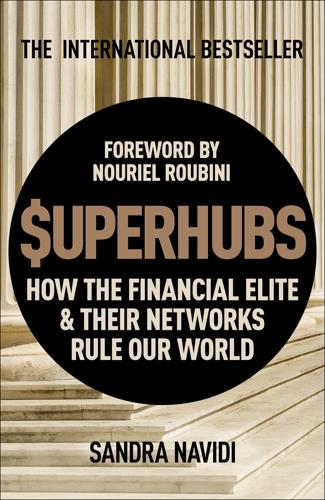
SUPERHUBS: How the Financial Elite and Their Networks Rule Our World
by
Sandra Navidi
Published 24 Jan 2017
Steve Schwarzman and Pete Peterson of Blackstone decided early on not to pursue hostile deals but to instead use their connections to partner with companies in their buyouts.9 Today’s leaders in finance do not have to be born into privilege to make it, although executives from connected families, such as Jamie Dimon, certainly get a head start. Homophily also extends to the choice of spouses with a comparable socioeconomic background in what is called “assortative mating,” the pairing of like with like. Power couples lead prosperous lives, and they further perpetuate income inequality by facilitating their offspring’s advantaged start in life.10 A perfectly just system should be meritocratic, but true meritocracy has proven elusive. In 1995, Newsweek featured a cover story titled “The Rise of the Overclass,” which included numerous Wall Street stars—women and various ethnic groups among them.
…
See also Deutsche Bank at EQT Partners, 144 family of, 136 general references to, 101, 118, 120 International Institute of Finance and, 131 legal charges against, 142–143 Mannesmann AG and, 142–143 Pierre Wauthier suicide and, 138, 144 public relations mistakes by, 143 at Zürich Insurance, 144 “Age of irresponsibility,” 222 Ahamed, Liaquat, 160 AIG, 31, 48, 183–184, 217 Air France, 193 “Airport test,” 80 Albania, 27 Alibada Group, 103 Allen & Company Sun Valley Conference, 112 Alpha personality, 55–58 Alps, 38, 93, 122 Altman, Roger, 121 Alumni networks, 81 Al-Waleed, Prince of Saudi Arabia, 205 Amazon, 199 Amygdala, 98 “Analysis paralysis,” 51 Analytical thinking, 218 Anarchy, 213 Andreessen Horowitz, 189 Anger, 57 Annan, Kofi, 27 Ant colonies, 6 “Anthropocene,” xxvii Apollo Global Management, 88 Appaloosa Management, 88 Arab Spring, 226 Arabella Sheraton Hotel Seehof, 115 Arbitrage traders, 166, 208 Arcadia Conference, 34 Archbishop of Westminster, 226 Aristotle, 79 Arrow, Kenneth, 185 “Ask gap,” 153 Aspen Institute, 112, 200 Assess the Value of Your Networks, 41 Assessment gap, 152–153 “Assortative mating,” 80 Athleticism, 126 Atlantic Council, 158 Avenue Capital Group, 90 AXA, 179 Axel Springer, 136 Azerbaijan, 171 B Babacan, Ali, 120 Bacall, Lauren, 199 Bacon, Louis, 109 Bailouts, 10–11, 216 Bair, Sheila, 56, 150, 168, 172–173, 176, 214 Baker & McKenzie, 154, 159 Banamex Bank, 167 Banco Santander, 121, 148 Bank(s) bailouts of, 10–11, 216 central, xxv, 6, 10, 32–33, 37 CEOs of, 38, 87–88, 174 commercial, 37 description of, xxv investment, 38 postcrisis regulation of, 218 private, 37 private equity firms and, 61 regular, 37 savings, 37 shadow, 38 “too big to fail,” 216 Bank Credit-Dnepr, 195 Bank for International Settlements, 37, 78, 214 Bank of America, 115, 151, 183 Bank of Cyprus, 144–145 Bank of England, xxv, 32, 43, 57, 84, 106, 165, 214–215, 222 Bank of Israel, 36, 84 Bank of New York, 196 Bank One, 65 Banking Conduct and Culture, 223 Banque de France, 39 Barabasi, Albert-László, 19 Barak, Ehud, 9 Barclays, 43, 137, 179, 183, 205 Basel Committee on Banking Supervision, 37 BASF, 115 Bass, Kyle, 154 Baur au Lac Hotel, 38 Bear Stearns, 41, 56–57, 198 Beaux-Arts style, 34 Behavior of networks, 20 Beijing, 103, 194 “Believability index,” 72 “Believability matrices,” 71 Belvédère Hotel, 3, 9, 29 Berkeley Hotel, 43 Berkshire Hathaway, 60 Berlusconi, Silvio, 177–178 Bernanke, Ben annual salary of, 165 as Federal Reserve chairman, 34–37, 188 background on, 36 at Bilderberg conference, 121 in Euro crisis, 177–178 in financial crisis of 2007–2008 management, 11, 36–37, 84, 172 Medley Global Advisors leak and, 43 power of, 35 Princeton University graduation speech by, 50, 80 successor to, 188 Bernstein, Leonard, 199 Beverly Hills Hotel, 192 Bieber, Justin, 67 “Big data analysis” programs, 72 Bild, 136 Bilderberg conference, 120–122 Bilderberg Group, 96, 112 Bilderberg Steering Committee, 142 Billionaires, 123 BIS.
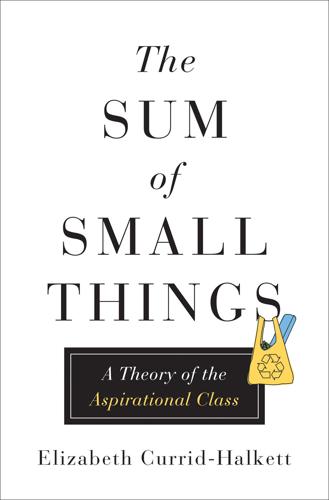
The Sum of Small Things: A Theory of the Aspirational Class
by
Elizabeth Currid-Halkett
Published 14 May 2017
Increasingly, as cities are sites of intellectual production (finance, technology, the arts) rather than industrial production, they are also the nexus where the very skilled end up meeting each other and having kids, thus becoming the ultimate power couples and producing children who grow up to become the same.22 Much of the concern around inequality stems from the social and economic bifurcation between the skilled and the less skilled and the opportunities that exist for them and future generations. The roots of this phenomenon can be traced to the dating market of urban centers (particularly as people marry like, rather than marrying “up” or “down,” a twenty-first-century trend economists term “assortative mating”23). Smart people want to be around other smart people not just for work, but also for friendships and romantic relationships, and over time that results in highly stratified hyper-educated affluent places where, as the economist Tyler Cowen remarked, “Money and talent become clustered in high-powered, two-earner families determined to do everything possible to advance the interests of their children.”24 The social and economic interplay of urban inhabitants enables and promotes cities as the ultimate sites of consumption.
…
AEA (equity firm), 144 age, consumption influenced by, 37, 38t Ahn, Eugene, 122, 137 Ahrendts, Angela, 14 Alaskan Wildlife Refuge, 143 Albert, Prince, 10 Albertson’s, 118 alcohol, 164 Alger, Horatio, 10, 183 Ali, Shimelse, 193–94 alienated labor, 121, 141–42 Alkon, Alison, 124 alternative consumption, 138 American Academy of Pediatrics, 78, 80 American Dream, 175, 182, 183 anxious middle, 183 Armani Exchange (A/X), 11 Arts and Crafts movement, 139–40 Asians, consumption patterns of, 37 aspiration: imitation as means of, 7–8; information availability as spur to, 10 aspirational class: bobos compared to, 19; characteristics and values of, 19, 21–22, 183–84; cities linked to, 148, 151–52; and cost-of-information inconspicuous consumption, 50–60; and cost-prohibitive inconspicuous consumption, 60–62; economic hierarchy within, 19–20; inconspicuous consumption by, 21–22, 49–77; reproduction of, 51–52, 55, 75–77, 185–86, 189–90; rise of, 17–20; social impact of, 185–86 assortive mating, 155 Athletica, 103 attachment parenting, 94 authenticity, 127, 132 Bach, Lydia, 101–2 Bailey, Christopher, 14 Ballet Slippers (nail polish), 46–48, 51, 53 Baltimore, 162, 167 Banana Republic, 11–12 Barber, Elizabeth Wayland, 140 Bare Burger, 123 The Bar Method, 101–2 barre studios, 102–3 Barthes, Roland, 80–81 Baumann, S., 55 Baumol, William, 63–64 beauty and personal grooming care, 171–72 beer, 164 Bell, Daniel, 106 Bennhold, Katrin, 57 Berk, Lotte, 100–101 Berkeley Bowl, 117 Bianchi, Suzanne, 65–66 birthing practices, 92–94 blacks, consumption patterns of, 37 Bluefly, 12 boats and motors, 33, 33f bobos, 18–19, 55–56, 106, 227n3 Boorstin, Daniel, 6, 25–26 Boston, 163–64, 173, 179 bottled water, 164 Bourdieu, Pierre, 3, 48, 53, 55, 59, 177, 224n20 boutiques, 127–28 Bowen, Sarah, 197 Bowman, Elizabeth, 121, 138, 142 brand leaders, 194 Bravo, Rosie Marie, 14 Brazil, 94, 193 breastfeeding, 78–92, 85f, 104–5, 225n6 Brenton, Joslyn, 197 BRIC countries, 193 Bristol, Muriel, 1–2 Brooks, David, 17–19, 55–56, 106 Broome Street General Store, 128 Bucks & Does, 128 Buddhism, 138 Burberry’s, 13–14 Bureau of Labor Statistics, 27 Burt’s Bees, 144 California, food production in, 125–26 Cameron, David, 56 candles, 2–3 capitalism: conspicuous production and, 141; cultural contradictions of, 106–7; Marx’s critique of, 141–42; reactions against, 139–40 Capote, Truman, 10 Carlin, George, 182 Carney, Kevin, 137 car purchases/sales, 177, 193 Carson, Rachel, Silent Spring, 135 cash contributions, 29 Centers for Disease Control (CDC), 79–80 Century Foundation, 189 CES.
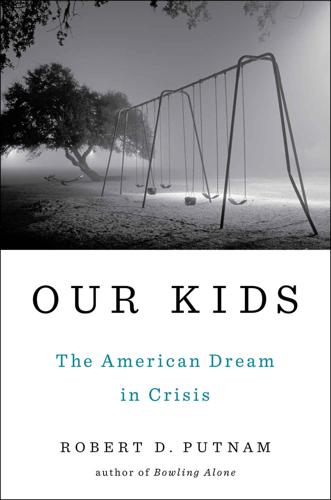
Our Kids: The American Dream in Crisis
by
Robert D. Putnam
Published 10 Mar 2015
Bastedo and Ozan Jaquette, “Running in Place: Low-Income Students and the Dynamics of Higher Education Stratification,” Educational Evaluation and Policy Analysis 33 (September 2011): 318–39; Caroline M. Hoxby and Christopher Avery, “The Missing ‘One-Offs’: The Hidden Supply of High-Achieving, Low Income Students,” NBER Working Paper No. 18586 (Cambridge: National Bureau of Economic Research, December 2012). 41. Robert D. Mare, “Educational Assortative Mating in Two Generations: Trends and Patterns Across Two Gilded Ages” (unpublished manuscript, January 2013). Although I speak loosely here of the two “halves” of the century, in fact the turning point, both for intermarriage rates and for income inequality, came around 1970. 42. This is true even after accounting for the rising number of well-educated potential mates from which to pick.
…
A absolute mobility, 8, 41–43 academic achievement: affluenza and, 139–48 aspirations and, 169 and college success, 184, 276 family background and, 169 as indicator of earnings, 162, 165 K-12 test scores and, 161–62, 246 Low- vs. high-income schools and, 137, 138, 250 poverty and, 148–58 sports and, 175 Acemoglu, Daron, 231 ADHD (Attention Deficit Hyperactivity Disorder), 111, 114, 195–96, 206, 209, 211 advanced placement (AP) classes, 39, 143, 168, 168, 173 Adverse Childhood Experiences Scale, 112–13, 113 affluence: in Atlanta, Ga., 80, 82–92 in Bend, Oreg., 50–54 informal mentoring and, 214–15, 215 in Lower Merion Township, Pa., 192–98, 205–206, 217, 221 neighborhoods and, 217–18, 219 in Orange County, Calif., 135, 139–143, 264–65, 270–71 parental spending and, 125–26, 126 in Port Clinton, Ohio, 5–6, 24–26 savvy gap and, 157, 216 social networks and, 209–10, 209 affordable housing, 251–52 African Americans: affluent, 82–92 educational reform and, 161 in PCHS class of ’59, 12–19 poor, 101–108 see also specific individuals air bags, sociological, 198, 210, 269 alcohol abuse, 55, 93, 102, 106–7, 113, 204 Alger, Horatio, 33 America, two-tiered: class differences and, 34–37, 37 consequences of, 77–79 inequality and, 31–34 marriage and, 40–41 opportunity and, 41–44 reasons for, 72–77 residential segregation and, 38–39, 38 American Dream, 1–45 class disparities in, 6–30 coinage of term, 33 conceptual note on, 44–45 inequality in, 31–34 Port Clinton as embodiment of, 1–2 socioeconomic status and, 189–90 solutions to crisis of, 227–61 two Americas in, 34–44 American economic history, 32–34, 230–31 American Political Science Association, 239 American Revolution, 237 “America’s Technology Highway,” 265 Amy, 198–202, 204–206, 216, 225, 234, 256 Andrew, 49, 50–54, 61, 65, 67, 78, 123, 125, 128, 209, 213, 221, 238 antipoverty programs, 246–47 apprenticeship, 255–56 Arendt, Hannah, 239–40 Army, U.S., 101, 157 Ash, Jay, 261 assortative mating, 40–41 Atlanta, Ga.: affluence in, 80, 82–92 as “Black Mecca,” 81 life stories of, see Carl; Desmond; Elijah; Lauren; Michelle; Simone; Stephanie racial segregation in, 81–83 Austin, Tex., 264, 272 Autobiography (Franklin), 32–33 Autor, David, 35, 231 “Avoid the Stork” campaign, 245–46 B Baby and Child Care (Spock), 117 Bailey, Martha, 185 Belfield, Clive, 232 Bend, Oreg.: affluence in, 50–54 child poverty in, 47–48, 48 economic disparity in, 46–49 housing boom in, 46–47 life stories of, see Andrew; Darleen; Earl; Joe; Kayla; Patty logging industry in, 46 old-timers vs. newcomers in, 46–49 as tourist destination, 264 Bernanke, Ben, 32 Big Brothers Big Sisters, 213 Birmingham, Ala., 270 birth control, see contraception births: cultural shifts and, 73–75 shotgun marriages and, 62 teen, 2, 196, 203–5, 245–46 “Black Mecca,” 81 blended families, 68–71 Boston, Mass., 261, 265 Bowling Alone (Putnam), 211 Boyd, Danah, 212 Brady, Henry, 236 brain development, 109–117, 246 Brown, Margaret Wise, 125–26, 242 Building Strong Families initiative, 244 Bush, George W., 244 Bush, Laura, 130 C California High School Exit Exam (CAHSEE), 156 Carl, 83–86, 88–92, 101, 110, 118, 119–20, 209, 229 Carlson, Marcia, 75 Catholic schools, 84, 201, 254–55 certificate courses, 186 character building, 176 charter schools, 204, 253–54 Chelsea, 2, 24–26, 30, 31, 32, 39, 43, 78, 261, 266 Cherlin, Andrew J., 73 Cheryl, 2, 12–13, 15–19, 30, 213, 274 Chetty, Raj, 228 child care: day care and, 128–30, 248–49 early childhood education and, 153, 249–51 nannies and, 194–95 nonparental, 128–30, 248–49 parental time in, 126–28, 127 spending gap in, 125–26 child development: Adverse Childhood Experiences Scale and, 112–13, 113 autonomy and, 89 brain development in, 109–17, 246 class differences and, 119–20 discipline and, 96–97 family impact on, 79 emotional security and, 115 government policies and, 248–51 neglect and, 111–12 parenting and, 83, 109–17, 129–30, 222, 248–51 poverty and, 116, 122 stages of, 109–10 toxic stress and, 111–14 childhood diabetes, 90–91 childhood obesity, 222–23, 222 child-parent relationships, time and, 126–28, 127 child poverty: in Bend, Oreg., 47–48, 48 brain development and, 116 costs of, 231–32 in Port Clinton, Ohio, 22, 23 child tax credit, 247 churches: Catholic, 84, 192, 193, 201, 254–55 as social networks, 4, 10, 89–90, 193, 201 City University of New York (CUNY), 84, 85 civic engagement, 235–36, 235, 265 Civil Rights movement, 81 Clara, 137, 139–48, 158–59, 164–65, 174, 209, 213, 229 class gap: in 1950s Port Clinton, 6–8 in 21st-century Port Clinton, 19–23 college and, 184–90, 187 consequences of, 77–79 disciplinary suspensions, 170–71, 171 education and, 137, 138, 160–73 extracurricular activities and, 176–78, 177 financial stress and, 130–32, 131 parenting and, 119–22, 120 politics and, 237–38 race and, 161–62 reasons for, 72–77 savvy and, 216 social networks and, 207–10, 208 social trust and, 219–20 in spending, 125–28, 126 Coalition for Community Schools, 254 cognitive skills, 109–11, 115–18, 122, 124–25, 128, 131, 162, 174, 273 cohabitation, 67–68 collective efficacy, 218–19, 221 college: class gap and, 184–90, 187 educational attainment in, 184–90, 189, 190 financing of, 59 parental encouragement and, 8 scholarships and, 8, 14, 17, 141 socioeconomic status and, 189–90 tracking and, 143, 173 Common School movement, 160 community, 191–226 affluence in, 193–98 government policies and, 258–60 mentor support and, 206, 213–17, 215 neighborhood support and, 217–23 poverty in, 198–206 religious support in, 197, 201–4, 223–26 vs. rugged individualism, 206, 261 safety nets in, 132, 206, 229, 246–47, 254, 258–59, 261, 264, 265 social networks and, 206–13 solutions for problems of, 258–60 youth resources in, 206–226 community colleges, 59, 157, 185, 256–58 community schools, 253 computers, 85, 125, 130, 147 brain compared to, 110 concerted cultivation, 101, 118 contingent reciprocity, 110 contraception, 62, 64–65, 73, 196, 245–46 crime: in neighborhoods, 102–3, 199–200 in schools, 153–54, 170 curriculum, 143, 153, 168 D dance classes, 139, 177, 178 Darlene, 54–58, 60, 64, 68, 73–74, 123, 128 David, 2, 26–33, 39, 43, 68, 78, 188, 216, 233, 237, 240, 256, 263, 273 day care: Head Start and, 250 parenting gap and, 128–30, 249 quality of, 248–49 Declaration of Independence, 241 depression, 60, 194 Desmond, 83–92, 118–19, 121, 123, 125, 128, 209, 272–73 Dewey, John, 253 diabetes, childhood, 90–91 Dick, 24, 92 Digital Divide, 211–36 disability payments, 60 discipline, 89, 96, 118–22 in schools, 171 Disneyland, 135, 141, 151, 162 divorce: in 1970s, 62 co-parenting and, 194 and family structure, 61–63, 67, 75, 78, 269 rates of, 21, 67 see also single-parent families domestic violence: child abuse, 93, 105, 106 emotional abuse, 106 physical abuse, 55, 102, 105, 111 spousal abuse, 55, 102 verbal abuse, 105 Don, 3–4, 5, 6, 8, 18, 30, 44, 213, 223, 274 Dr.

The Red Queen: Sex and the Evolution of Human Nature
by
Matt Ridley
Published 14 Aug 1993
we ask of a model’s dull and unsuccessful husband, as if there must be some hidden clue to his worth that the rest of us have missed. ‘How did she manage to catch him?’ we ask of a high-flying man married to an ugly woman. The answer is that we each instinctively know our relative worth as surely as in Jane Austen’s day people knew their place in the class system. Bruce Ellis has a way of showing how we manage this ‘assortative mating’ pattern. He gives each of thirty students a numbered card that they stick on their foreheads: each can now see the other’s number, but nobody knows his or her own. He tells them to pair up with the highest number they can find. Immediately the person with thirty on her forehead is surrounded by a buzzing crowd: so she adjusts her expectations upwards and refuses to pair up with just anybody, settling eventually for somebody with a number in the high twenties.
…
D. and Johnson, K., 1990, ‘Parasites and Mate Choice in Red Junglefowl’, American Zoologist, 30:235–44 Index Abortion, sex-selective, 117, 122 Aché people, 185, 220 Acheulian technology, 314 Adaptation and Natural Selection (Williams), 35 Adapted Mind, The (Barkow, Cosmides, and Tooby), 303 Adrenogenital syndrome, 247 Adultery, 170, 187, 195, 210–36 among birds, 213–16, 219 concealed ovulation and, 222–4 among hunter-gatherers, 220–21 inheritance patterns and, 230–35 jealousy and, 227–30 orgasm effect and, 216–19 polygamy and, 224–7 testicular size and, 211–14 violence and, 196–7 Aeschylus, 197 Affirmative action, 254–5 African Queen, The (film), 199 Aggression, 306–7 gender differences in, 242, 244 Agriculture, 187–8 AIDS, 68, 72, 73, 99, 175 Aka pygmies, 187 Akhenaten, 191, 273 Albatrosses, 177 Alexander, Richard, 319–20, 322 Alliance theory, 276 Altitude, 76–7 Altmann, Jeanne, 113 Altruism, 34–6, 74 reciprocal, 187, 189 Anaxagoras, 115 Anderson, Roy, 81 Antony and Cleopatra (Shakespeare), 10–11 Anthropology, 4, 266, 307, 308 Antibiotics, 68 Antibodies, 71, 72 Antigens, 72 Apes exogamy of, 182–3 gender differences in behavior of, 242 mating systems of, 170, 180–81, 205–9 violence among, 195–6 See also Chimpanzees; Gibbons; Gorillas; Orang-utans Aphids, 55, 57 Aquinas, Thomas, 6 Aristotle, 115 Arms race analogies, 65–8, 69 Artificial intelligence, 310 Artificial life, 66–7, 75 Assortative mating pattern, 296 Attractiveness, see Beauty Augustus, 193 Austad, Steven, 111 Austen, Jane, 296, 322 Australian aborigines, 186, 221 Australopithecus afarensis, 183, 300–301, 316–17 Automixis, 37 Aztecs, 191 Baboons, intelligence of, 324–6 Babylon, 191, 199 Bacteria, 63–4, 68, 69, 90–91 antibiotics and, 68 descendants of, 96 fusion and, 98–9, 99–100 male-killing genes in, 103 Badcock, Christopher, 331 Baker, Robin, 216–18 Baldwin, James Mark, 244 Baldwin effect, 312 Bamboo, 77–8 Bangladesh, 198 Barlow, Horace, 321 Basolo, Alexandra, 157 Bateman, A.
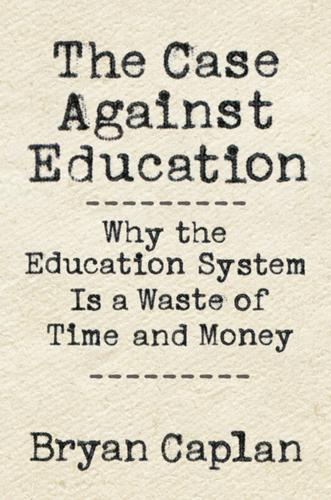
The Case Against Education: Why the Education System Is a Waste of Time and Money
by
Bryan Caplan
Published 16 Jan 2018
Paternoster, Raymond, Shawn Bushway, Robert Brame, and Robert Apel. 2003. “The Effect of Teenage Employment on Delinquency and Problem Behaviors.” Social Forces 82 (1): 297–335. Pellizzari, Michele. 2010. “Do Friends and Relatives Really Help in Getting a Good Job?” Industrial and Labor Relations Review 63 (3): 494–510. Pencavel, John. 1998. “Assortative Mating by Schooling and the Work Behavior of Wives and Husbands.” American Economic Review 88 (2): 326–29. Pérez, Ruth, and Gerardo Loera. 2015. “Los Angeles Unified School District Reference Guide REF-4236.11.” Last modified June 22. http://notebook.lausd.net/pls/ptl/docs/page/ca_lausd/fldr_organizations/fldr_instructional_svcs/ref-4236.11.pdf.
…
Boston: Center for Labor Market Studies Publications. http://www.northeastern.edu/clms/wp-content/uploads/The_Consequences_of_Dropping_Out_of_High_School.pdf. Sweeney, Megan. 2002. “Two Decades of Family Change: The Shifting Economic Foundations of Marriage.” American Sociological Review 67 (1): 132–47. Sweeney, Megan, and Maria Cancian. 2004. “The Changing Importance of White Women’s Economic Prospects for Assortative Mating.” Journal of Marriage and Family 66 (4): 1015–28. Sweet, Donald. 1989. A Manager’s Guide to Conducting Terminations: Minimizing Emotional Stress and Legal Risks. New York: Lexington Books. Sweeten, Gary, Shawn Bushway, and Raymond Paternoster. 2009. “Does Dropping Out of School Mean Dropping into Delinquency?”
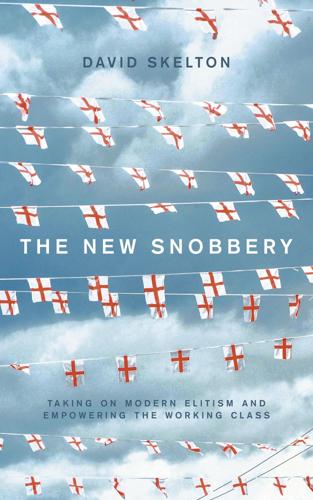
The New Snobbery
by
David Skelton
Published 28 Jun 2021
As time goes on, educated people are more likely to associate only with other educated people, to live in the same parts of town as other graduates, to marry other educated people and to pass on their advantages to their children. In this way, university education and the social capital and respect it brings with it has become almost a birthright of the professional class. Academics call this process ‘assortative mating’ or ‘associative mating’, which, as cultural commentator David Brooks has pointed out, has meant that marriage announcements in major newspapers have started to look like law firm mergers. A number of studies have shown that recent decades have been marked by a decline in marriages across educational divides and that this might also have contributed to a rise in income inequality.
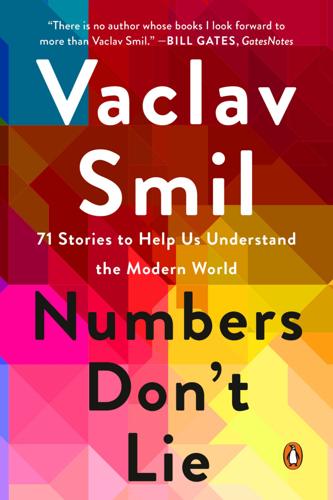
Numbers Don't Lie: 71 Stories to Help Us Understand the Modern World
by
Vaclav Smil
Published 4 May 2021
The second-oldest supercentenarian died at 119, in 1999, and since that time there have been no survivors beyond the 117th year. And if you think that you have a high chance to make it to 100 because some of your ancestors lived that long, you should know that the estimated heritability of lifespan is modest, between 15 and 30 percent. Given that people tend to marry others like themselves—a phenomenon known as assortative mating—the true heritability of human longevity is probably even lower than that. Of course, as with all complex matters, there is always room for different interpretations of published statistical analyses. Kurzweil hopes that dietary interventions and other tricks will extend his own life until major scientific advances can preserve him forever.
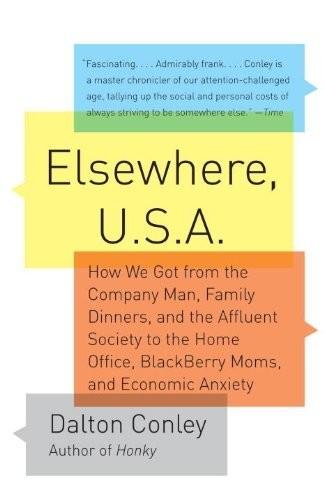
Elsewhere, U.S.A: How We Got From the Company Man, Family Dinners, and the Affluent Society to the Home Office, BlackBerry Moms,and Economic Anxiety
by
Dalton Conley
Published 27 Dec 2008
Instead of waiting on their own husband and kids, many women without college degrees wait on your kids. (Waitressing is, in fact, the number one profession for women without a college education.)40 This story of women’s rising labor force participation has the potential to increase economic inequality when it combines with what demographers call assortative mating—otherwise known as like-marrying-like. That is, since 1967, the demographer Christine Schwartz demonstrates that among two-earner couples, the similarity in their wages has risen by about threefold. In other words, whereas women used to look for good earners to marry, now men do so, too. What’s more, in the 1960s, when a husband earned more money, it usually meant that his wife didn’t have to work (or was less likely to).
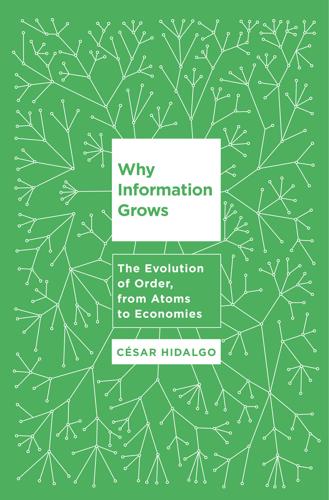
Why Information Grows: The Evolution of Order, From Atoms to Economies
by
Cesar Hidalgo
Published 1 Jun 2015
,” American Political Science Review 99, no. 2 (2005): 153–167; Carolyn L. Funk et al., “Genetic and Environmental Transmission of Political Orientations,” Political Psychology 34, no. 6 (2013): 805–819; Christian Kandler, Wiebke Bleidorn, and Rainer Riemann, “Left or Right? Sources of Political Orientation: The Roles of Genetic Factors, Cultural Transmission, Assortative Mating, and Personality,” Journal of Personality and Social Psychology 102, no. 3 (2012): 633. For papers focusing on genetics and political participation, see James H. Fowler, Laura A. Baker, and Christopher T. Dawes, “Genetic Variation in Political Participation,” American Political Science Review 102, no. 2 (2008): 233–248; James H.
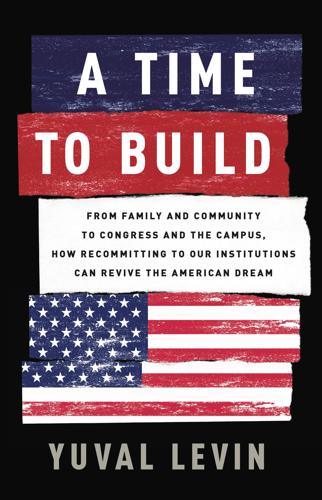
A Time to Build: From Family and Community to Congress and the Campus, How Recommitting to Our Institutions Can Revive the American Dream
by
Yuval Levin
Published 21 Jan 2020
And a merit-based system cannot avoid the simple and unchangeable fact that an elite is inherently narrow and exclusive. In fact, our meritocracy has not even been able to avoid the tendency of elites to become outright aristocracies—that is, to transmit privilege generationally. Thanks to both assortative mating and the powerful incentives to game the tests that grant entry into the American elite, children whose parents are in the upper echelons of our society have a very strong (and growing) chance of finding themselves in those upper echelons as adults. Moving from the WASP near-aristocracy to our meritocracy vastly enlarged the pool of potential elites in America in the middle of the last century.
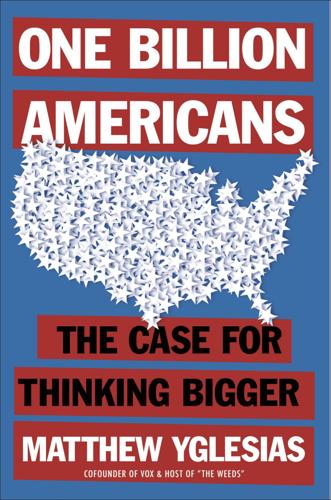
One Billion Americans: The Case for Thinking Bigger
by
Matthew Yglesias
Published 14 Sep 2020
A place full of educated professionals is, by definition, a place that has many different places where white-collar professionals work. So if that new job in Austin doesn’t work out or if candidates simply want the flexibility to make career moves during the years to come, there are probably more other opportunities there than in Toledo. Many people have spouses. These days there’s a phenomenon called assortative mating, which occurs when people choose partners similar to themselves—for example, college graduates tend to marry other college graduates. Given that, it’s much easier for you to seize a new white-collar professional job opportunity if it’s in a city where your spouse is likely to be able to find his own white-collar professional job opportunity.

Come and Take It: The Gun Printer's Guide to Thinking Free
by
Cody Wilson
Published 10 Oct 2016
“There’s this insistence on mocking the religious for not thinking of humans as evolved animals,” he told me, “but then this denial that any of the lessons of evolutionary neurobiology might apply to our observed differences.” He approached political problems pragmatically. Like Lenin, he knew politics simply meant who does what to whom. “As long as you understand the formula, you can achieve the right result.” He compared the USG to Whitman’s multitude, and taught me the virtues of assortative mating. “Take me, for example. I’ll be marrying a Chinese woman with an IQ of one seventy.” When I pointed out to Varol that his strategy might lead to social segregation, he didn’t disagree. He was about triangulating, understanding the big picture, and finding an exit. “Journalists and dot gov have this odd standoff.
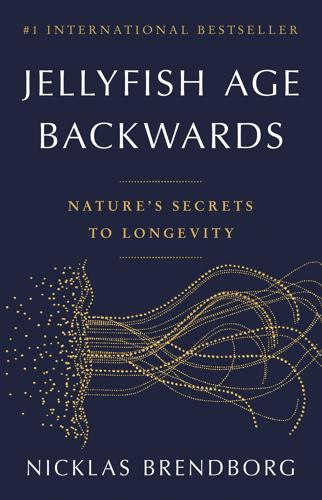
Jellyfish Age Backwards: Nature's Secrets to Longevity
by
Nicklas Brendborg
Published 17 Jan 2023
‘The effect of genetic factors for longevity: A comparison of identical and fraternal twins in the Swedish Twin Registry’, Journals of Gerontology, Series A: Biological Sciences and Medical Sciences, vol. 53, no. 6, 1998, pp. M441–M446. Graham Ruby, J. et al. ‘Estimates of the heritability of human longevity are substantially inflated due to assortative mating’, Genetics, vol. 210, no. 3, 2018, pp. 1109–1124. Melzer, D., Pilling, L.C., Ferrucci, L. ‘The genetics of human ageing’, Nature Reviews Genetics, vol. 21, 2020, pp. 88–101. Timmers, P. et al. ‘Genomics of 1 million parent lifespans implicates novel pathways and common diseases and distinguishes survival chances’, eLife, vol. 8, 2019.
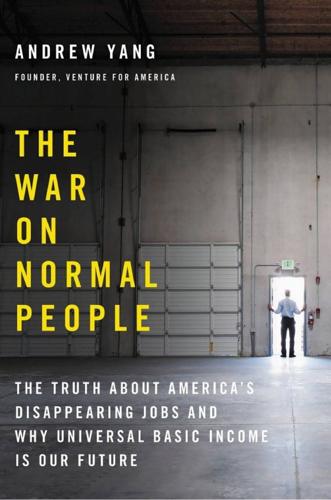
The War on Normal People: The Truth About America's Disappearing Jobs and Why Universal Basic Income Is Our Future
by
Andrew Yang
Published 2 Apr 2018
When I was growing up, there was something of an inverse relationship between being smart and being good-looking. The smart kids were bookish and awkward and the social kids were attractive and popular. Rarely were the two sets of qualities found together in the same people. The nerd camps I went to looked the part. Today, thanks to assortative mating in a handful of cities, intellect, attractiveness, education, and wealth are all converging in the same families and neighborhoods. I look at my friends’ children, and many of them resemble unicorns: brilliant, beautiful, socially precocious creatures who have gotten the best of all possible resources since the day they were born.
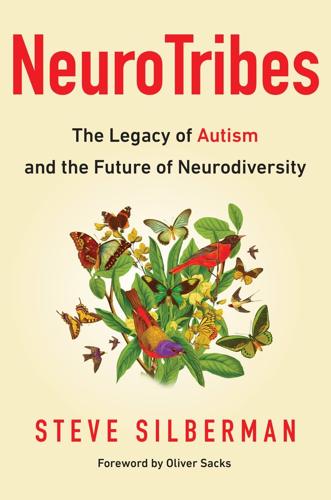
NeuroTribes: The Legacy of Autism and the Future of Neurodiversity
by
Steve Silberman
Published 24 Aug 2015
Temple Grandin observed in Thinking in Pictures, “Marriages work out best when two people with autism marry or when a person marries a handicapped or eccentric spouse . . . They are attracted because their intellects work on a similar wavelength.” Attraction between people with similar genetic traits is called assortative mating. In 1997, cognitive psychologist Simon Baron-Cohen found that the fathers and grandfathers of children with autism were more likely to be engineers. Could assortative mating between men and women carrying the genes for autism be responsible for the rising number of diagnoses in the Valley? My story exploring that hypothesis, “The Geek Syndrome,” was published in the December issue of Wired in 2001.
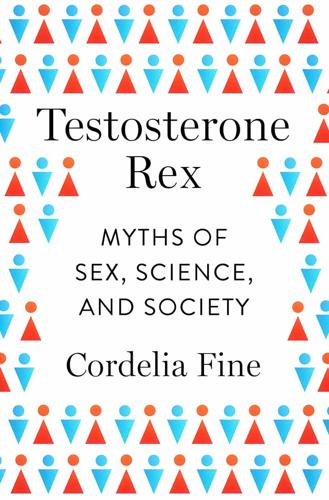
Testosterone Rex: Myths of Sex, Science, and Society
by
Cordelia Fine
Published 13 Jan 2017
Wood & Eagly (2013), ibid. Quoted on p. 245, references removed. See Sweeney, M. M. (2002). Two decades of family change: The shifting economic foundations of marriage. American Sociological Review, 67(1), 132–147; Sweeney, M. M., & Cancian, M. (2004). The changing importance of white women’s economic prospects for assortative mating. Journal of Marriage and Family, 66(4), 1015–1028. 39. Buston, P. M., & Emlen, S. T. (2003). Cognitive processes underlying human mate choice: The relationship between self-perception and mate preference in Western society. Proceedings of the National Academy of Sciences, 100(15), 8805–8810. 40.
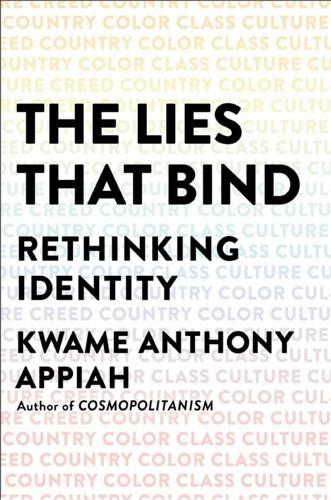
The Lies That Bind: Rethinking Identity
by
Kwame Anthony Appiah
Published 27 Aug 2018
In a footnote attached to the first use of this word, Young’s sociologist of the future writes: “The origin of this unpleasant term, like that of ‘equality of opportunity,’ is still obscure. It seems to have been first generally used in the sixties of the last century in small-circulation journals attached to the Labour Party, and gained wide currency much later on.” 43.Ibid., 85–86. Young’s mention of intraelite intermarriage has support from recent economic research into assortative mating. See, e.g., Gustaf Bruze, “Male and Female Marriage Returns to Schooling,” International Economic Review (January 23, 2015), which finds that in Denmark, half the financial rewards of college come from the opportunity to marry a spouse with a higher income; and John Mare, “Educational Homogamy in Two Gilded Ages: Evidence from Intergenerational Social Mobility Data,” Annals of the American Academy of Political and Social Science 663 (January 2016). 44.Barry E.
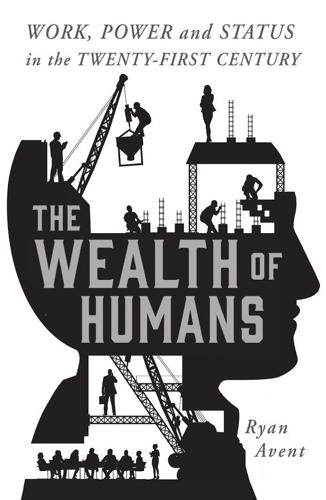
The Wealth of Humans: Work, Power, and Status in the Twenty-First Century
by
Ryan Avent
Published 20 Sep 2016
These rich friends gather for after-work drinks, enjoy dinner parties or holidays together, chat while waiting together to pick up kids after school or on the sidelines at their children’s football match, and generally interact in friendly ways. Networks of the current and aspiring 1 percenters have become richer and more important over the last generation as a result of the rise in assortative mating: skilled, well-paid men are more likely to marry skilled, well-paid women than was once the case. High-powered couples befriend other high-powered couples and hang out in high-powered groups. This sounds sterile and pernicious. It generally isn’t. For the most part, these are people making their way in the world, befriending and coupling with others that they find interesting or funny or nice to be around, and watching friends and neighbours for cues on how to behave: how to structure a social life, how to get one’s children into good schools, how to live the ‘good life’.
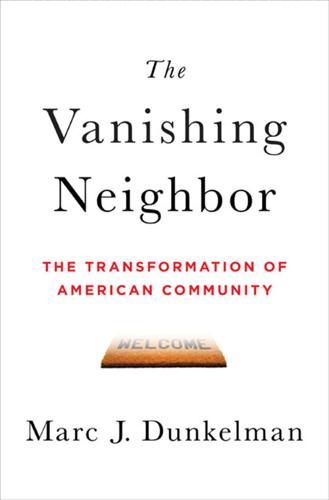
The Vanishing Neighbor: The Transformation of American Community
by
Marc J. Dunkelman
Published 3 Aug 2014
American Review of Sociology 35 (2009): 445. 14“Trends in American Values: 1987–2012: Partisan Polarization Surges in Bush, Obama Years,” Pew Research Center for the People and the Press, June 4, 2012, 72–74. 15“Changing Views of Gay Marriage: A Deeper Analysis,” Pew Research Center for People and the Press, May 23, 2012, http://www.people-press.org/2012/05/23/changing-views-of-gay-marriage-a-deeper-analysis/. 16“Inspire Hope Change,” pamphlet published by the It Gets Better Project, accessed December 12, 2013. 17Robert D. Mare, “Five Decades of Educational Assortative Mating,” American Sociological Review 56, no. 1 (1991): 15–32, in Christine R. Schwartz and Robert D. Mare, “Trends in Educational Assortative Marriage from 1940 to 2003,” California Center for Population Research, July 2005, 4. 18Schwartz and Mare, “Trends in Educational Assortative Marriage From 1940 to 2003,” 20, 23–24. 19Theda Skocpol, Diminished Democracy: From Membership to Management in American Civic Life (Norman: University of Oklahoma Press, 2003), 163–71. 20Skocpol, Diminished Democracy, 158. 21Robert D.
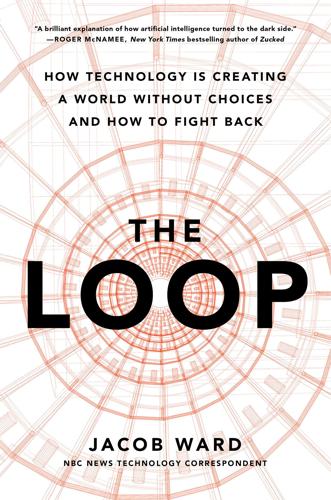
The Loop: How Technology Is Creating a World Without Choices and How to Fight Back
by
Jacob Ward
Published 25 Jan 2022
The ability to plan an environment that will keep my great-grandchildren alive and happy enough to reproduce with the great-grandchildren of my colleagues is an entirely separate matter. Think of the logistics: How will we create new clothes a thousand years after the first boxes of cloth have collapsed and moldered away? Think of nutrition: What crop lasts even 100 years, much less 100,000 years? And relationships: Will assortative mating, the natural tendency to band together with people that most resemble us, continue onboard, cutting into the genetic diversity of offspring and wiping out that bloodline after a few succeeding generations? (Speaking of factions, I have half a screenplay written about the tribal nightmare that such a ship might become.
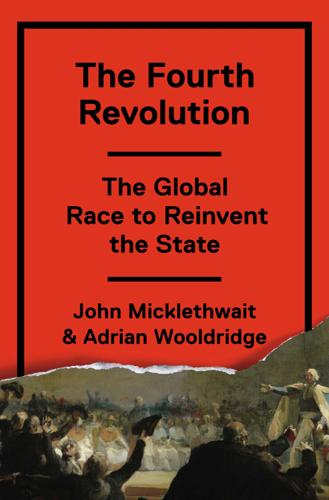
The Fourth Revolution: The Global Race to Reinvent the State
by
John Micklethwait
and
Adrian Wooldridge
Published 14 May 2014
San Francisco is probably the most left-wing enclave in the country while the Central Valley is one of the most right-wing. A third of the U.S. Navy’s Pacific Fleet is based in San Diego while San Francisco’s residents have voted to prevent military recruiters from setting up shop in high schools. And this political version of “assortative mating” has been reinforced by gerrymandering, which produces a modern version of eighteenth-century rotten boroughs. The result is that politicians can get their party’s votes only if they appeal to the extremes. The hedonistic Arnold Schwarzenegger became governor only because a recall petition allowed him to bypass the Republican primary process.
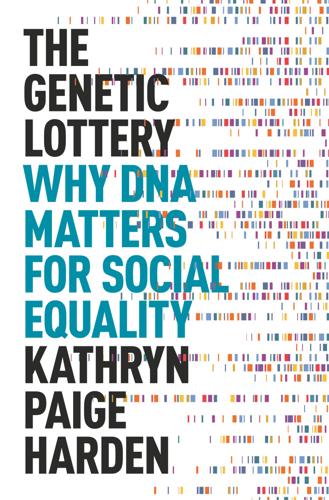
The Genetic Lottery: Why DNA Matters for Social Equality
by
Kathryn Paige Harden
Published 20 Sep 2021
DataSetCode=EAG_EARNINGS. 15. James J. Heckman and Paul A. LaFontaine, “The American High School Graduation Rate: Trends and Levels,” The Review of Economics and Statistics 92, no. 2 (May 2010): 244–62, https://doi.org/10.1162/rest.2010.12366. 16. Jeremy Greenwood et al., “Marry Your Like: Assortative Mating and Income Inequality,” American Economic Review 104, no. 5 (May 2014): 348–53, https://doi.org/10.1257/aer.104.5.348. 17. “Dramatic Increase in the Proportion of Births Outside of Marriage in the United States from 1990 to 2016,” Child Trends (blog), accessed November 5, 2019, https://www.childtrends.org/publications/dramatic-increase-in-percentage-of-births-outside-marriage-among-whites-hispanics-and-women-with-higher-education-levels; T.J.

MegaThreats: Ten Dangerous Trends That Imperil Our Future, and How to Survive Them
by
Nouriel Roubini
Published 17 Oct 2022
Weitzman, “Climate Shock: The Economic Consequences of a Hotter Planet,” (Princeton, NJ, Princeton University Press, 2015) Kindle edition location 901, p. 56. Chapter Eleven 1. “Global Trends 2040: A More Contested World,” A Publication of the National Intelligence Council, March 2021, https://www.dni.gov/files/ODNI/documents/assessments/GlobalTrends_2040.pdf. 2. Ursula Henz and Colin Mills, “Social Class Origin and Assortive Mating in Britain, 1949-2010,” British Sociological Association 52, no. 6 (September 12, 2017), https://journals.sagepub.com/doi/10.1177/0038038517726479#:~:text=Assortative%20mating%20is%20the%20tendency,level%20aspect%20of%20social%20inequality. 3. Walter Scheidel, The Great Leveler (Princeton, NJ: Princeton University Press, 2017), https://books.google.com/books/about/The_Great_Leveler.html?
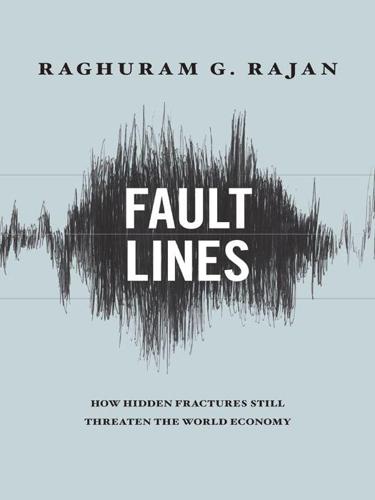
Fault Lines: How Hidden Fractures Still Threaten the World Economy
by
Raghuram Rajan
Published 24 May 2010
A relatively stagnant minimum wage has certainly allowed the lowest real wages to fall (thereby also ensuring that some people who would otherwise be unemployed do have a job), though only a small percentage of American workers are paid the minimum wage. Finally, the entry of women into the workforce has also affected inequality. Because the well-connected and the highly educated tend to mate more often with each other, “assortative” mating has also helped increase household income inequality. The reasons for growing income inequality are, undoubtedly, a matter of heated debate. To my mind, the evidence is most persuasive that the growing inequality I think the most worrisome, the increasing 90/10 differential, stems primarily from the gap between the demand for the highly educated and their supply.

Rise of the Robots: Technology and the Threat of a Jobless Future
by
Martin Ford
Published 4 May 2015
The risk is further increased by the fact that many of these top-tier households are probably more financially fragile than their incomes might suggest. These consumers tend to be concentrated in high-cost urban areas and, in many cases, probably do not feel especially wealthy. Large numbers of them have climbed into the top 5 percent through assortative mating: they have partnered with another high-earning college graduate. However, housing and education costs are often so high for these families that the loss of either job puts the household at substantial risk. In other words, in a two-income household the likelihood that sudden unemployment will lead to a substantial cut in spending is effectively doubled.
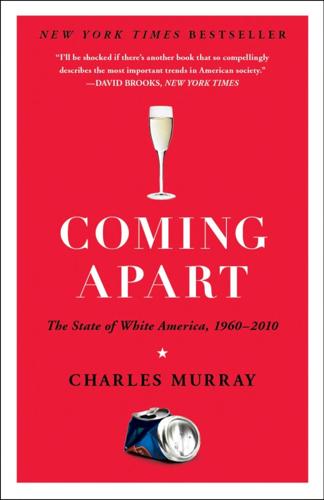
Coming Apart: The State of White America, 1960-2010
by
Charles Murray
Published 1 Jan 2012
Religion, disability, depression, and the timing of death. American Journal of Sociology 97 (4):1052–79. Jensen, Arthur R. 1998. The g Factor: The Science of Mental Ability. Westport, CT: Praeger. Kalmijn, Matthijs. 1998. Intermarriage and homogamy: Causes, patterns, trends. Annual Review of Sociology 24:395–421. ———. 1994. Assortative mating by cultural and economic occupational status. American Journal of Sociology 100:422–52. Karlgaard, Richard. 2005. Talent wars. Forbes, October 31. Koenig, Harold G., Michael E. McCullough, and David B. Larson. 2001. Handbook of Religion and Health. New York: Oxford University Press. Korenman, Sanders, and David Neumark. 1991.

Plutocrats: The Rise of the New Global Super-Rich and the Fall of Everyone Else
by
Chrystia Freeland
Published 11 Oct 2012
And it is graduates of Yale Law School and the like who are the housewives of the plutocrats. In 1979, nearly 8 percent of the 1 percent had spouses the IRS described as doing blue-collar or service sector jobs—governmentspeak for bosses married to their secretaries. That number has been falling ever since. What economists call assortive mating—the tendency to marry someone you resemble—is on the rise. But while the aggressive geeks of the super-elite are marrying their classmates rather than their secretaries, their highly educated wives are unlikely to work. My own suspicion is that most plutocrats privately believe women don’t make it to the top because something is missing.
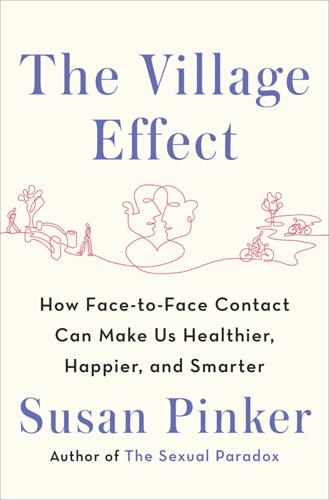
The Village Effect: How Face-To-Face Contact Can Make Us Healthier, Happier, and Smarter
by
Susan Pinker
Published 30 Sep 2013
After running tests in both countries, Huang found that American and Chinese couples who chose to take exactly the same route to work—whether or not they left home at the same time—were the happiest with each other.71 Their matching journeys implied matching goals. This synchrony resonated with the couple as yet another confirmation of their bond. Every seemingly coincidental overlap in their thoughts, habits, or behavior reminded them of what had attracted them to each other in the first place. Like attracts like, homophily, assortative mating, birds of a feather—whatever you want to call it, we know that people who are already similar are drawn to each other. They live in the same neighborhoods, eat the same foods, have similar worries, pray in the same way, and often do business together. The question we’ll explore in the next chapter is whether this magnetic attraction is always a force for good. 9 When Money Really Talks Social Networks, Business, and Crime Located in the good part of town, Mary Coughlan’s living room looks like a cross between a private library and a gallery of Asian and African art.
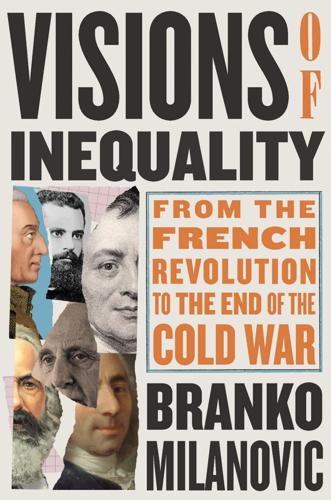
Visions of Inequality: From the French Revolution to the End of the Cold War
by
Branko Milanovic
Published 9 Oct 2023
One important work of that period—not written in such an engaging way or much cited today, but a book that raised issues that have remained with us for decades—was James Meade’s The Just Economy. 76 It deals with income inequality statically and dynamically, and thus introduces the topics of intergenerational transmission of advantages (and disadvantages), endowments, and assortative mating. Meade also tries to bridge the (methodological) gap between functional and personal income distributions and emphasizes, much more than other authors, the contribution of capital incomes to total inequality. This leads him to advocate workers’ ownership as a way to broaden ownership of financial assets, and thus to break the quasi-automatic relationship between rising capital share and higher interpersonal inequality.

England: Seven Myths That Changed a Country – and How to Set Them Straight
by
Tom Baldwin
and
Marc Stears
Published 24 Apr 2024
Surveys show four-fifths come from well-off professional families, and Oxbridge recruited more students from just eight elite schools, including two in the state sector, than from almost 3,000 comprehensive schools in poorer areas put together.35 When they leave university, Oxford’s graduates largely pursue similar careers, live in similar places and breed with each other in a practice known by sociologists as ‘assortative mating’, which seems to fulfil the worst fears of a self-replicating elite. The journalist Adrian Wooldridge describes the depressing experience of opening the annual newsletter from the Oxford college he attended to read its ‘self-satisfied litany of “all Balliol” marriages and “all Balliol babies” ’.36 Of course, not everyone who studies or studied at Oxford is cut from the same cloth.
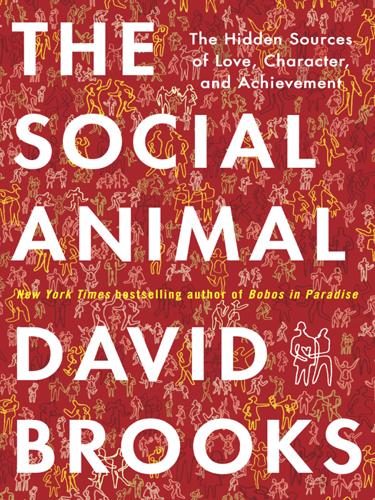
The Social Animal: The Hidden Sources of Love, Character, and Achievement
by
David Brooks
Published 8 Mar 2011
This change in the cognitive load has had many broad effects. It has changed the role of women, who are able to compete equally in the arena of mental skill. It has changed the nature of marriage, as men and women look for partners who can match and complement each other’s mental abilities. It has led to assortative mating, as highly educated people marry each other and less-educated people marry each other. It has also produced widening inequality, so that societies divide into two nations—a nation of those who possess the unconscious skills to navigate this terrain and a nation of those who have not had the opportunity to acquire those skills.

More: The 10,000-Year Rise of the World Economy
by
Philip Coggan
Published 6 Feb 2020
However, the main reason why chief executive pay has risen so far is that their packages have been linked to share options. The rising stock market has done the rest. In Japan, where share prices have struggled, chief executive pay is much lower. But presumably you need to be as talented to run Sony or Toyota as you do to run General Electric or Ford. Another factor is “assortative mating” – well-educated people are increasingly likely to marry each other. In 1960, 25% of men with university degrees married women with the same level of education; in 2005, 48% did.47 And another element has been the decline in trade union membership and the loss of collective bargaining power.
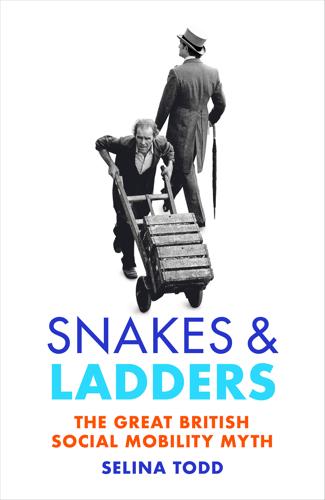
Snakes and Ladders: The Great British Social Mobility Myth
by
Selina Todd
Published 11 Feb 2021
The Waste Land was first published in 1922. 51 There are very few studies of this because social mobility research has focused on occupation and income. Here I have drawn on an early pioneering study by Jerzy Berent, ‘Social Mobility and Marriage’, in David Glass, ed., Social Mobility in Britain, Routledge & Kegan Paul, 1954, chapter 12, and Ursula Benz and Colin Mills, ‘Social Class Origin and Assortative Mating in Britain, 1949–2010’, Sociology, vol. 52, no. 6, pp. 1217–36. 52 On clerks’ desire to marry other clerks see Diana Gittins, Fair Sex: Family Size and Structure, 1900–39, Hutchinson, 1982, pp. 80–6. 53 Stovel, Savage and Bearman, p. 363. 54 Alan McKinlay, ‘Banking, Bureaucracy and the Career: the Curious Case of Mr Notman’, Business History, vol. 55, no. 3, 2013, pp. 431–47. 55 Ibid. 56 John H.
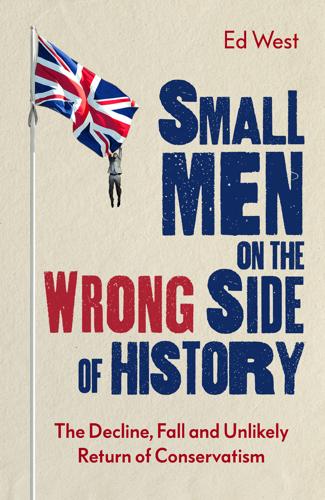
Small Men on the Wrong Side of History: The Decline, Fall and Unlikely Return of Conservatism
by
Ed West
Published 19 Mar 2020
Even our political beliefs are to some extent hereditary.32 A Danish twin study of twelve thousand participants showed that genetics account for about 60 per cent of the variation in political ideology.33 Social attitudes generally have a genetic basis, which is further strengthened because of assortative mating, whereby people increasingly marry those with similar personalities and worldviews.34 Perhaps most startling, and rather depressing, neurologists can predict your political beliefs with 83 per cent accuracy just by examining brain structure.35 According to a study by California, San Diego and Harvard universities, ideology is affected by a dopamine receptor gene called DRD4, but only if they had an active social life in adolescence.36 Likewise where there is ‘evidence of intergenerational transmission of party identification’ it is down to genetic similarities in personality.37 In other words, conscientious conservative parents will pass on those character traits that make their children conservative, too; open-minded liberal parents will pass on those same characteristics to their open-minded liberal children.

The Price of Time: The Real Story of Interest
by
Edward Chancellor
Published 15 Aug 2022
The Obamas later spent nearly $12 million on a summer residence on Martha’s Vineyard. Economists grappled with the ‘inequality crisis’, as it was now styled. The usual suspects were brought out to explain the crisis: taxes, technology, globalization, weak unions, educational disparities and the tendency of rich people to marry among themselves (known as ‘assortative mating’). Inequality, like productivity, is a complex phenomenon influenced by many different factors. Still, it’s striking that ultra-low interest rates didn’t even make it to the line-up. Most inequality experts inclined to the traditional view, which holds that interest is fundamentally unjust.
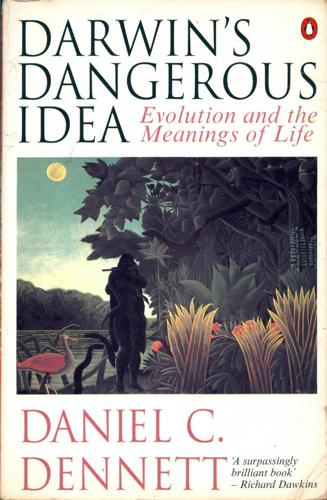
Darwin's Dangerous Idea: Evolution and the Meanings of Life
by
Daniel C. Dennett
Published 15 Jan 1995
But under most circumstances, the "time to be selfish," for genes, is strictly limited, and once the die — or the ballot — is cast, those genes are just along for the ride until the next election.2 Skyrms shows that when the individual elements of a group — whether of whole organisms or their parts — are closely related (clones or near-clones) or are otherwise able to engage in mutual recognition and assortative "mating," the simple game-theory model of the Prisoner's Dilemma, in which the strategy of defection always dominates, does not correctly model the circumstances. That is why our somatic cells don't defect; they are clones. This is one of the conditions under which groups — such as the group of my "host" cells — can have the "harmony and coordination" required to behave, quite stably, as an "organism" or "individual."